The term "congeners" is used here to refer to volatile aromatic chemical compounds which, although they only make up a small part in terms of quantity, determine the taste of the spirits.
Not meant are substances added after distillation, such as sugar or fruit juices.
How these congeners behave during distillation has a significant influence on the final taste. Most important here is their volatility. There is absolute volatility and volatility relative to the volatility of other substances. If in the vapor the proportion of the congener is higher than in the liquid, then the absolute volatility is greater than 1. If it is lower, then the abs. volatility is lower than 1. In scientific writings, this number always refers to the molar ratio. So if the substance has a molar ratio of 0.0001 in the liquid and 0.001 in the vapor, then its volatility is 10. In our calculators, on the other hand, the volatility is usually used in relation to the mass, since this is more descriptive. So if the substance has 0.01 %wt in liquid and 0.1 %wt in vapor, its volatility is 10.
Besides the individual properties of the substance, the volatility depends very much on the alcohol strength. Basically, the less alcohol there is in the solution, the more volatile all flavoring substances are. Here is an example: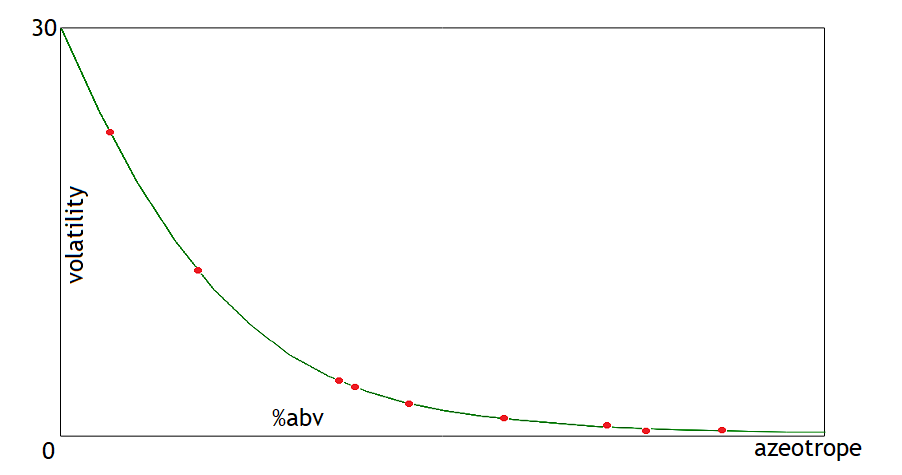 This is the curve of isobutanol.
The red points are the measured values, the green line the curve derived from them.
This is the curve of isobutanol.
The red points are the measured values, the green line the curve derived from them.
For the other congeners the curve looks very similar: It always decreases from left to right and always sags towards the bottom. Depending on the alcohol strength, the abs. volatility of isobutanol in relation to the mole fraction is between 0.38 and 30. This means that in a distillation without alcohol, there is 30 times as much isobutanol in the vapor as in the liquid. And in a distillation with azeotropic alcohol in the still, proportionally in the vapor is almost only 1/3 of the amount of isobutanol as in the liquid. Consequently, the alcohol strength during distillation has a huge impact on the taste.
The measured data assume that the congeners are present in such low concentrations that their molecules do not influence each other. However, this is no longer the case in distillations with high rectification. Therefore, if high rectifications are calculated with these data, too extreme concentrations of the congeners are output for the beginning of the distillation and later for the almost abrupt transition between azeotrope and 0%abv in the distillate. This is therefore a limitation for all our calculators concerning the congeners. The general statements of the calculators, for example, whether a congener concentrates in the foreshots or in the tails, nevertheless remain valid. However, the concentrations in practice are by far not as extreme as calculated by the calculators when using high recification.
The volatility curve of ethanol also looks like this. The volatility at (almost) 0%abv is about 11 and at the azeotrope exactly 1. For our considerations mostly the course of the relative volatility to that of ethanol is interesting. If the congener has an abs. volatility of 10 at a certain alcohol strength and ethanol has an abs. volatility of 2 at the same alcohol strength, the relative volatility of the congener at this alcohol strength is 10 / 2 = 5.
From the course of the relative volatility of the substances, one can recognize their very different behavior during distillation. For example, whether they end up in the foreshots or tails.
However, based on the curves alone, one can only see how the congeners behave at a certain starting point of a distillation. It is not possible to predict later times very well, because it is difficult to estimate how much of the congener is still in the still at a later time when the volatility is then higher because the alcohol content has dropped. So, on the one hand, you then have the higher volatility, but on the other hand, you no longer have the same proportion of the congener in the still. This can only be done by a computer program which calculates the distillation in smallest steps.
It is therefore quite possible that, although its volatility increases, less and less of the congener enters the distillate. This is the case with all typical foreshot compounds. Typical foreshot compounds are those which have a higher volatility than ethanol over the entire alcohol strength range, i.e. a relative volatility higher than 1 everywhere. Typical tails compounds have a lower volatility than ethanol over the entire range, i.e. a relative volatility lower than 1 everywhere. And substances with a lower volatility than water remain more or less in the still. It is more complicated with substances which are more volatile than ethanol at low alcohol strength and less volatile at high alcohol strength. In this case, it depends on the initial alcohol strength and the rectification whether the substance tends to end up in the foreshots or in the tails. At higher alcohols, this is the case.
In the calculators, the congeners are arranged in groups. Within each group, they are ordered by molar mass. Molar mass often correlates with "more extreme" behavior: a higher molar mass usually means a wider range of volatility between 0%abv and the azeotrope, and a stronger aroma. In several of the congener groups, however, there is one congener with a rather low molar mass, which by far exceeds the others in terms of quantity. Here it is then useful to calculate the relative volatility of the other congeners from this congener group to this main substance, as this allows statements to be made about the quality of the spirit.
How these congeners behave during distillation has a significant influence on the final taste. Most important here is their volatility. There is absolute volatility and volatility relative to the volatility of other substances. If in the vapor the proportion of the congener is higher than in the liquid, then the absolute volatility is greater than 1. If it is lower, then the abs. volatility is lower than 1. In scientific writings, this number always refers to the molar ratio. So if the substance has a molar ratio of 0.0001 in the liquid and 0.001 in the vapor, then its volatility is 10. In our calculators, on the other hand, the volatility is usually used in relation to the mass, since this is more descriptive. So if the substance has 0.01 %wt in liquid and 0.1 %wt in vapor, its volatility is 10.
Besides the individual properties of the substance, the volatility depends very much on the alcohol strength. Basically, the less alcohol there is in the solution, the more volatile all flavoring substances are. Here is an example:

For the other congeners the curve looks very similar: It always decreases from left to right and always sags towards the bottom. Depending on the alcohol strength, the abs. volatility of isobutanol in relation to the mole fraction is between 0.38 and 30. This means that in a distillation without alcohol, there is 30 times as much isobutanol in the vapor as in the liquid. And in a distillation with azeotropic alcohol in the still, proportionally in the vapor is almost only 1/3 of the amount of isobutanol as in the liquid. Consequently, the alcohol strength during distillation has a huge impact on the taste.
The measured data assume that the congeners are present in such low concentrations that their molecules do not influence each other. However, this is no longer the case in distillations with high rectification. Therefore, if high rectifications are calculated with these data, too extreme concentrations of the congeners are output for the beginning of the distillation and later for the almost abrupt transition between azeotrope and 0%abv in the distillate. This is therefore a limitation for all our calculators concerning the congeners. The general statements of the calculators, for example, whether a congener concentrates in the foreshots or in the tails, nevertheless remain valid. However, the concentrations in practice are by far not as extreme as calculated by the calculators when using high recification.
The volatility curve of ethanol also looks like this. The volatility at (almost) 0%abv is about 11 and at the azeotrope exactly 1. For our considerations mostly the course of the relative volatility to that of ethanol is interesting. If the congener has an abs. volatility of 10 at a certain alcohol strength and ethanol has an abs. volatility of 2 at the same alcohol strength, the relative volatility of the congener at this alcohol strength is 10 / 2 = 5.
From the course of the relative volatility of the substances, one can recognize their very different behavior during distillation. For example, whether they end up in the foreshots or tails.
However, based on the curves alone, one can only see how the congeners behave at a certain starting point of a distillation. It is not possible to predict later times very well, because it is difficult to estimate how much of the congener is still in the still at a later time when the volatility is then higher because the alcohol content has dropped. So, on the one hand, you then have the higher volatility, but on the other hand, you no longer have the same proportion of the congener in the still. This can only be done by a computer program which calculates the distillation in smallest steps.
It is therefore quite possible that, although its volatility increases, less and less of the congener enters the distillate. This is the case with all typical foreshot compounds. Typical foreshot compounds are those which have a higher volatility than ethanol over the entire alcohol strength range, i.e. a relative volatility higher than 1 everywhere. Typical tails compounds have a lower volatility than ethanol over the entire range, i.e. a relative volatility lower than 1 everywhere. And substances with a lower volatility than water remain more or less in the still. It is more complicated with substances which are more volatile than ethanol at low alcohol strength and less volatile at high alcohol strength. In this case, it depends on the initial alcohol strength and the rectification whether the substance tends to end up in the foreshots or in the tails. At higher alcohols, this is the case.
In the calculators, the congeners are arranged in groups. Within each group, they are ordered by molar mass. Molar mass often correlates with "more extreme" behavior: a higher molar mass usually means a wider range of volatility between 0%abv and the azeotrope, and a stronger aroma. In several of the congener groups, however, there is one congener with a rather low molar mass, which by far exceeds the others in terms of quantity. Here it is then useful to calculate the relative volatility of the other congeners from this congener group to this main substance, as this allows statements to be made about the quality of the spirit.
The congener groups and respective comparative substances:
Aldehydes, main substance acetaldehyde:
Aldehydes are very volatile, light odors. The further down the table, the more intense and complex the aroma of the aldehydes. Aldehydes have a good aroma only from valeraldehyde or perhaps already from butanal downwards. Aldehydes are mostly very volatile substances. The volatility relative to ethanol is usually very high. Therefore, they are usually found in the foreshots or heads. Acetaldehyde is by far the most common aldehyde and is an unpleasant, one-dimensional flavor. With high rectification, it is possible to concentrate and cut the acetaldehyde in the foreshots but retain higher-value aldehydes to some extent.
Esters, main substance ethylacetate:
Esters are fruity flavors that tend to be highly volatile. However, by far the most common ester, ethylacetate, with its low molar mass, tends to have an unpleasant, one-dimensional solvent odor. The further down the table, the more intense, complex and better the aroma of the esters. Even the second congener from the top has a much better quality than the ethylacetate. With high rectification, it is possible to concentrate and cut the ethylacetate in the foreshots but retain higher quality esters to some extent. Some very high quality esters need low alcohol strength and little or no rectification to avoid retention in the boiler.
Acids, main substance acetic acid:
Acids are basically unpleasant congeners. By far the most common is acetic acid. This is mainly responsible for giving the tails a harsh mouthfeel. If a distillate is not soft, it is usually due to it. The acids with higher molar mass have a extreme unpleasant smell. In general, therefore, a distillate with as few acids as possible is better. With rectification, acids can be separated very well with the tails or stillage. If the other acids are reduced relative to the acetic acid in the hearts, this theoretically has beneficial effects, but usually it is of little consequence. However, esters can be formed from acids. And the acids further down the list form the more interesting esters than the acids further up. So it may well make sense to take rather the lower acids with you in the stripping run to give their esterification more opportunities, and then only try to generally reduce the acids in the last distillation. However, this is not as possible as one might like: If one ends the stripping run earlier, the stripping run will generally have fewer acids and rather a lot of the acids with high molar mass. So in the spirit run, you will get few esters, but they will tend to be of higher quality. In addition, you will either get a very soft distillate or a high hearts yield. If, however, you want a distillate with a high ester content, you have to collect much distillate at the stripping run and then have, firstly, mainly low-value esters, which have to be separated well with the fores, and secondly, an acid content that either makes the distillate very unsoft or forces a very early hearts end and thus a poor hearts yield. And this is relatively independent of initial alcohol strength or rectification. The path to a complex spirit with many and higher-value esters must therefore be taken beforehand during fermentation. That one therefore promotes organisms there, which produce higher-value acids.
Alcohols, the main substance being ethanol itself:
The only edible alcohol with a low molar mass is ethanol. Methanol smells similar to ethanol. The others more or less like solvent or fusel-like. Although the more valuable substances are lower down the table, only the lowest three can be considered beneficial. So one should rather try to separate the other alcohols during distillation. Depending on the distillation method, here this can be in the foreshots/heads or tails. The higher the alcohol strength or rectificaton, the more likely the alcohols will collect in the tails. Except for methanol, where it is the other way around. This is because it is the only alcohol with a smaller molar mass than ethanol. But just as with the acids, the alcohols can esterify and the alcohols further down form the more interesting esters, which is why it can make sense to separate the alcohols only during the spirit run. Here, too, it is better to lay the foundation for higher-value alcohols during fermentation.
Other congeners, no main substance:
They are also sorted according to their molar mass, but this has no significance here. Acetone clearly does not have a good aroma, but does not play a major role in our distillates. With diacetyl it is a question of taste and quantity. Phenol is rather interesting only for peated distillates. The other congeners are good. However, they are special congeners with citrus aromas, which do not appear noticeably in most of our spirits. But they belong to the group of terpenes, which can have quite diverse aromas and often play a major role in aromatic distillates. So these calculated values can also be interesting for spirits without citrus aromas.
Aldehydes, main substance acetaldehyde:
Aldehydes are very volatile, light odors. The further down the table, the more intense and complex the aroma of the aldehydes. Aldehydes have a good aroma only from valeraldehyde or perhaps already from butanal downwards. Aldehydes are mostly very volatile substances. The volatility relative to ethanol is usually very high. Therefore, they are usually found in the foreshots or heads. Acetaldehyde is by far the most common aldehyde and is an unpleasant, one-dimensional flavor. With high rectification, it is possible to concentrate and cut the acetaldehyde in the foreshots but retain higher-value aldehydes to some extent.
Esters, main substance ethylacetate:
Esters are fruity flavors that tend to be highly volatile. However, by far the most common ester, ethylacetate, with its low molar mass, tends to have an unpleasant, one-dimensional solvent odor. The further down the table, the more intense, complex and better the aroma of the esters. Even the second congener from the top has a much better quality than the ethylacetate. With high rectification, it is possible to concentrate and cut the ethylacetate in the foreshots but retain higher quality esters to some extent. Some very high quality esters need low alcohol strength and little or no rectification to avoid retention in the boiler.
Acids, main substance acetic acid:
Acids are basically unpleasant congeners. By far the most common is acetic acid. This is mainly responsible for giving the tails a harsh mouthfeel. If a distillate is not soft, it is usually due to it. The acids with higher molar mass have a extreme unpleasant smell. In general, therefore, a distillate with as few acids as possible is better. With rectification, acids can be separated very well with the tails or stillage. If the other acids are reduced relative to the acetic acid in the hearts, this theoretically has beneficial effects, but usually it is of little consequence. However, esters can be formed from acids. And the acids further down the list form the more interesting esters than the acids further up. So it may well make sense to take rather the lower acids with you in the stripping run to give their esterification more opportunities, and then only try to generally reduce the acids in the last distillation. However, this is not as possible as one might like: If one ends the stripping run earlier, the stripping run will generally have fewer acids and rather a lot of the acids with high molar mass. So in the spirit run, you will get few esters, but they will tend to be of higher quality. In addition, you will either get a very soft distillate or a high hearts yield. If, however, you want a distillate with a high ester content, you have to collect much distillate at the stripping run and then have, firstly, mainly low-value esters, which have to be separated well with the fores, and secondly, an acid content that either makes the distillate very unsoft or forces a very early hearts end and thus a poor hearts yield. And this is relatively independent of initial alcohol strength or rectification. The path to a complex spirit with many and higher-value esters must therefore be taken beforehand during fermentation. That one therefore promotes organisms there, which produce higher-value acids.
Alcohols, the main substance being ethanol itself:
The only edible alcohol with a low molar mass is ethanol. Methanol smells similar to ethanol. The others more or less like solvent or fusel-like. Although the more valuable substances are lower down the table, only the lowest three can be considered beneficial. So one should rather try to separate the other alcohols during distillation. Depending on the distillation method, here this can be in the foreshots/heads or tails. The higher the alcohol strength or rectificaton, the more likely the alcohols will collect in the tails. Except for methanol, where it is the other way around. This is because it is the only alcohol with a smaller molar mass than ethanol. But just as with the acids, the alcohols can esterify and the alcohols further down form the more interesting esters, which is why it can make sense to separate the alcohols only during the spirit run. Here, too, it is better to lay the foundation for higher-value alcohols during fermentation.
Other congeners, no main substance:
They are also sorted according to their molar mass, but this has no significance here. Acetone clearly does not have a good aroma, but does not play a major role in our distillates. With diacetyl it is a question of taste and quantity. Phenol is rather interesting only for peated distillates. The other congeners are good. However, they are special congeners with citrus aromas, which do not appear noticeably in most of our spirits. But they belong to the group of terpenes, which can have quite diverse aromas and often play a major role in aromatic distillates. So these calculated values can also be interesting for spirits without citrus aromas.
The normally very low pH in mashes increases the volatility of acids.
This means that, in practice, the acids will end up in the distillate somewhat earlier than calculated in the case of stripping runs.
Chemical reactions take place during distillation. Some molecules combine, others separate. Our Calculators cannot calculate this. For example, a noticeable esterification usually takes place. In this, acids and alcohols combine to form esters. So acids and alcohols disappear from the calculation and esters are added.
Because of these and probably other differences between theory and practice, the calculators that use our congener data are less suitable for absolute calculations, but rather for comparative ones. This means that one can not so much have a concrete cut point calculated, but rather compare scenarios and then make general statements. In this way, answers to many important questions can be found. Here are examples using our calculators:
The order is random.
Chemical reactions take place during distillation. Some molecules combine, others separate. Our Calculators cannot calculate this. For example, a noticeable esterification usually takes place. In this, acids and alcohols combine to form esters. So acids and alcohols disappear from the calculation and esters are added.
Because of these and probably other differences between theory and practice, the calculators that use our congener data are less suitable for absolute calculations, but rather for comparative ones. This means that one can not so much have a concrete cut point calculated, but rather compare scenarios and then make general statements. In this way, answers to many important questions can be found. Here are examples using our calculators:
Is methanol in the foreshots?
It is now generally known that methanol does not concentrate in the foreshots or heads.
E.g. with the Congeners Simulator 1 you can check it:
5%abv in the boiler, 1 theor. plate, zoom x3: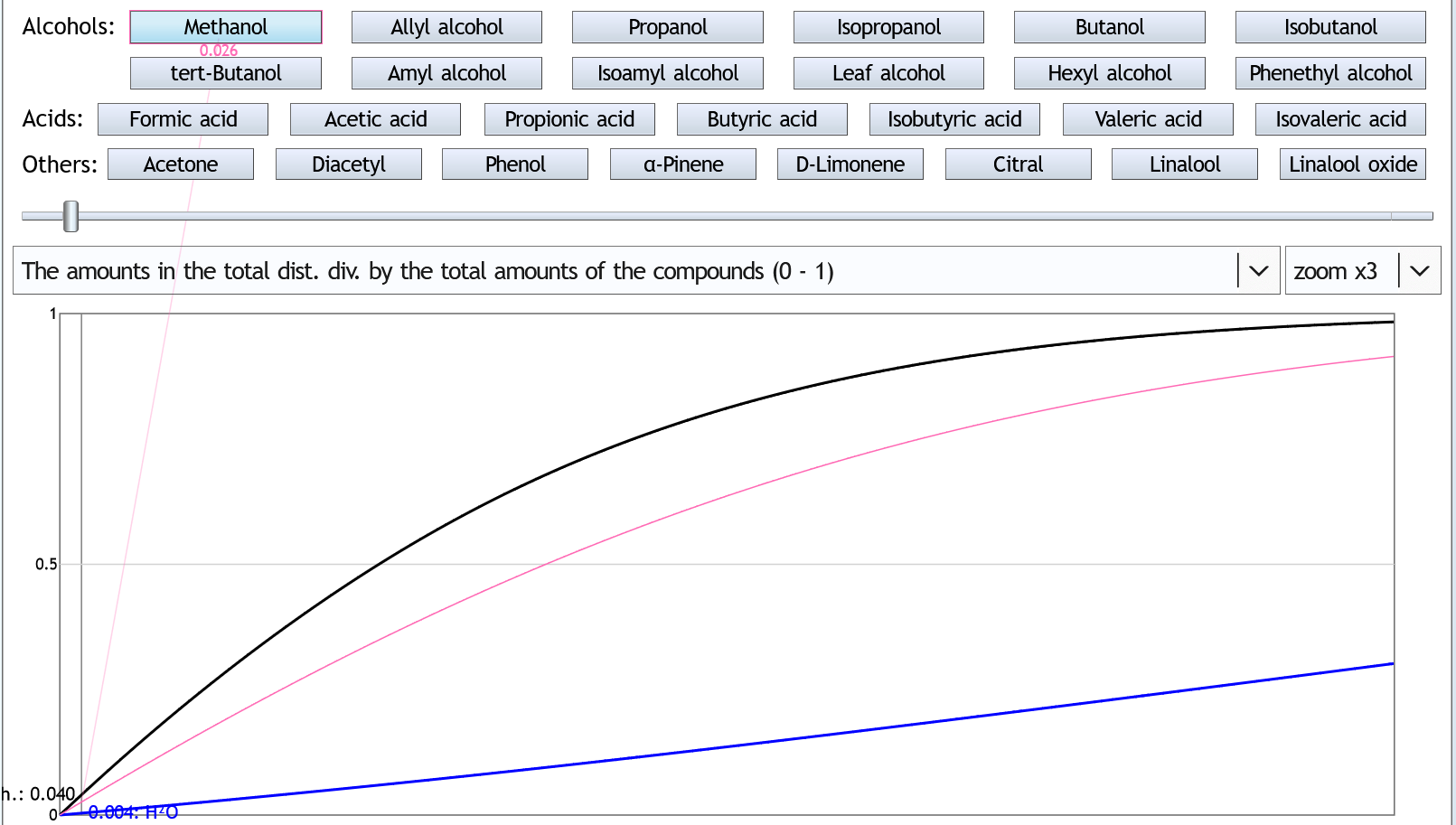 The curve of methanol (pink) is below that of ethanol (black).
So methanol evaporates slower than ethanol.
If you remove 4% (0.04) of the ethanol as foreshots, you have removed only 2.6% (0.026) of the methanol.
The curve of methanol (pink) is below that of ethanol (black).
So methanol evaporates slower than ethanol.
If you remove 4% (0.04) of the ethanol as foreshots, you have removed only 2.6% (0.026) of the methanol.
If you stop this stripping run after 25% of the boiler content: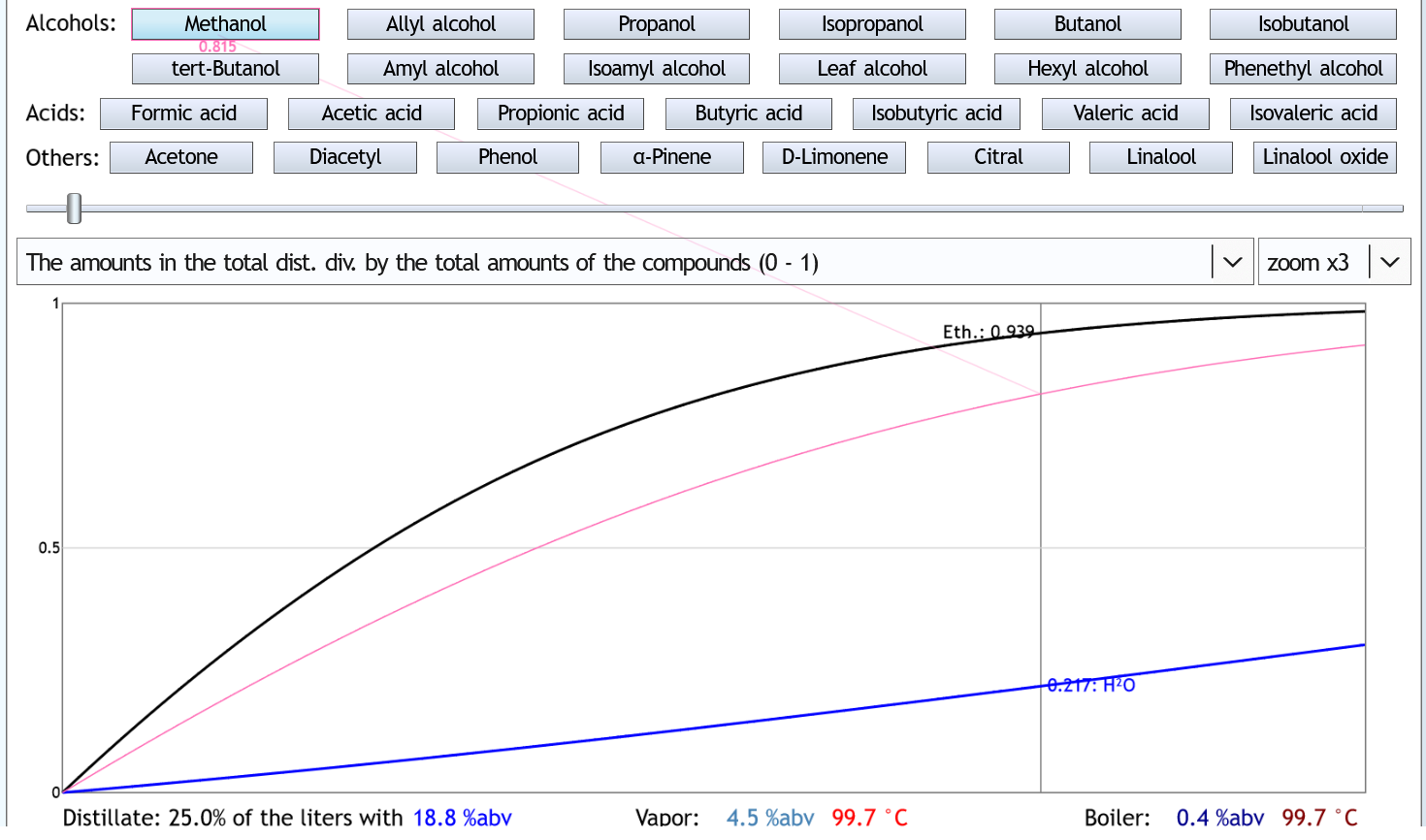 Then you have collected 93.9% of the ethanol and 81.5% of the methanol.
This is a ratio of
Then you have collected 93.9% of the ethanol and 81.5% of the methanol.
This is a ratio of 81.5 / 93.9 = 0.87.
If, on the other hand, the stripping run is stopped after 33% of the still content: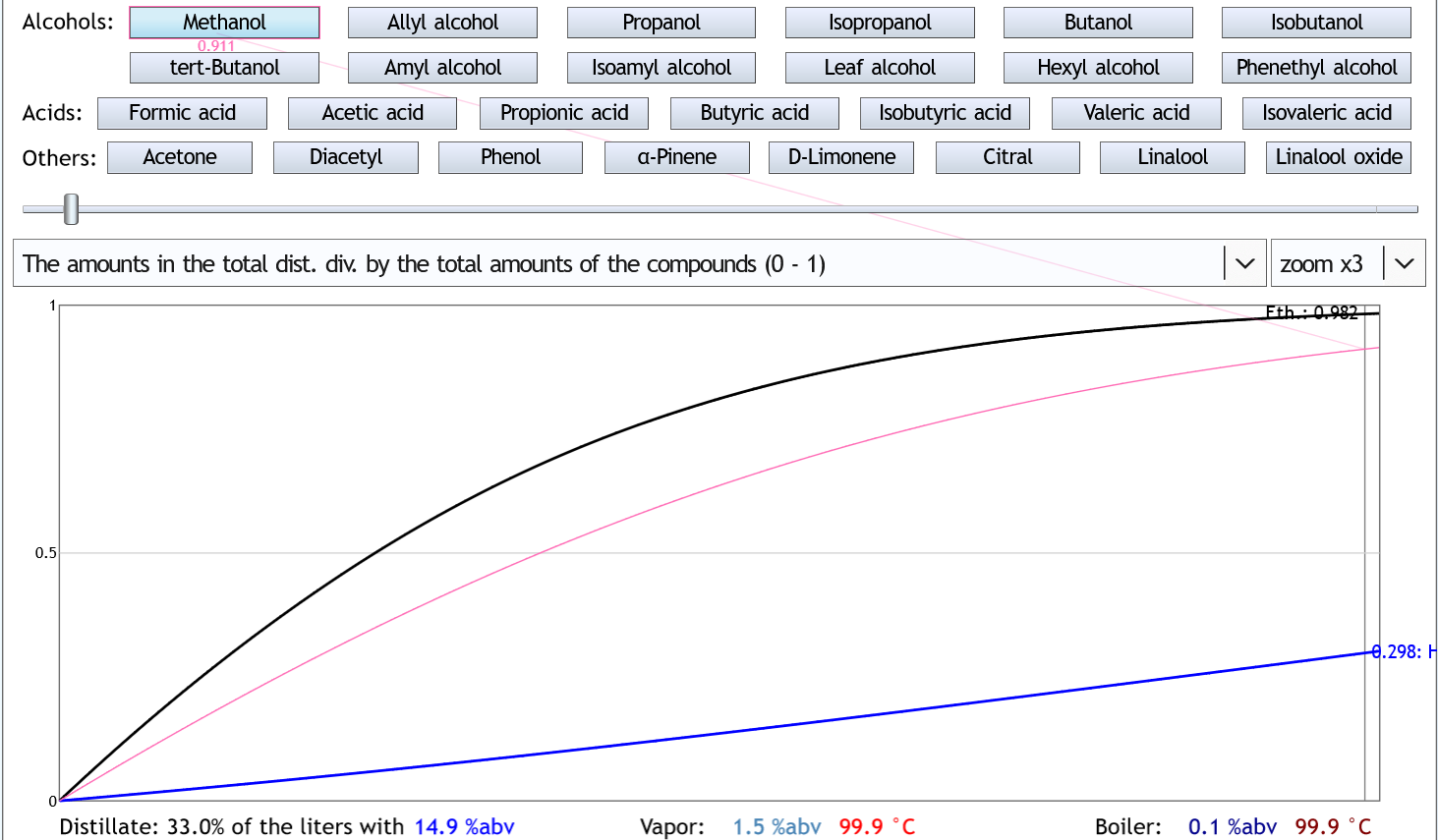 Then you have collected 98.2% of the ethanol and 91.1% of the methanol.
That is a ratio of 0.93.
So the longer collection of distillate has increased the methanol content.
However, only to a small extent.
Then you have collected 98.2% of the ethanol and 91.1% of the methanol.
That is a ratio of 0.93.
So the longer collection of distillate has increased the methanol content.
However, only to a small extent.
Or in a different way of representation: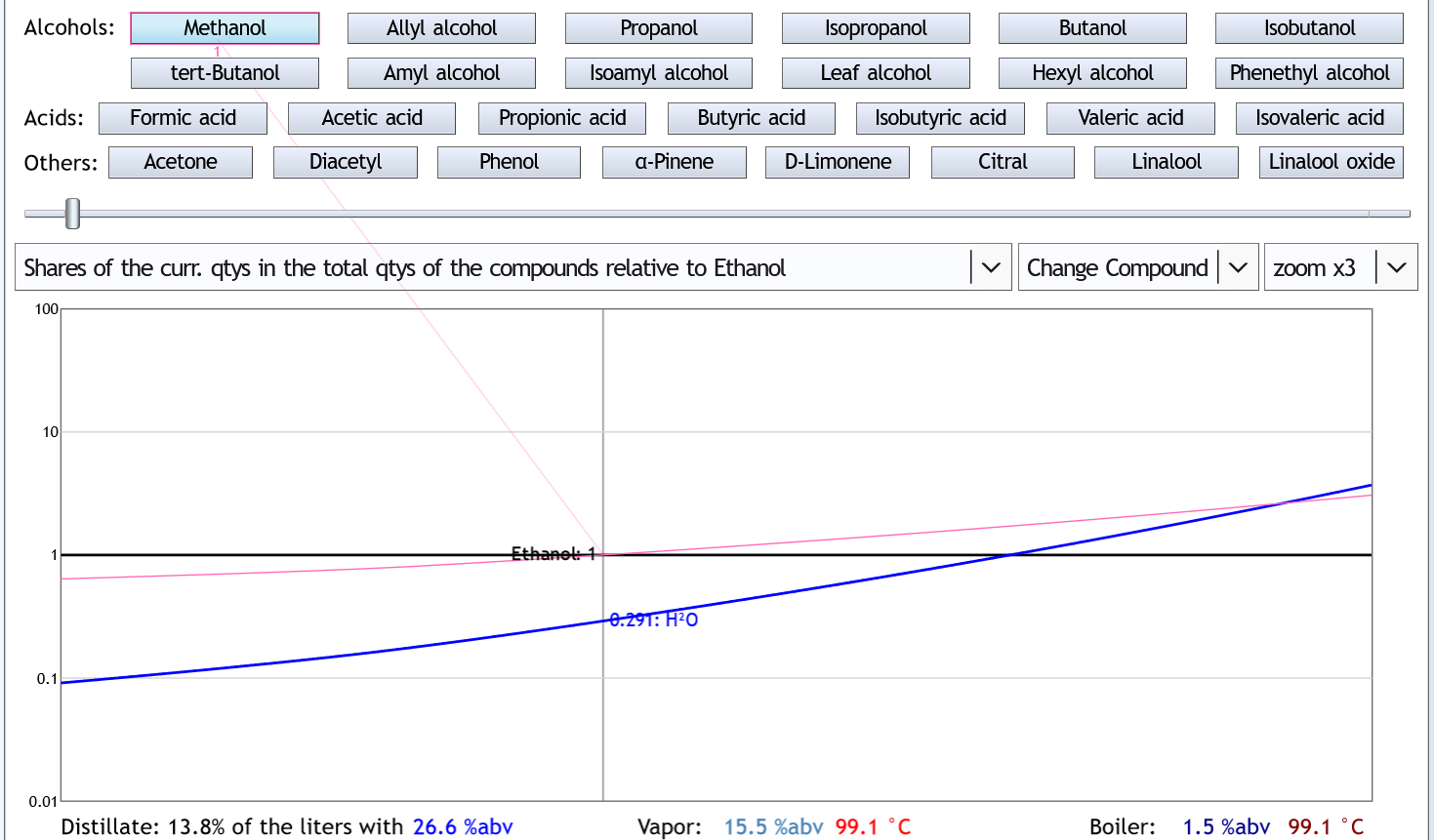 All distillate before distilling 13.8% of the boiler content (intersection of pink and thicker black line) finally reduces the methanol content in the shot glass;
everything after that increases it again.
So cutting foreshots slightly increases the methanol content.
And distilling far down also increases the methanol content somewhat.
Thus, a slight reduction of methanol is obtained in case of a stripping run without rectification and low %abv in the boiler if no foreshots are cut and the distillation is stopped early.
All distillate before distilling 13.8% of the boiler content (intersection of pink and thicker black line) finally reduces the methanol content in the shot glass;
everything after that increases it again.
So cutting foreshots slightly increases the methanol content.
And distilling far down also increases the methanol content somewhat.
Thus, a slight reduction of methanol is obtained in case of a stripping run without rectification and low %abv in the boiler if no foreshots are cut and the distillation is stopped early.
Now with 40%abv in the boiler: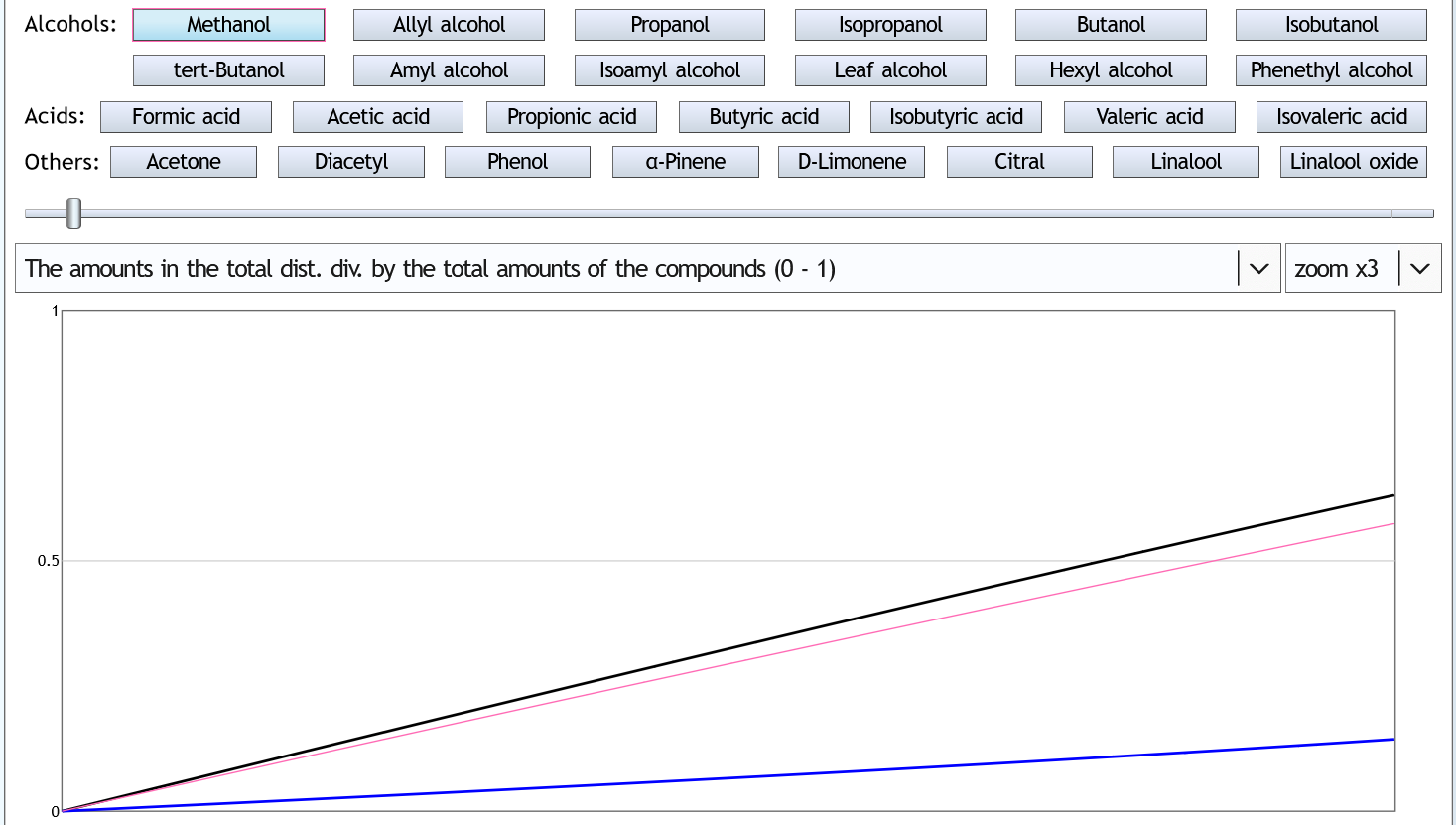
 This is very similar compared to 5%abv in the still.
Except that methanol behaves much more similarly to ethanol, which means that cutting foreshots or tails has even less effect on the methanol content.
This is very similar compared to 5%abv in the still.
Except that methanol behaves much more similarly to ethanol, which means that cutting foreshots or tails has even less effect on the methanol content.
Now with rectification:
5%abv, 6 theor. plates, zoom x10: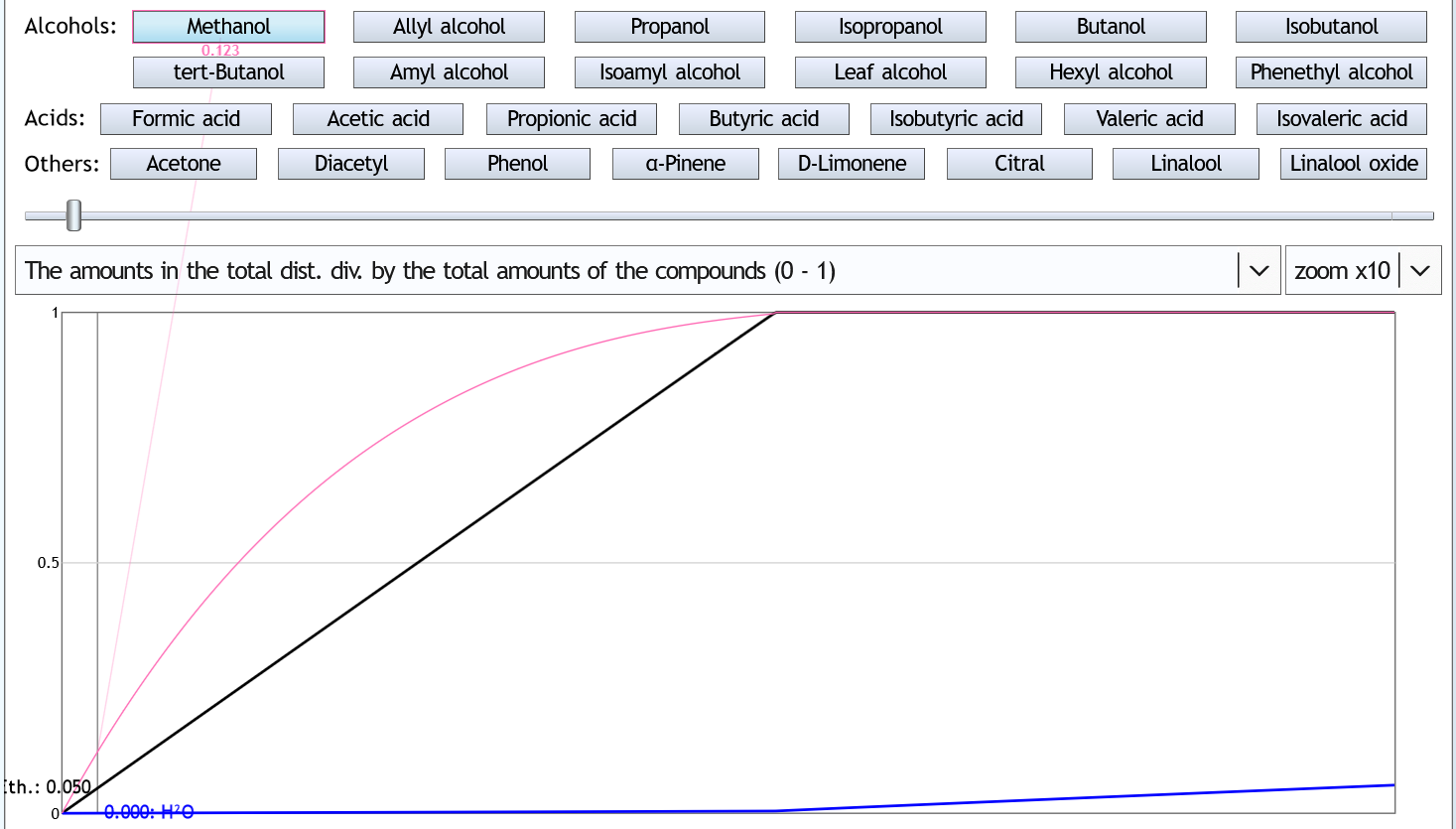 Rectification concentrates the methanol somewhat in the foreshots.
If you cut 5% (0.05) of the ethanol as foreshots, you still get rid of only 12.3% (0.123) of the methanol.
Rectification concentrates the methanol somewhat in the foreshots.
If you cut 5% (0.05) of the ethanol as foreshots, you still get rid of only 12.3% (0.123) of the methanol.
Now 40%abv, 6 theor. plates, zoom x10: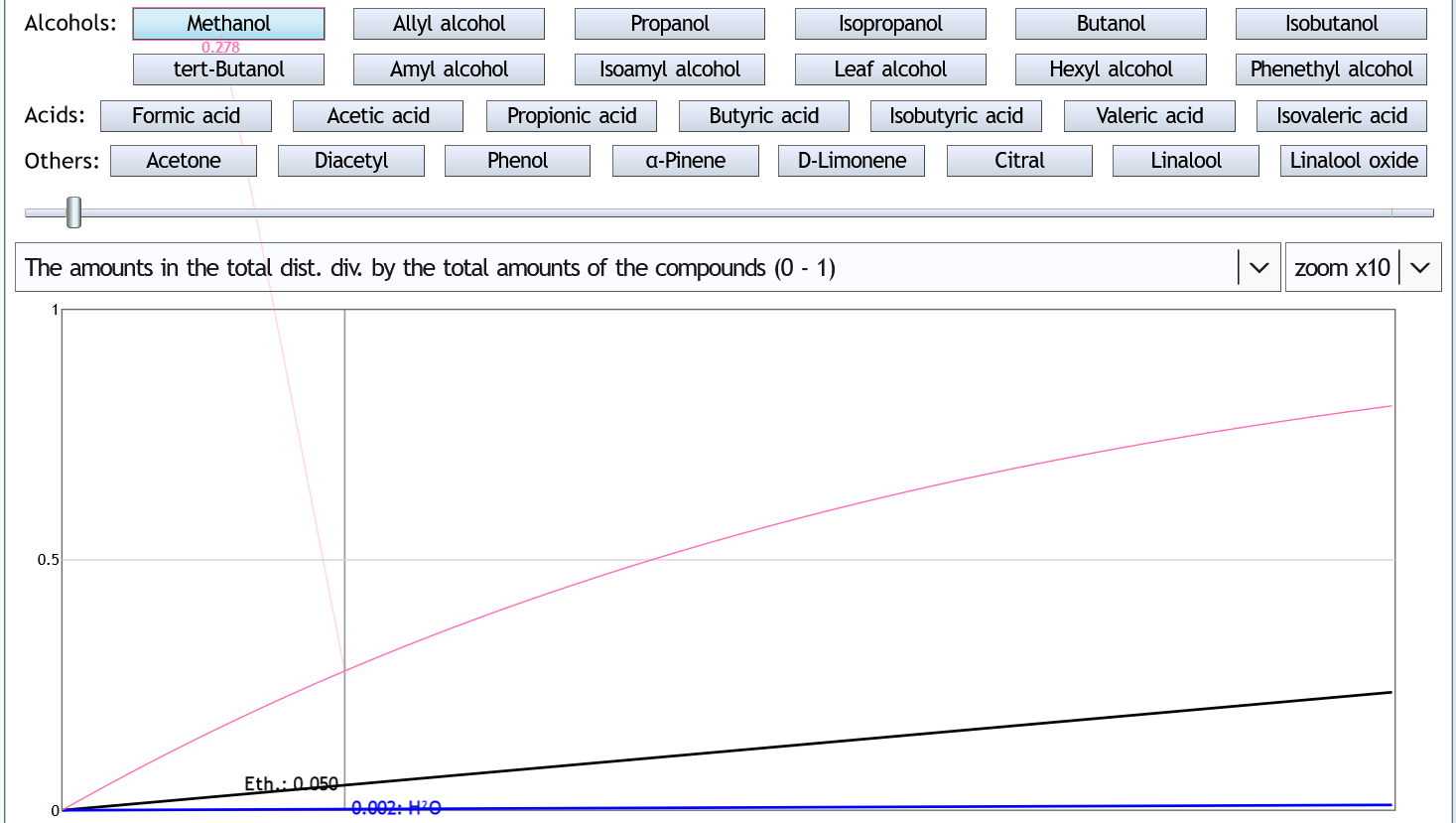 Here one gets rid of 27.8% of the methanol with the foreshots cut after 5% of the ethanol.
Here one gets rid of 27.8% of the methanol with the foreshots cut after 5% of the ethanol.
So it's not really effective all that. You can't get rid of most of it even with a small reflux still.
Now, if you put even higher %abv into the boiler and use more rectification, the calculator claims, you can get rid of the methanol fairly quickly pretty much completely:
95%abv, 10 theor. plates, zoom x10: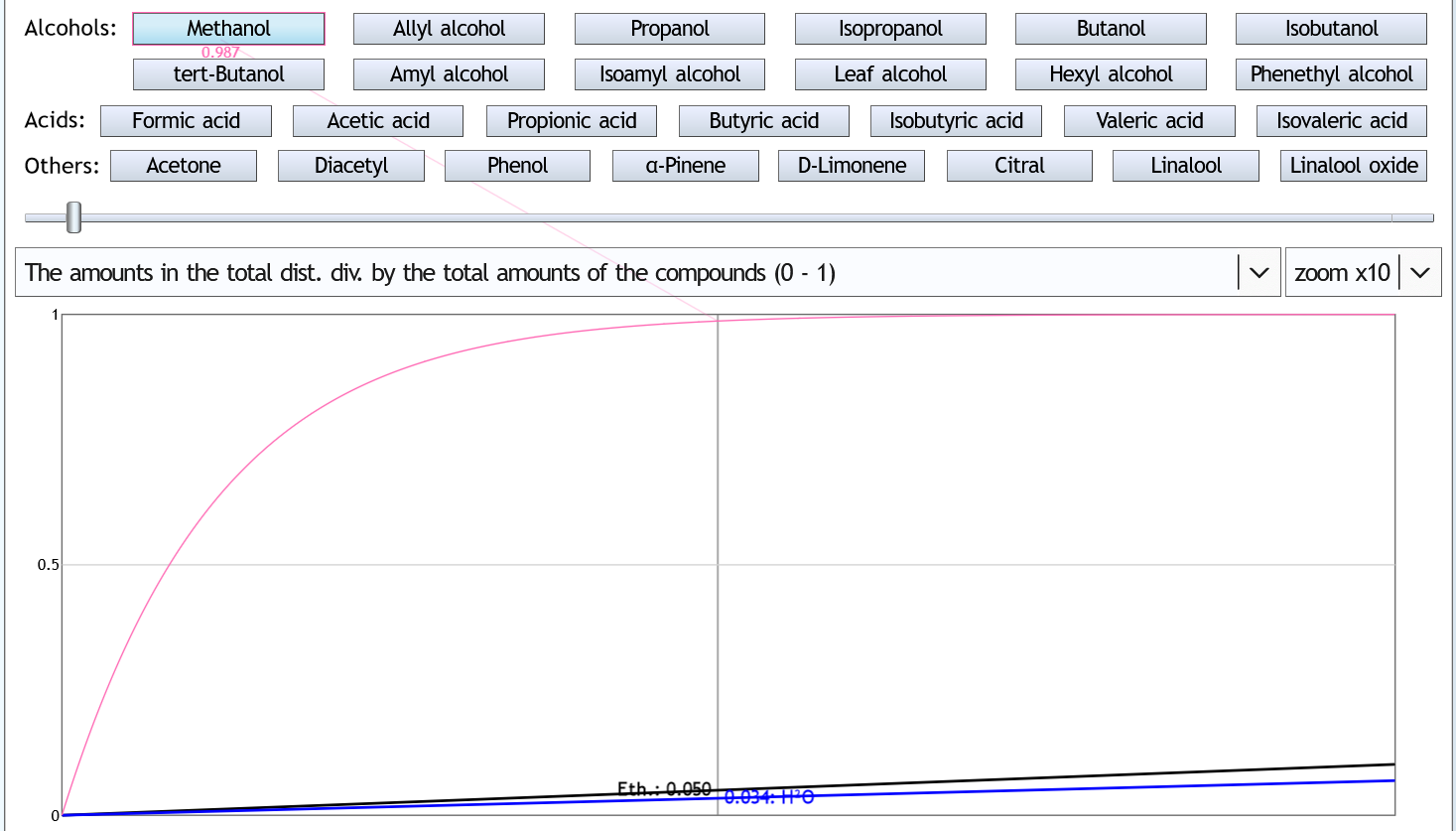 After 5% of the ethanol, you have separated 98.7% of the methanol.
And this is how the industry does it.
Not the liquor industry, but the industry for industrial alcohol.
In principle, we can do it, too.
In practice, however, it will work less well;
first, because the typical foreshot substances (some of which are very good aroma substances) will "push their way in", so that the best we can make is neutral alcohol;
and second, because the molecules of the congeners influence each other, so that the separation is not as sharp as calculated with this data.
In addition, methanol is actually only produced during the fermentation of fruit containing pectin.
And one would like to distill this mostly without or with only little rectification.
At the most, it is interesting to make neutral alcohol from the feints of the fruit fine spirits.
And you should think carefully about whether you feel safe putting such high alcohol strengths into the still.
After 5% of the ethanol, you have separated 98.7% of the methanol.
And this is how the industry does it.
Not the liquor industry, but the industry for industrial alcohol.
In principle, we can do it, too.
In practice, however, it will work less well;
first, because the typical foreshot substances (some of which are very good aroma substances) will "push their way in", so that the best we can make is neutral alcohol;
and second, because the molecules of the congeners influence each other, so that the separation is not as sharp as calculated with this data.
In addition, methanol is actually only produced during the fermentation of fruit containing pectin.
And one would like to distill this mostly without or with only little rectification.
At the most, it is interesting to make neutral alcohol from the feints of the fruit fine spirits.
And you should think carefully about whether you feel safe putting such high alcohol strengths into the still.
5%abv in the boiler, 1 theor. plate, zoom x3:

If you stop this stripping run after 25% of the boiler content:

If, on the other hand, the stripping run is stopped after 33% of the still content:

Or in a different way of representation:

Now with 40%abv in the boiler:


Now with rectification:
5%abv, 6 theor. plates, zoom x10:

Now 40%abv, 6 theor. plates, zoom x10:

So it's not really effective all that. You can't get rid of most of it even with a small reflux still.
Now, if you put even higher %abv into the boiler and use more rectification, the calculator claims, you can get rid of the methanol fairly quickly pretty much completely:
95%abv, 10 theor. plates, zoom x10:

Are the higher alcohols in the tails?
Higher alcohols (often also called fusel alcohols) are usually referred to as tails substances.
However, this is only partially correct.
The following examples are calculated with Congeners Simulator 1.
5%abv, 1 theor. plate: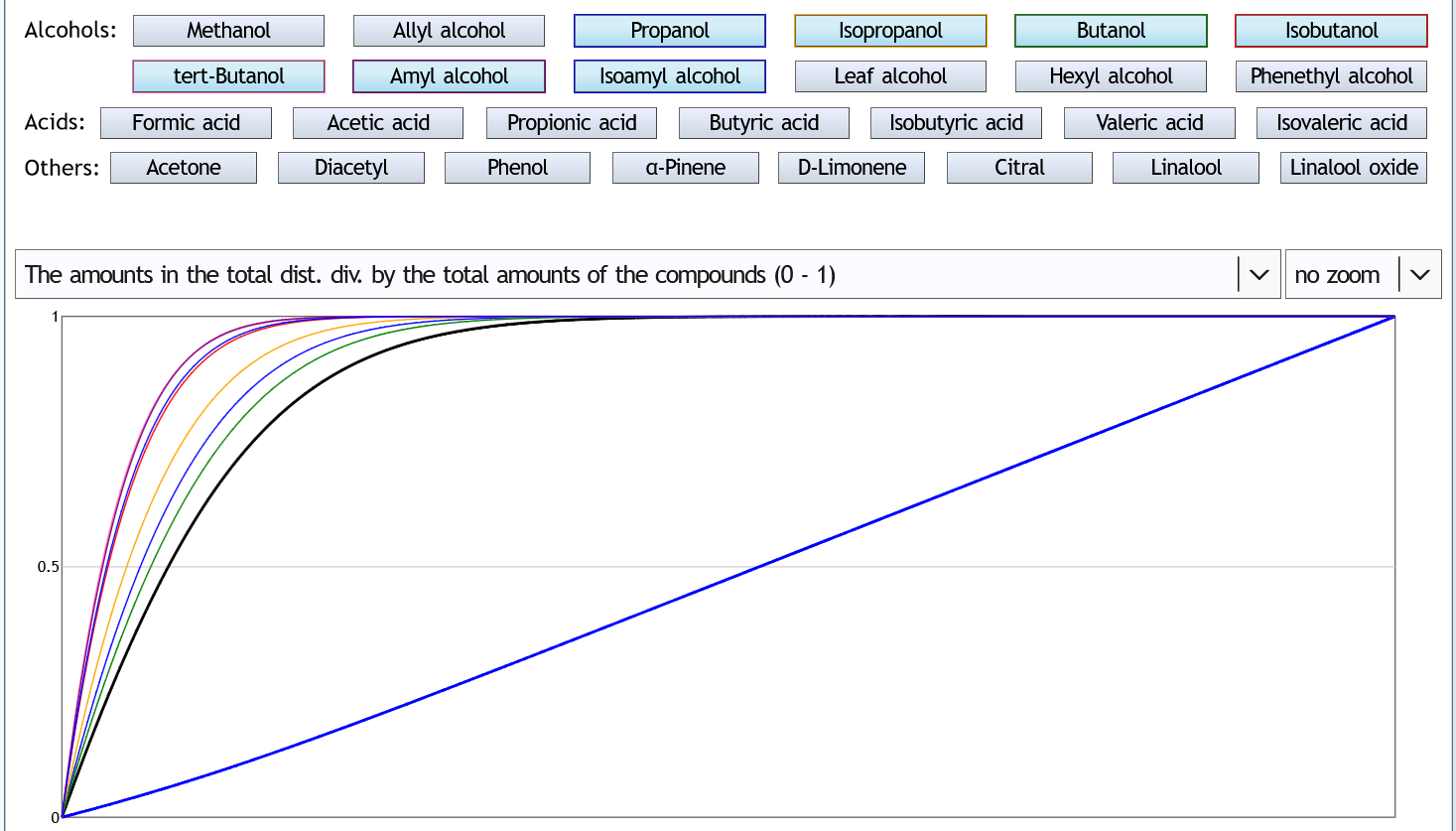 The typical and most common higher alcohols (thin colored lines) all pass into the distillate faster than ethanol (thicker black line).
There is thus a slight enrichment in the foreshots.
The typical and most common higher alcohols (thin colored lines) all pass into the distillate faster than ethanol (thicker black line).
There is thus a slight enrichment in the foreshots.
Other representation: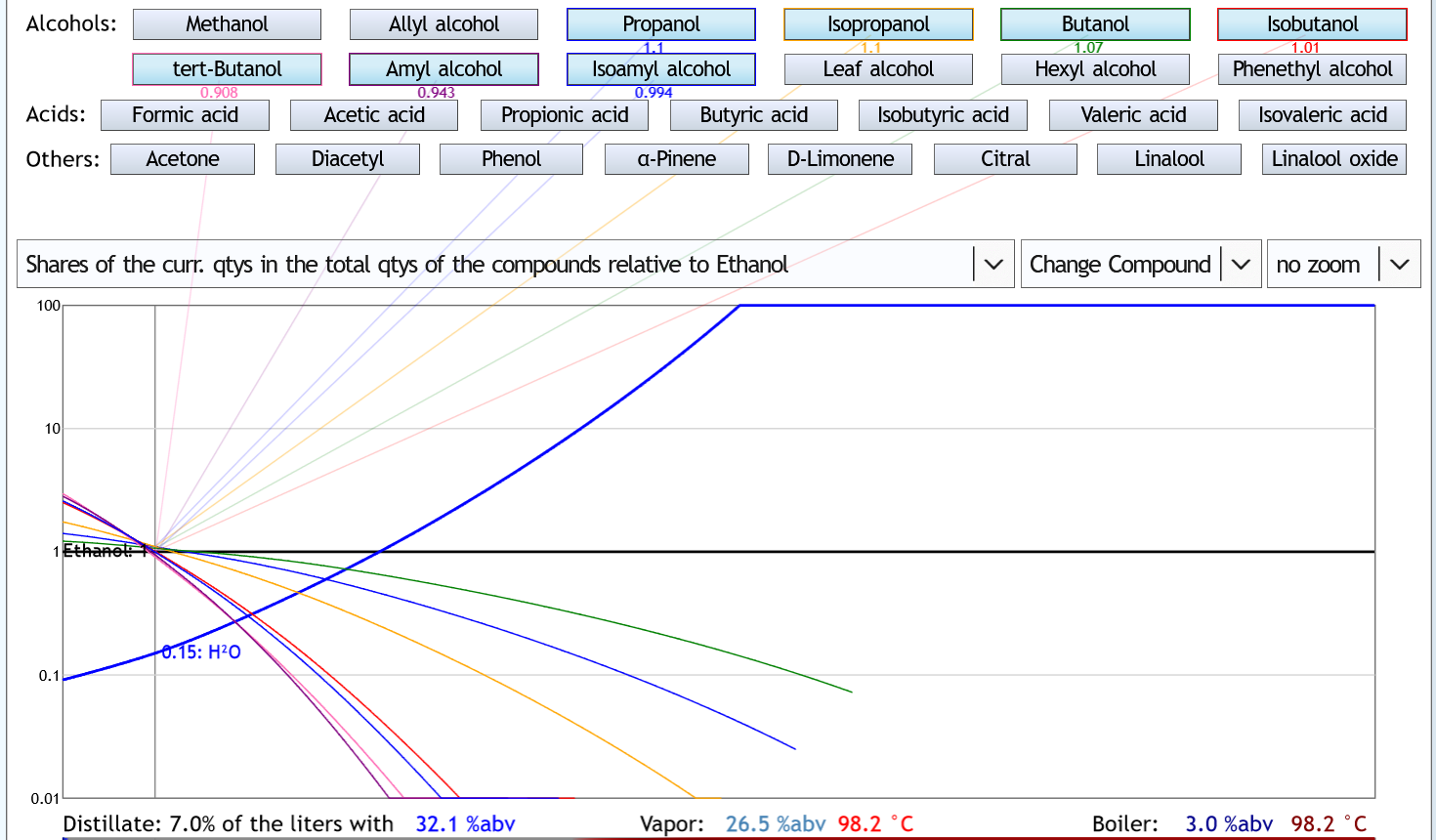 Initially, compared to ethanol, you get more of the higher alcohols into the distillate, after about 7% of the volume less.
Initially, compared to ethanol, you get more of the higher alcohols into the distillate, after about 7% of the volume less.
Now 40%abv, 1 theor. plate: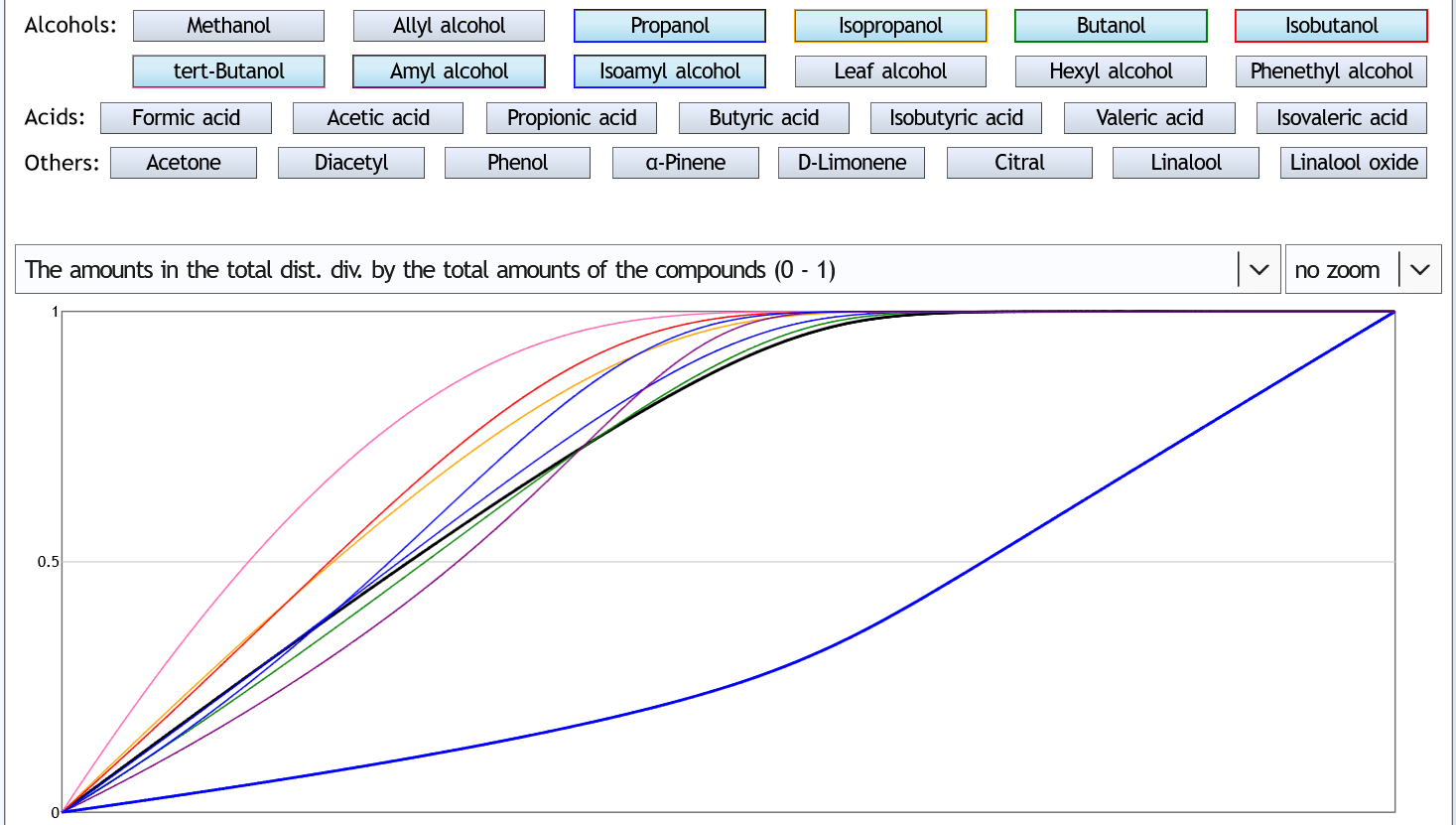 Some curves are a little below that of ethanol, others a little above ethanol.
So there is little concentration or retention.
Some curves are a little below that of ethanol, others a little above ethanol.
So there is little concentration or retention.
Other representation: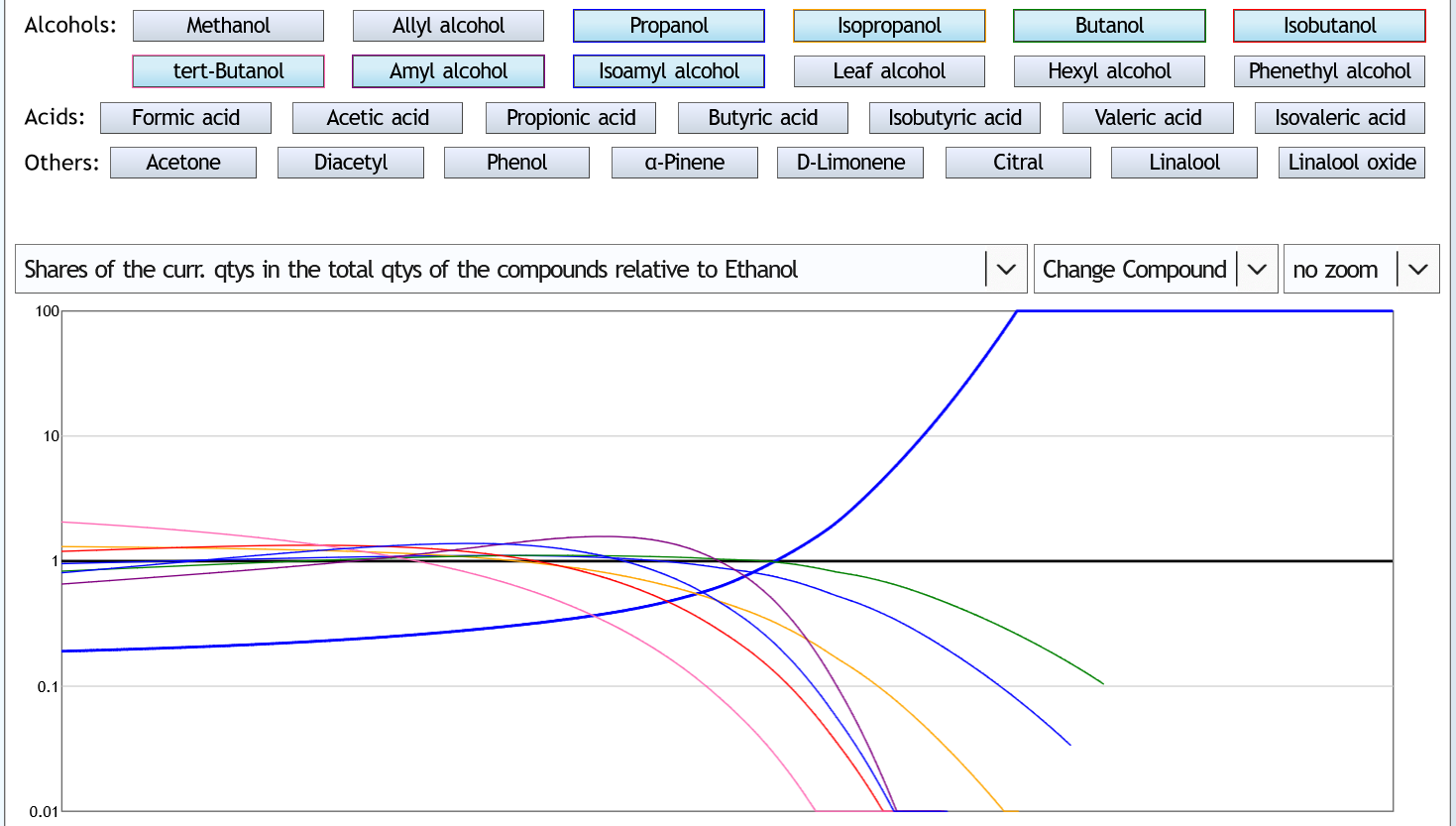 Here you see the same thing.
The drop in the curves on the right is because, overall, the higher alcohols have depleted a little faster than ethanol.
At the dropping of the curve, the concentration of the substances in the still is almost 0, but ethanol is still present.
Here you see the same thing.
The drop in the curves on the right is because, overall, the higher alcohols have depleted a little faster than ethanol.
At the dropping of the curve, the concentration of the substances in the still is almost 0, but ethanol is still present.
Now with rectification: 5%abv, 6 theor. plates, zoom x10: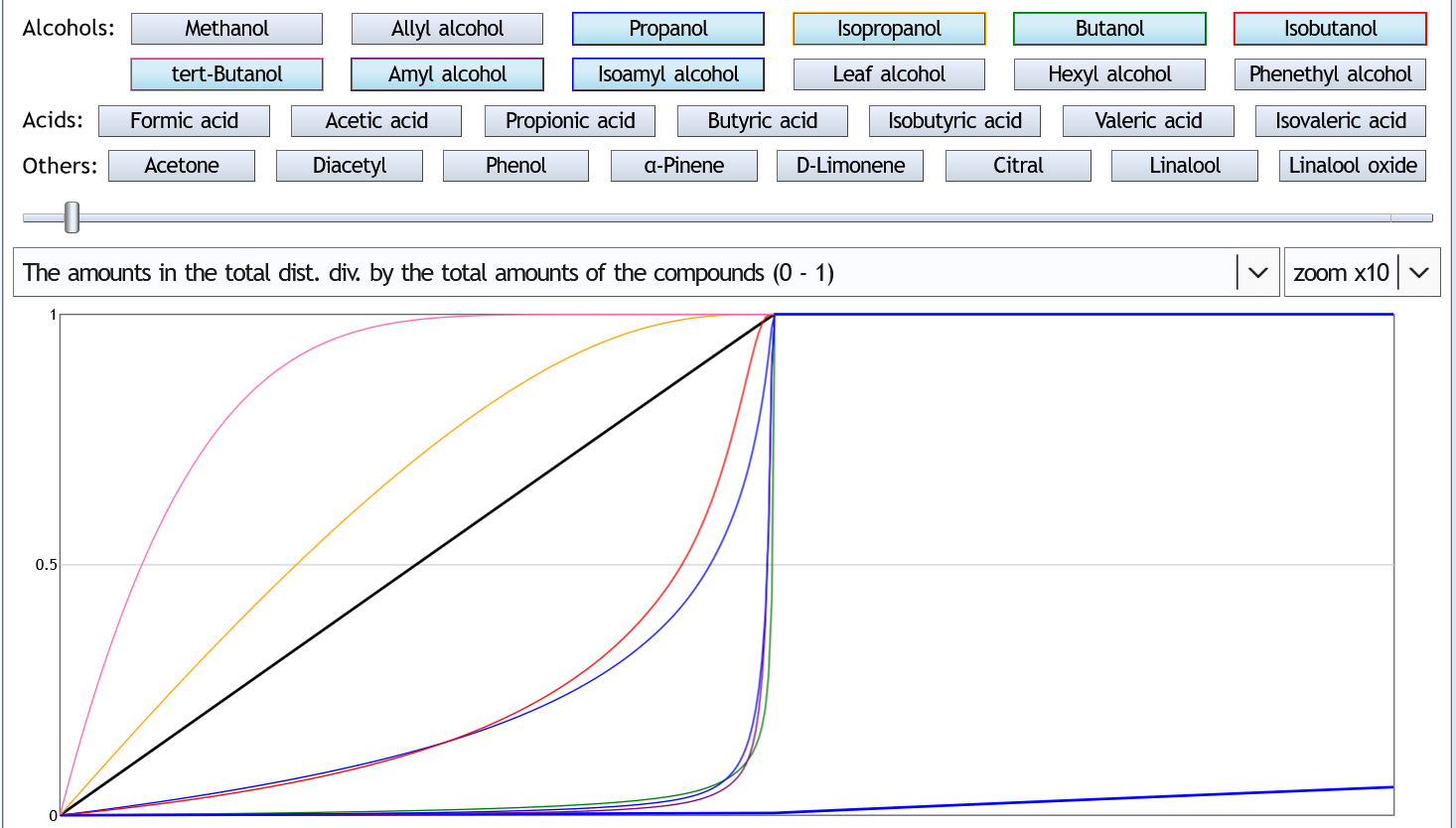 The typical and most higher alcohols are retained in the still and shoot up steeply once the alcohol content in the still has dropped.
Thus, rectification reduces higher alcohols from entering the foreshots and hearts.
The typical and most higher alcohols are retained in the still and shoot up steeply once the alcohol content in the still has dropped.
Thus, rectification reduces higher alcohols from entering the foreshots and hearts.
Other representation: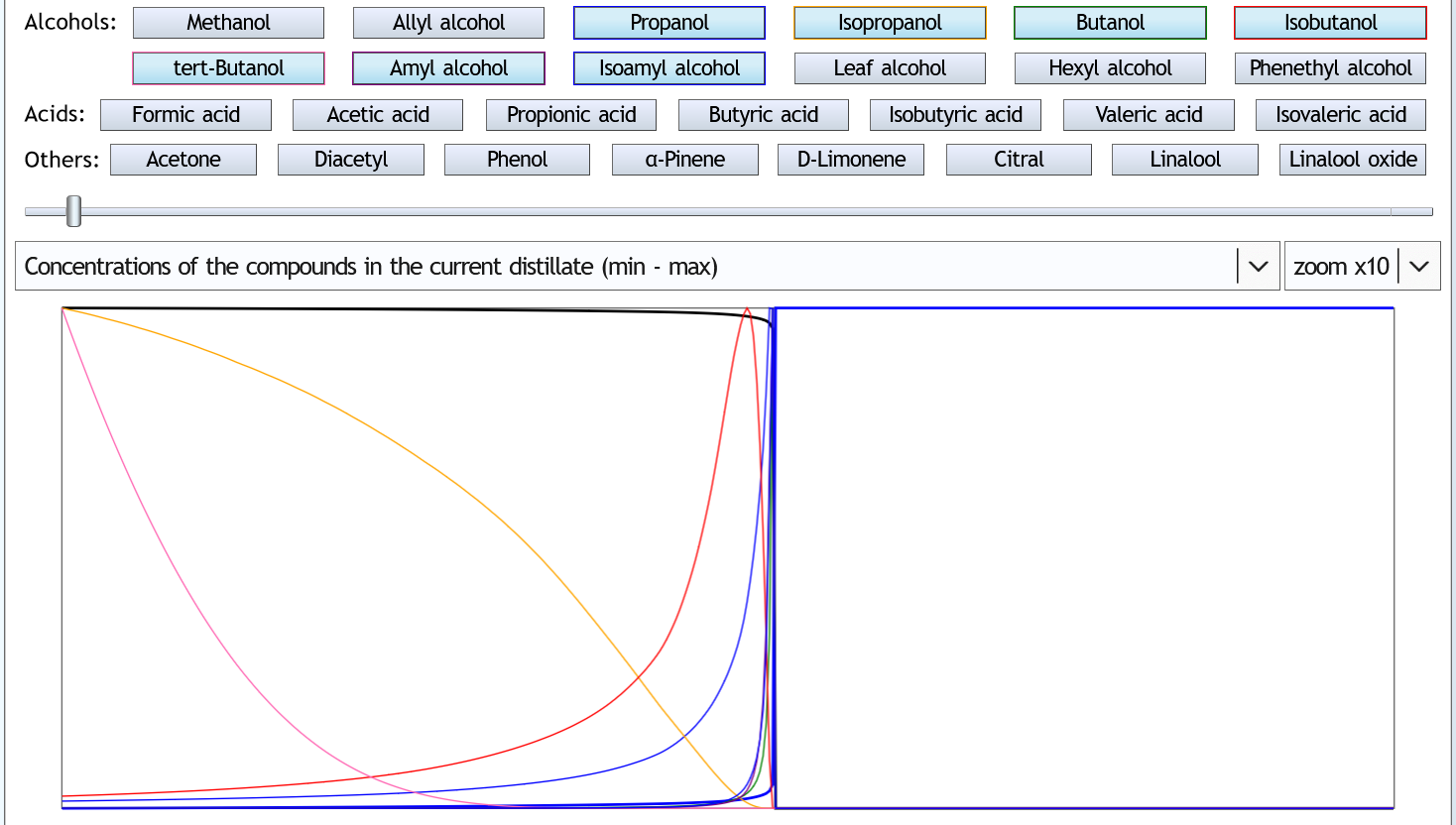 Here you can see how the current amounts of most higher alcohols shoot up just before the alcohol content in the vapor drops.
The fact that they drop again immediately afterwards is due to the fact that they have been used up immediately, i.e. they have landed almost completely in the distillate within a very short time.
This is also known from practice:
if you run a strong rectifying reflux still until the alcohol is almost completely distilled off, suddenly a short span of foul-smelling distillate appears.
Here you can see how the current amounts of most higher alcohols shoot up just before the alcohol content in the vapor drops.
The fact that they drop again immediately afterwards is due to the fact that they have been used up immediately, i.e. they have landed almost completely in the distillate within a very short time.
This is also known from practice:
if you run a strong rectifying reflux still until the alcohol is almost completely distilled off, suddenly a short span of foul-smelling distillate appears.
Now 40%abv, 6 theor. plates, no zoom:
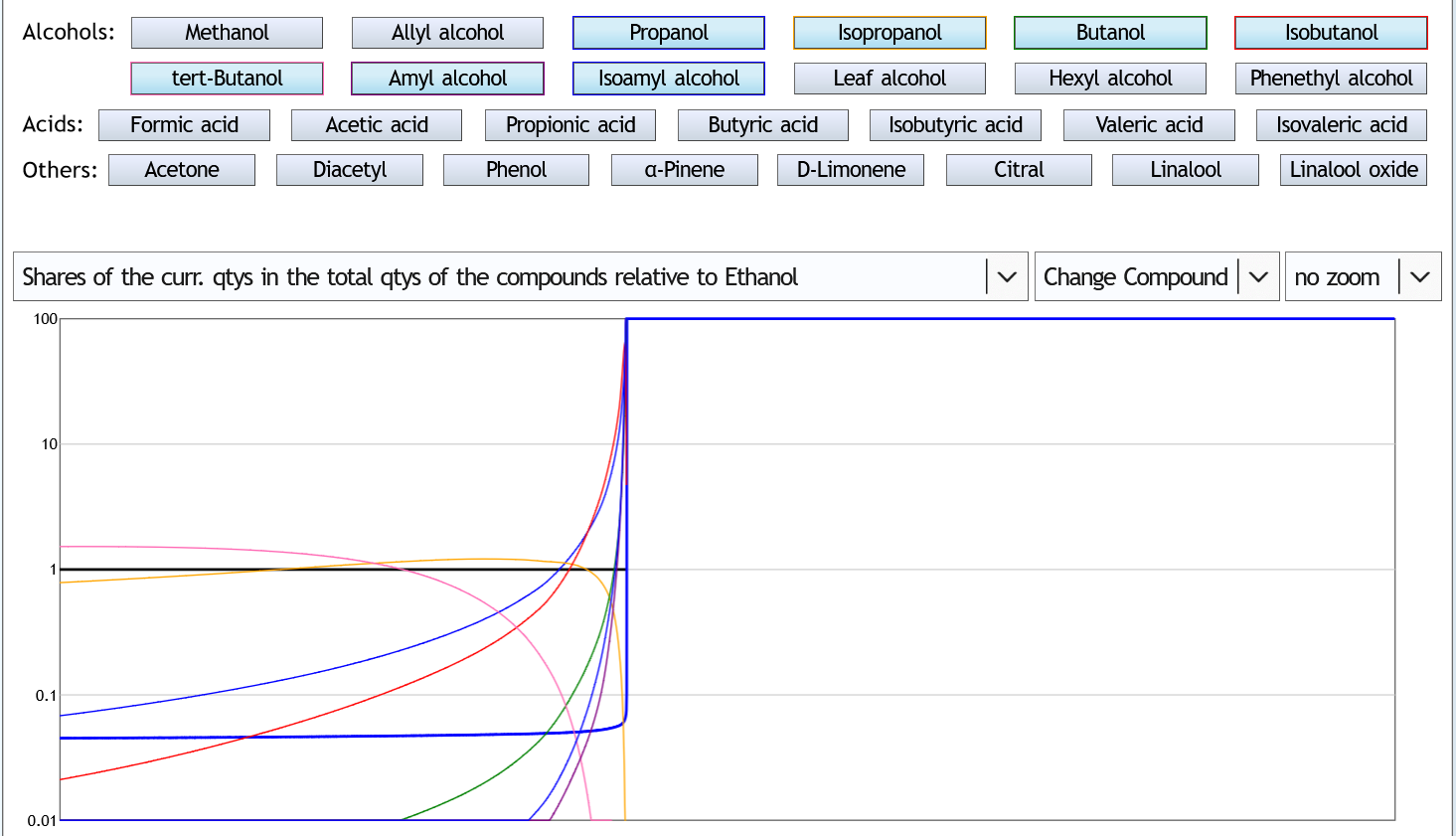 The point at which the ethanol content drops is later, of course.
But you see the same behavior, just a bit more extreme.
The point at which the ethanol content drops is later, of course.
But you see the same behavior, just a bit more extreme.
With higher rectification, the higher alcohols can be retained much more, both in theory and in practice. But their shooting up as soon as the ethanol is distilled is not as extreme as the simulator calculates, because the congener molecules start to influence each other.
Conclusion: That the higher alcohols are tails substances is therefore only true for reflux distillations.
5%abv, 1 theor. plate:

Other representation:

Now 40%abv, 1 theor. plate:

Other representation:

Now with rectification: 5%abv, 6 theor. plates, zoom x10:

Other representation:

Now 40%abv, 6 theor. plates, no zoom:


With higher rectification, the higher alcohols can be retained much more, both in theory and in practice. But their shooting up as soon as the ethanol is distilled is not as extreme as the simulator calculates, because the congener molecules start to influence each other.
Conclusion: That the higher alcohols are tails substances is therefore only true for reflux distillations.
Should one also separate foreshots from stripping runs?
First, the question of which is more efficient, i.e. whether the foreshots can be cut more efficiently in the stripping or the spirit run.
The following examples are calculated with Congeners Simulator 1.
The two main foreshots substances acetaldehyde and ethyl acetate are shown:
5%abv, 1.3 theor. plates, zoom x10: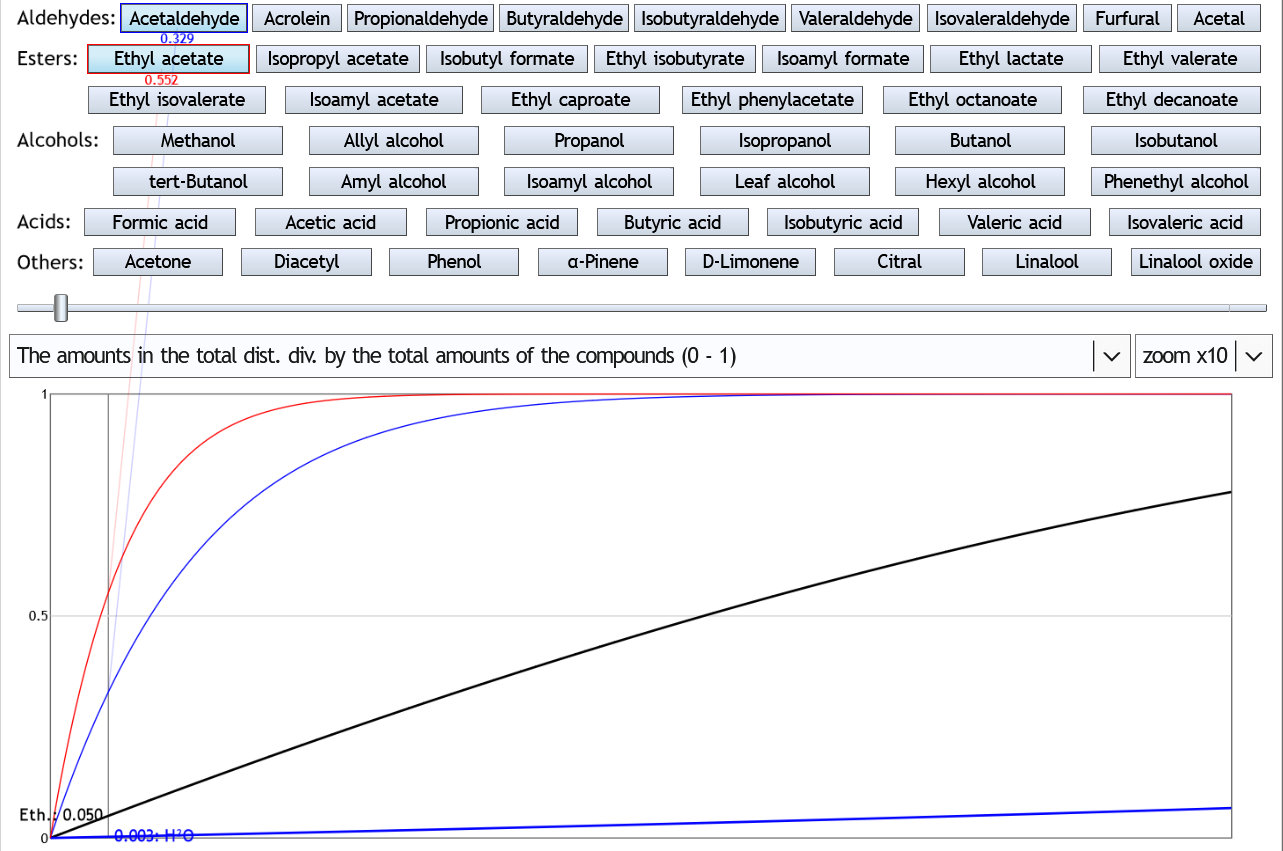 If you cut 5% (0.050) of the ethanol as foreshots, you have removed 32.9% (0.329) of the acetaldehyde and 55.2% (0.552) of the ethyl acetate.
If you cut 5% (0.050) of the ethanol as foreshots, you have removed 32.9% (0.329) of the acetaldehyde and 55.2% (0.552) of the ethyl acetate.
Now 40%abv (spirit run): If you cut 5% of ethanol as foreshots, you have removed 41.6% of the acetaldehyde (so slightly more than at 5%abv) and 32.3% (so less than at 5%abv) of the ethyl acetate.
If you cut 5% of ethanol as foreshots, you have removed 41.6% of the acetaldehyde (so slightly more than at 5%abv) and 32.3% (so less than at 5%abv) of the ethyl acetate.
Thus, removing the foreshots is somewhat more efficient overall in the stripping run than in the spirit run.
However, two points put this result into perspective:
- New foreshots can form after the stripping run. So a cut must still be done in most cases during the spirit run.
- If the spirit run is done with a reflux still, the cut is of course much more efficient: 40%abv, 6 theor. plates: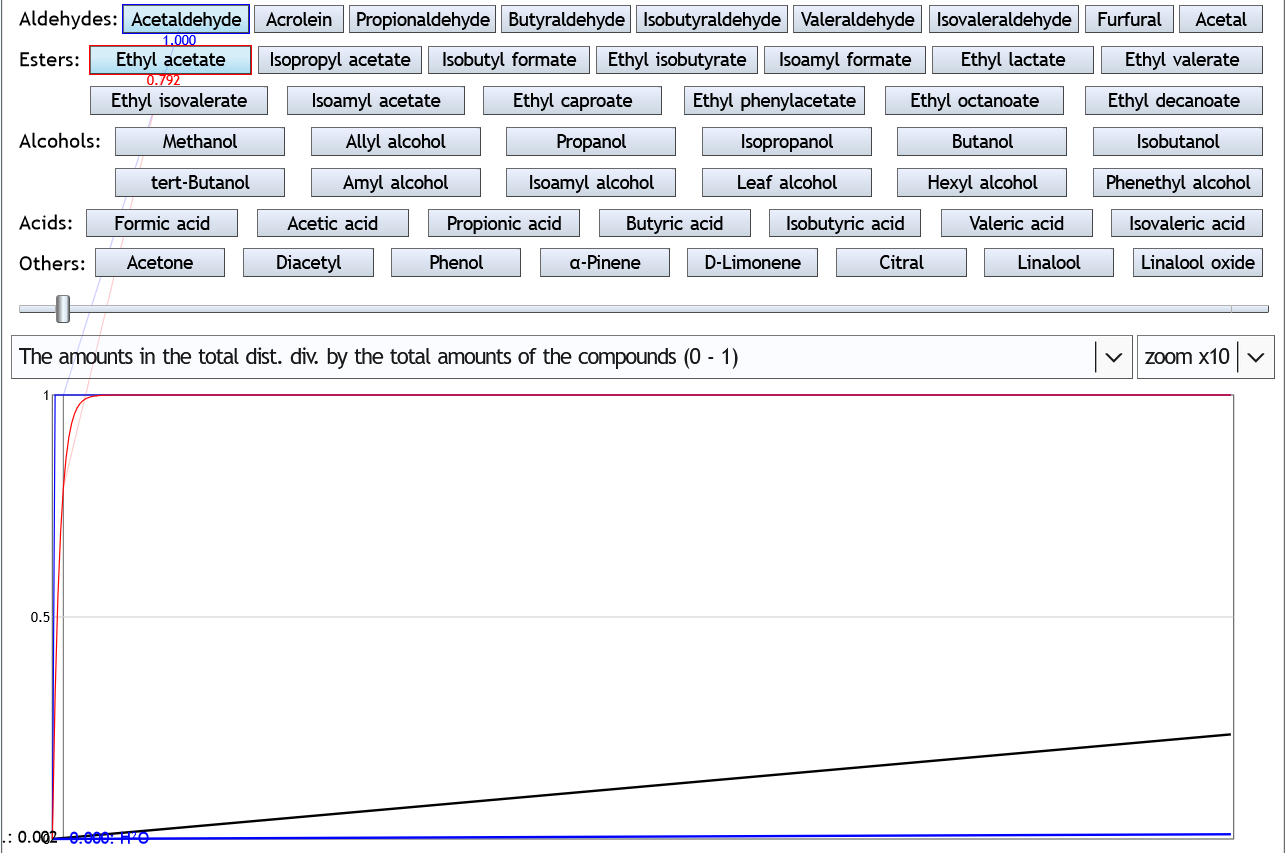 Already after 2% of ethanol, both foreshots substances are quite completely removed.
Whether this really happens quite so completely and quickly in practice, however, is not certain.
But this does not change the general result.
Already after 2% of ethanol, both foreshots substances are quite completely removed.
Whether this really happens quite so completely and quickly in practice, however, is not certain.
But this does not change the general result.
In most cases, the aim is not to lose as little ethanol as possible during the foreshots cut, but to achieve the best possible result in terms of taste. You want to cut as many bad flavors as possible, but you want to do it without cutting many good flavors as well.
And a simulation can provide answers to this question through its comparative representations by showing how the rather good and the rather bad aroma substances relate to each other within a substance group. The rather bad substances are those with low molar masses and the rather good ones are those with high molar masses. And the substances in the simulator are ordered by molar mass. So the worst (and at the same time most common) aldehyde is acetalehyde.
5%abv, 1.3 theor. plates, zoom x10 (only aldehydes typical from molecular structure or molecular formula or aldehydes comparable with acetaldehyde are shown):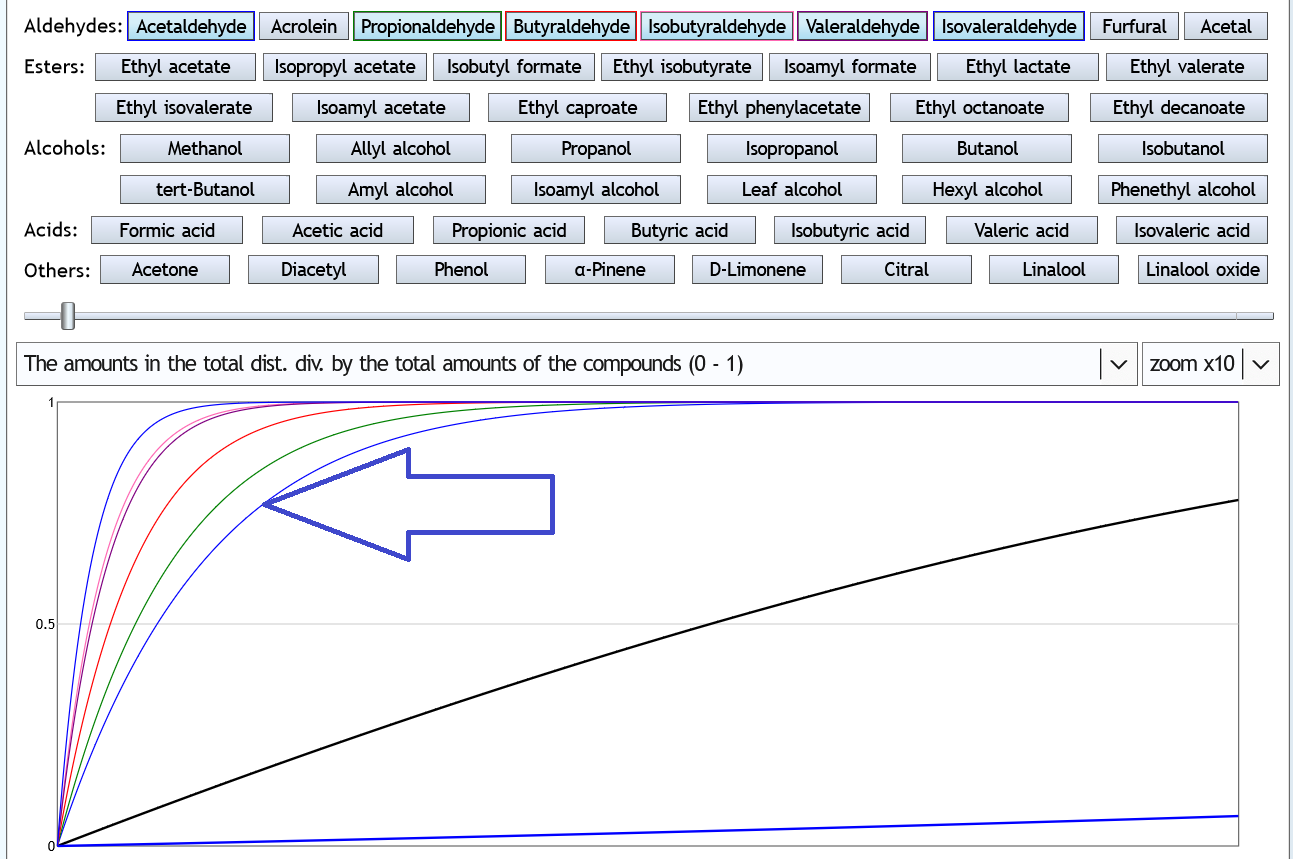 Acetaldehyde (thin blue line, see arrow) concentrates the least.
So in this case, during the foreshots cut, you reduce more the good flavors than the bad ones.
Acetaldehyde (thin blue line, see arrow) concentrates the least.
So in this case, during the foreshots cut, you reduce more the good flavors than the bad ones.
Other representation: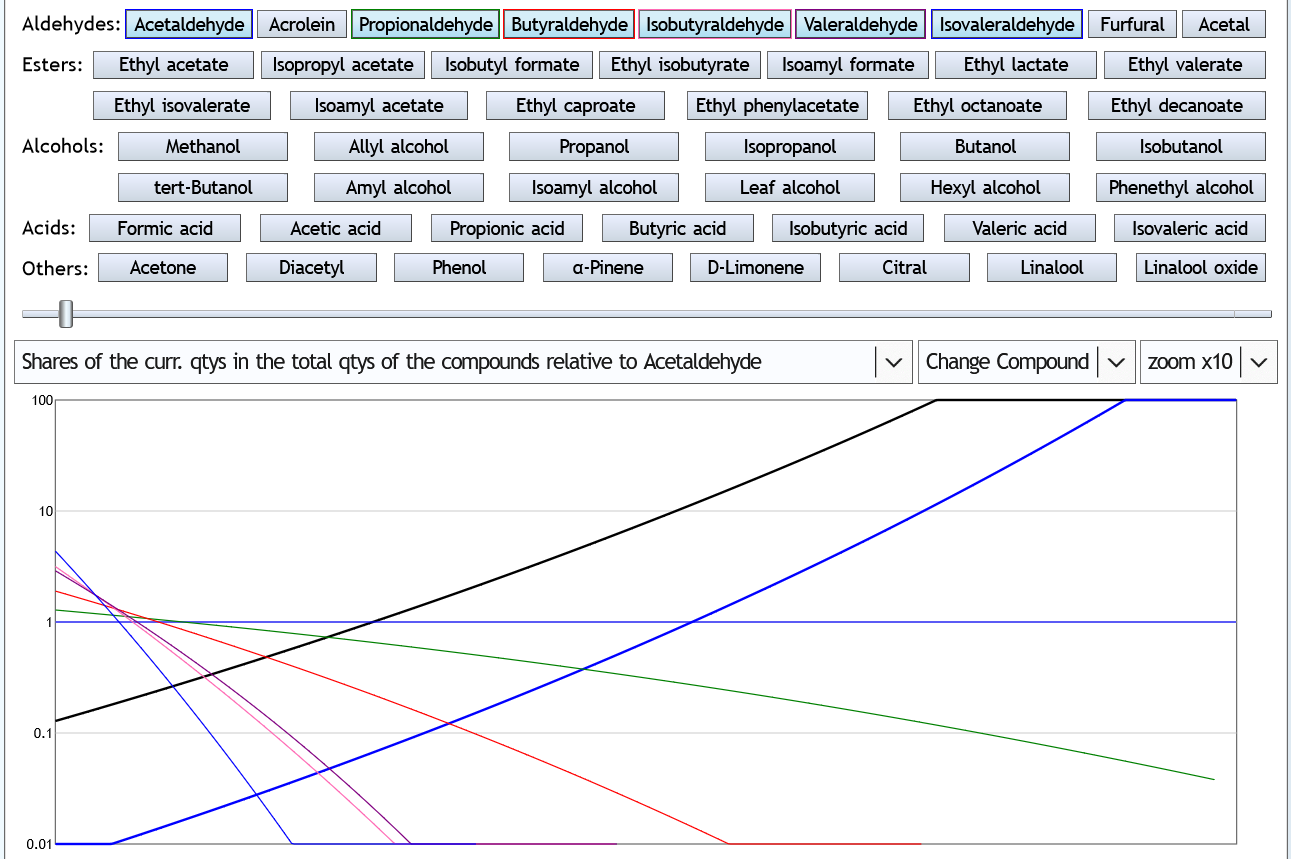 All curves start above 1, so above the curve of acetaldehyde.
All curves start above 1, so above the curve of acetaldehyde.
Now 40%abv (spirit run strength):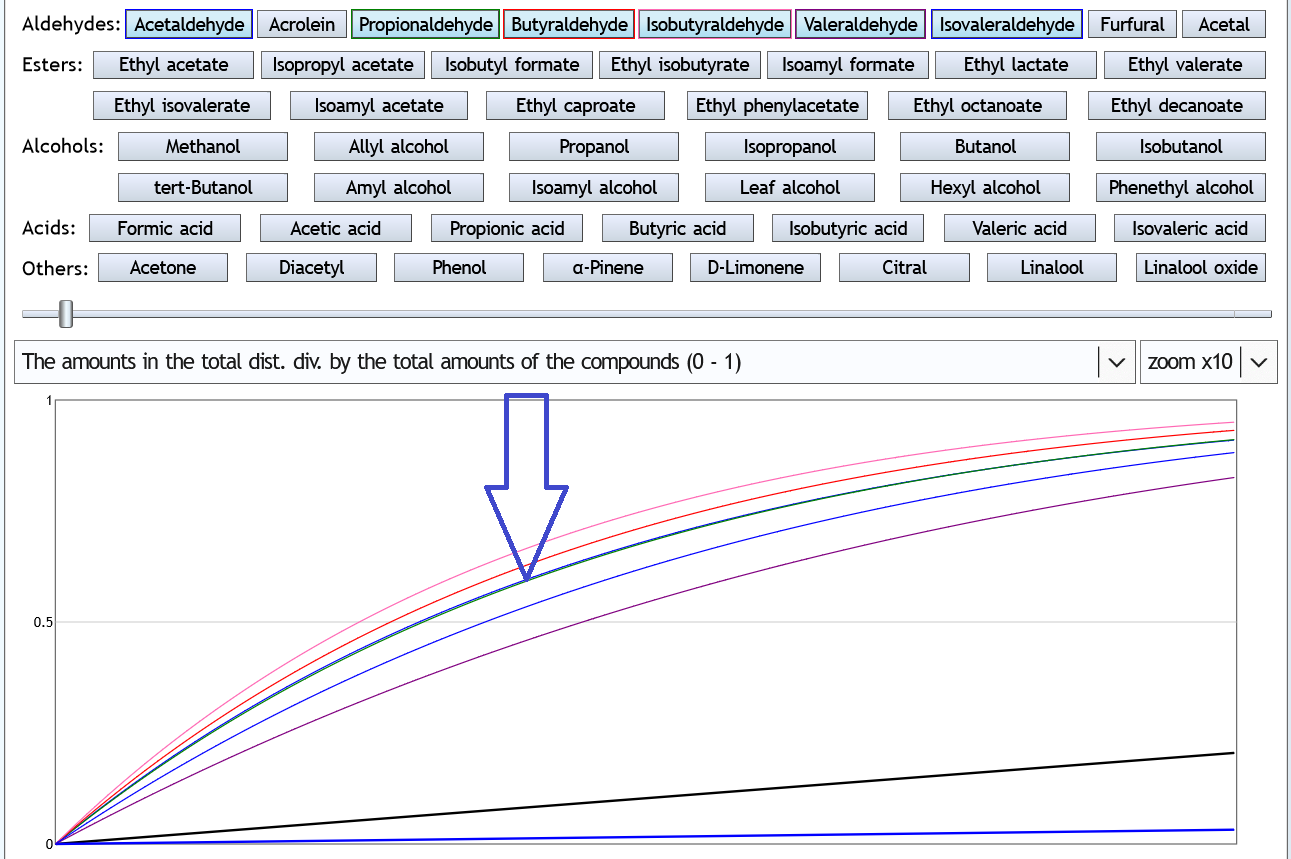 At higher alcohol content, acetaldehyde (arrow) concentrates better than the more valuable valeraldehyde and isovaleraldehyde.
At higher alcohol content, acetaldehyde (arrow) concentrates better than the more valuable valeraldehyde and isovaleraldehyde.
Other view: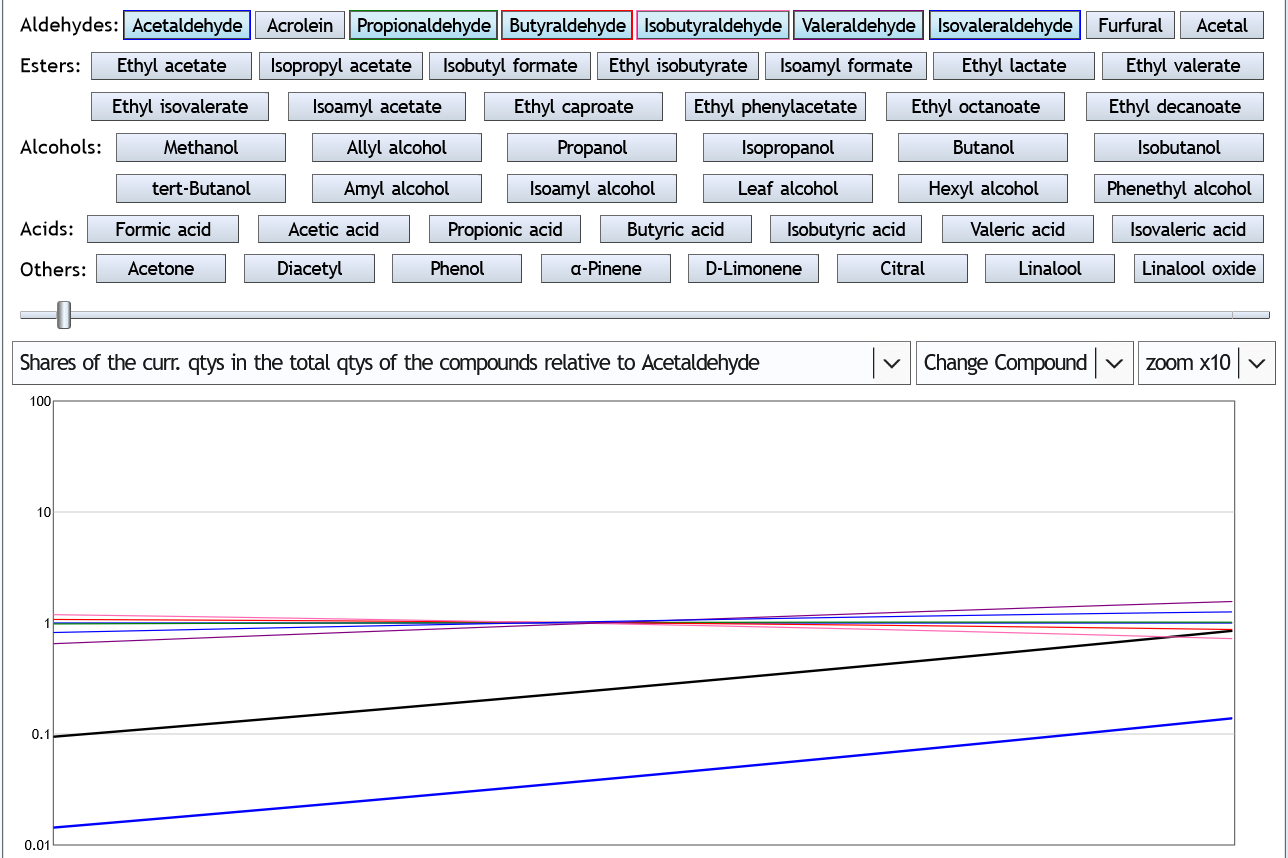 Valeraldehyde and isovaleraldehyde are below 1 at the beginning.
Valeraldehyde and isovaleraldehyde are below 1 at the beginning.
Conclusion: Regarding the aldehydes, a foreshots cut during the stripping run is therefore rather harmful to the aroma.
Now the esters:
5%abv, 1.3 theor. plates, zoom x10 (only esters typical of the molecular structure or molecular formula or esters comparable to ethyl acetate are shown):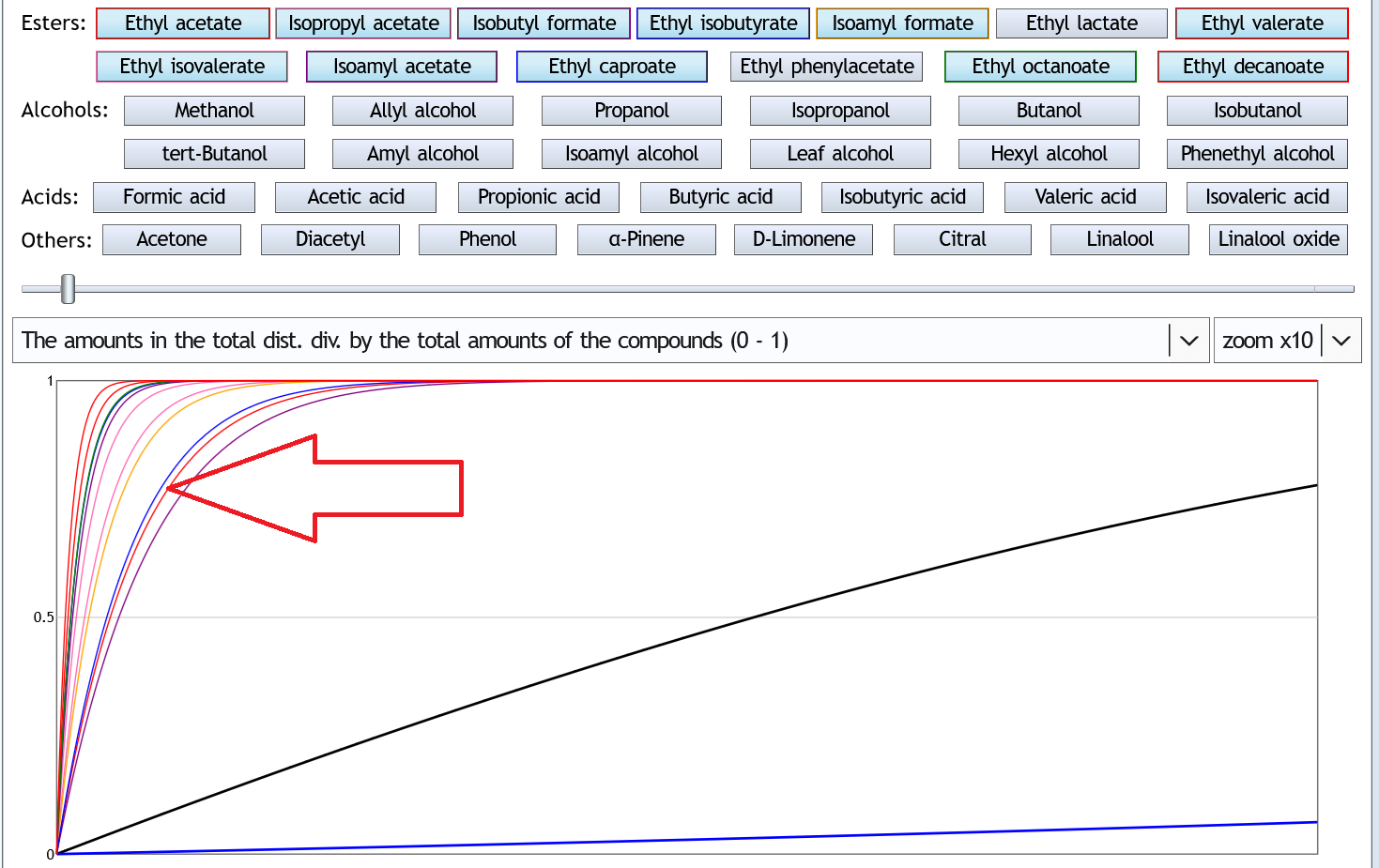 Almost all substances concentrate more in the foreshots than ethyl acetate (thin red line, see arrow).
So in this case, cutting foreshots reduces more the good flavors than the bad ones.
Almost all substances concentrate more in the foreshots than ethyl acetate (thin red line, see arrow).
So in this case, cutting foreshots reduces more the good flavors than the bad ones.
Other representation: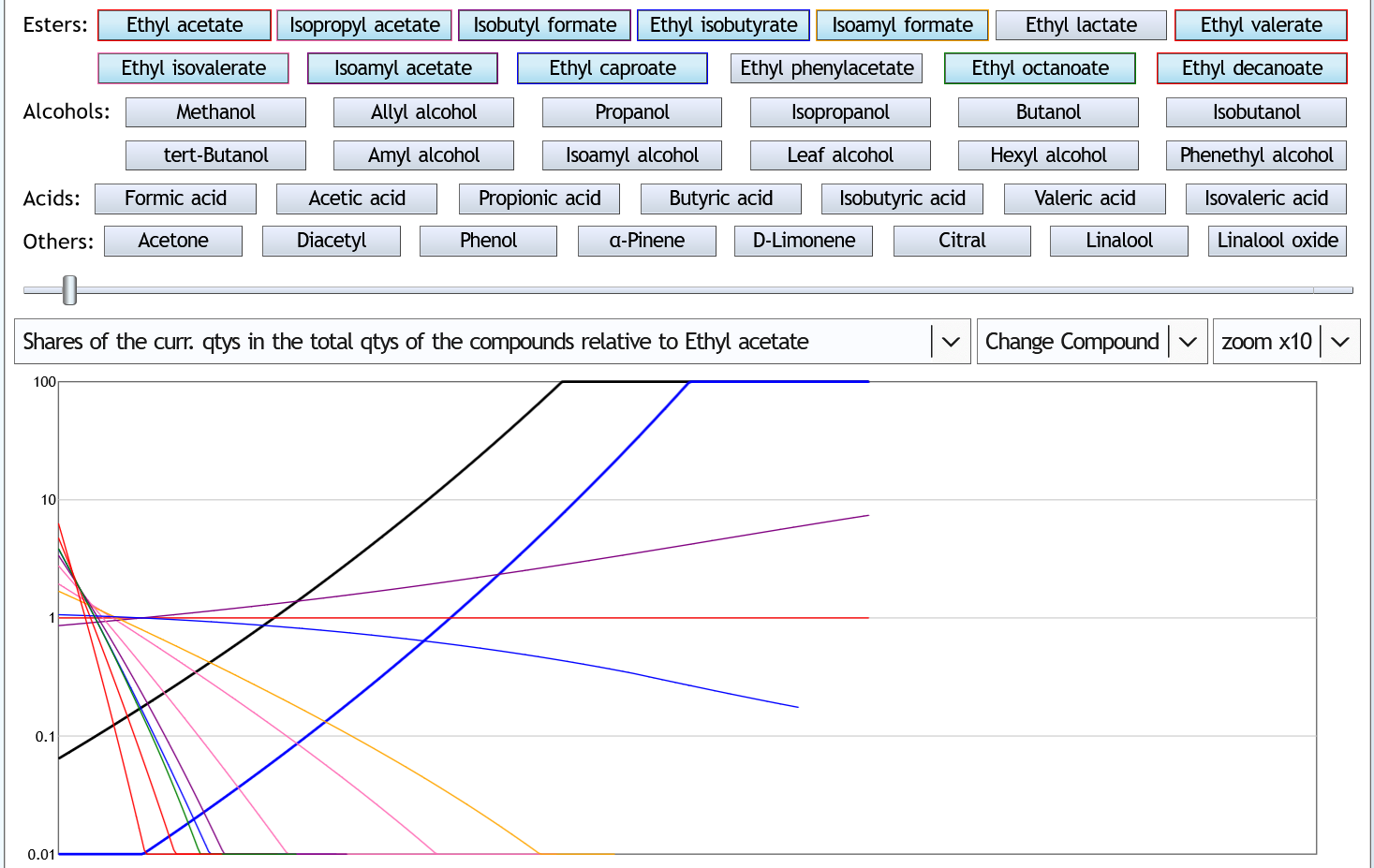 All curves start above 1, i.e. above the curve of ethyl acetate.
All curves start above 1, i.e. above the curve of ethyl acetate.
Now 40%abv (spirit run strength): At higher alcohol content, ethyl acetate (thin red line, see arrow) concentrates better than all other (more valuable) esters in the foreshots.
Other representation:
At higher alcohol content, ethyl acetate (thin red line, see arrow) concentrates better than all other (more valuable) esters in the foreshots.
Other representation:
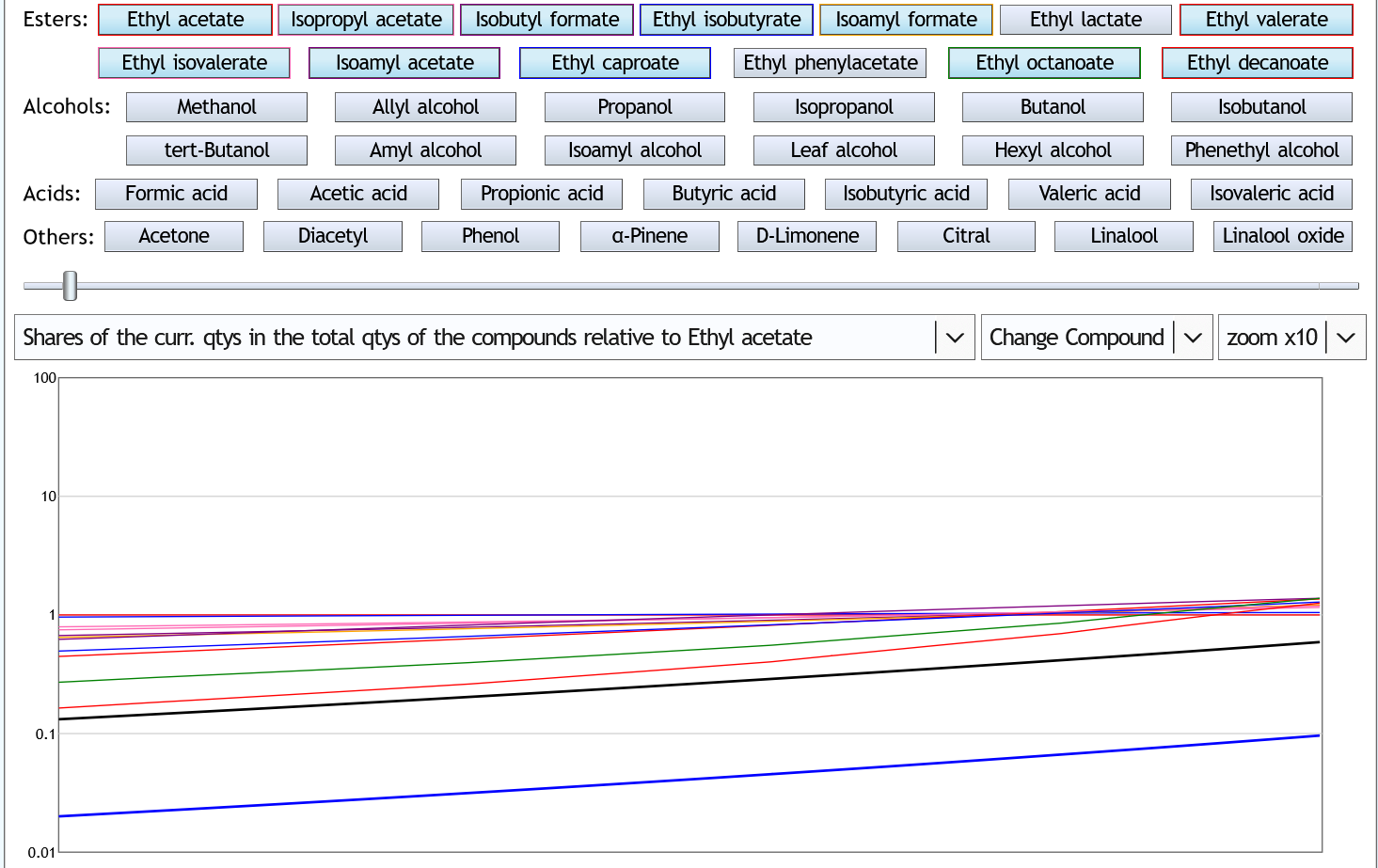 All curves start below the 1.
All curves start below the 1.
Conclusion: With regard to the esters, cutting foreshots during the stripping run is therefore also aroma-damaging.
With the Congeners Simulator 2 you can look at it a little bit different:
10lt at 8%abv.
A)
Stripping run, foreshots to 0.01lt distillate with 1.5 theor. plates, then to 2.49lt distillate with 1.1 theor. plates, foreshots not discarded.
Spirit run, foreshots to 0.02lt distillate with 1.5 theor. plates, then hearts down to current 63%abv at 1.2 theor. plates. The data of the hearts: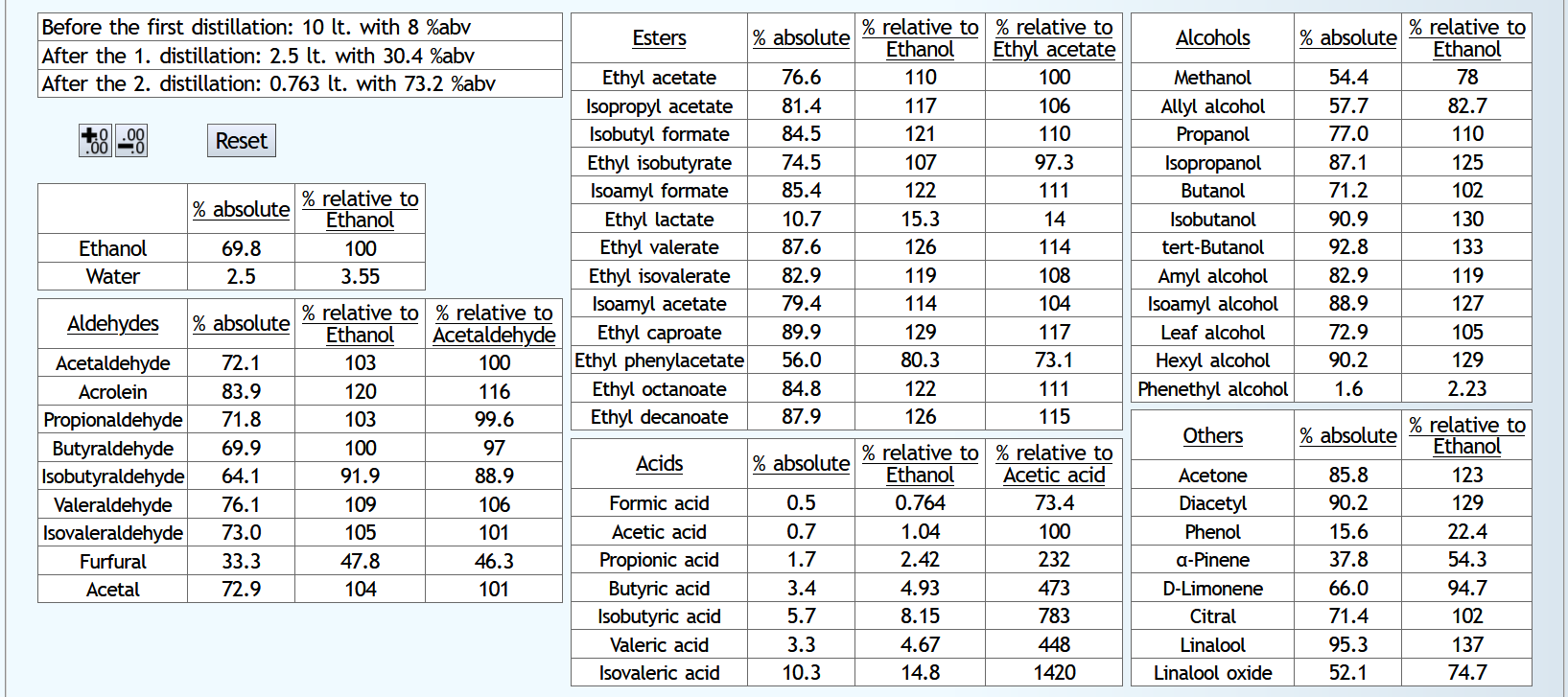 B)
B)
Stripping run, foreshots to 0.01lt distillate with 1.5 theor. plates, then to 2.49lt distillate with 1.1 theor. plates, foreshots discarded.
Spirit run, foreshots to 0.01lt distillate with 1.5 theor. plates, then hearts down to current 63%abv with 1.2 theor. plates. The data of the hearts: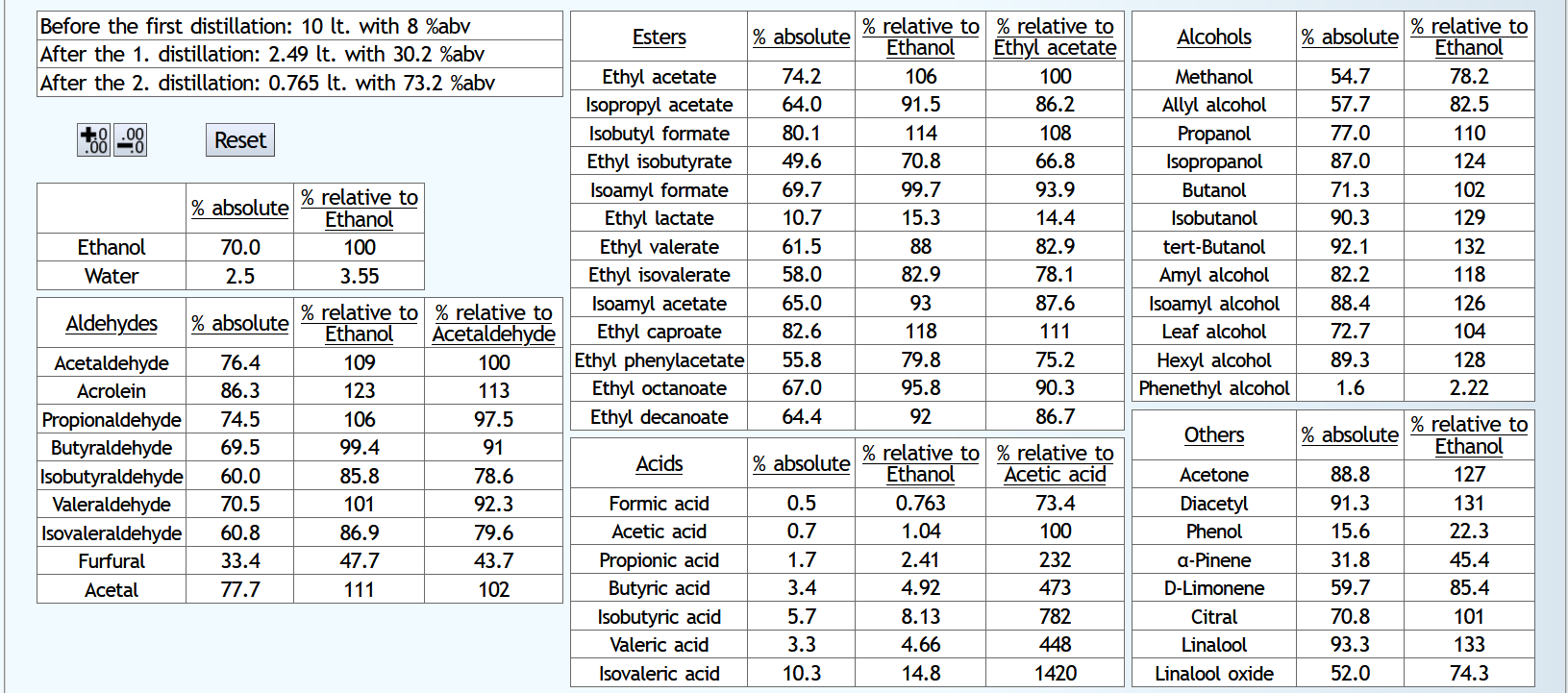 B is generally slightly more neutral.
Fewer congeners compared to ethanol.
Not necessarily so for aldehydes, but for esters.
B is generally slightly more neutral.
Fewer congeners compared to ethanol.
Not necessarily so for aldehydes, but for esters.
B is slightly lower in quality, minimally for the larger aldehydes (valeraldehyde, isovaleraldehyde) compared to acetaldehyde, and for almost all esters compared to ethyl acetate. And for some terpenes (in the "other congeners" group) it makes a difference too.
But of course this very small difference of the distillation process does not make much difference. But in general, you can already see that cutting the foreshots partially in the stripping run firstly produces a somewhat cleaner distillation, but secondly, the good aroma compounds are more likely to be cut than the bad ones.
Bottom line: if you're distilling neutral alcohol, you should use every distillation for cutting foreshots. This is because the different alcohol strength each time helps: some congeners are more likely to cut efficiently at low alcohol strength and some are more likely to cut efficiently at high alcohol strength. In the case of aroma distillations, however, only the last distillation, i.e. the one with the highest alcohol strength, should be used to cut the foreshots, since a high alcohol strength causes more bad than good congeners to end up in the foreshots.
The two main foreshots substances acetaldehyde and ethyl acetate are shown:
5%abv, 1.3 theor. plates, zoom x10:

Now 40%abv (spirit run):

Thus, removing the foreshots is somewhat more efficient overall in the stripping run than in the spirit run.
However, two points put this result into perspective:
- New foreshots can form after the stripping run. So a cut must still be done in most cases during the spirit run.
- If the spirit run is done with a reflux still, the cut is of course much more efficient: 40%abv, 6 theor. plates:

In most cases, the aim is not to lose as little ethanol as possible during the foreshots cut, but to achieve the best possible result in terms of taste. You want to cut as many bad flavors as possible, but you want to do it without cutting many good flavors as well.
And a simulation can provide answers to this question through its comparative representations by showing how the rather good and the rather bad aroma substances relate to each other within a substance group. The rather bad substances are those with low molar masses and the rather good ones are those with high molar masses. And the substances in the simulator are ordered by molar mass. So the worst (and at the same time most common) aldehyde is acetalehyde.
5%abv, 1.3 theor. plates, zoom x10 (only aldehydes typical from molecular structure or molecular formula or aldehydes comparable with acetaldehyde are shown):

Other representation:

Now 40%abv (spirit run strength):

Other view:

Conclusion: Regarding the aldehydes, a foreshots cut during the stripping run is therefore rather harmful to the aroma.
Now the esters:
5%abv, 1.3 theor. plates, zoom x10 (only esters typical of the molecular structure or molecular formula or esters comparable to ethyl acetate are shown):

Other representation:

Now 40%abv (spirit run strength):


Conclusion: With regard to the esters, cutting foreshots during the stripping run is therefore also aroma-damaging.
With the Congeners Simulator 2 you can look at it a little bit different:
10lt at 8%abv.
A)
Stripping run, foreshots to 0.01lt distillate with 1.5 theor. plates, then to 2.49lt distillate with 1.1 theor. plates, foreshots not discarded.
Spirit run, foreshots to 0.02lt distillate with 1.5 theor. plates, then hearts down to current 63%abv at 1.2 theor. plates. The data of the hearts:

Stripping run, foreshots to 0.01lt distillate with 1.5 theor. plates, then to 2.49lt distillate with 1.1 theor. plates, foreshots discarded.
Spirit run, foreshots to 0.01lt distillate with 1.5 theor. plates, then hearts down to current 63%abv with 1.2 theor. plates. The data of the hearts:

B is slightly lower in quality, minimally for the larger aldehydes (valeraldehyde, isovaleraldehyde) compared to acetaldehyde, and for almost all esters compared to ethyl acetate. And for some terpenes (in the "other congeners" group) it makes a difference too.
But of course this very small difference of the distillation process does not make much difference. But in general, you can already see that cutting the foreshots partially in the stripping run firstly produces a somewhat cleaner distillation, but secondly, the good aroma compounds are more likely to be cut than the bad ones.
Bottom line: if you're distilling neutral alcohol, you should use every distillation for cutting foreshots. This is because the different alcohol strength each time helps: some congeners are more likely to cut efficiently at low alcohol strength and some are more likely to cut efficiently at high alcohol strength. In the case of aroma distillations, however, only the last distillation, i.e. the one with the highest alcohol strength, should be used to cut the foreshots, since a high alcohol strength causes more bad than good congeners to end up in the foreshots.
Should one distill the foreshots of aroma distillates with or without rectification?
That this is more effective with rectification, i.e. that one loses less ethanol this way, is beyond question.
But is it possible that you lose more of the bad foreshot substances and less of the good ones?
The following examples are calculated with Congeners Simulator 1..
40%abv, 1 theor. plate, zoom x10: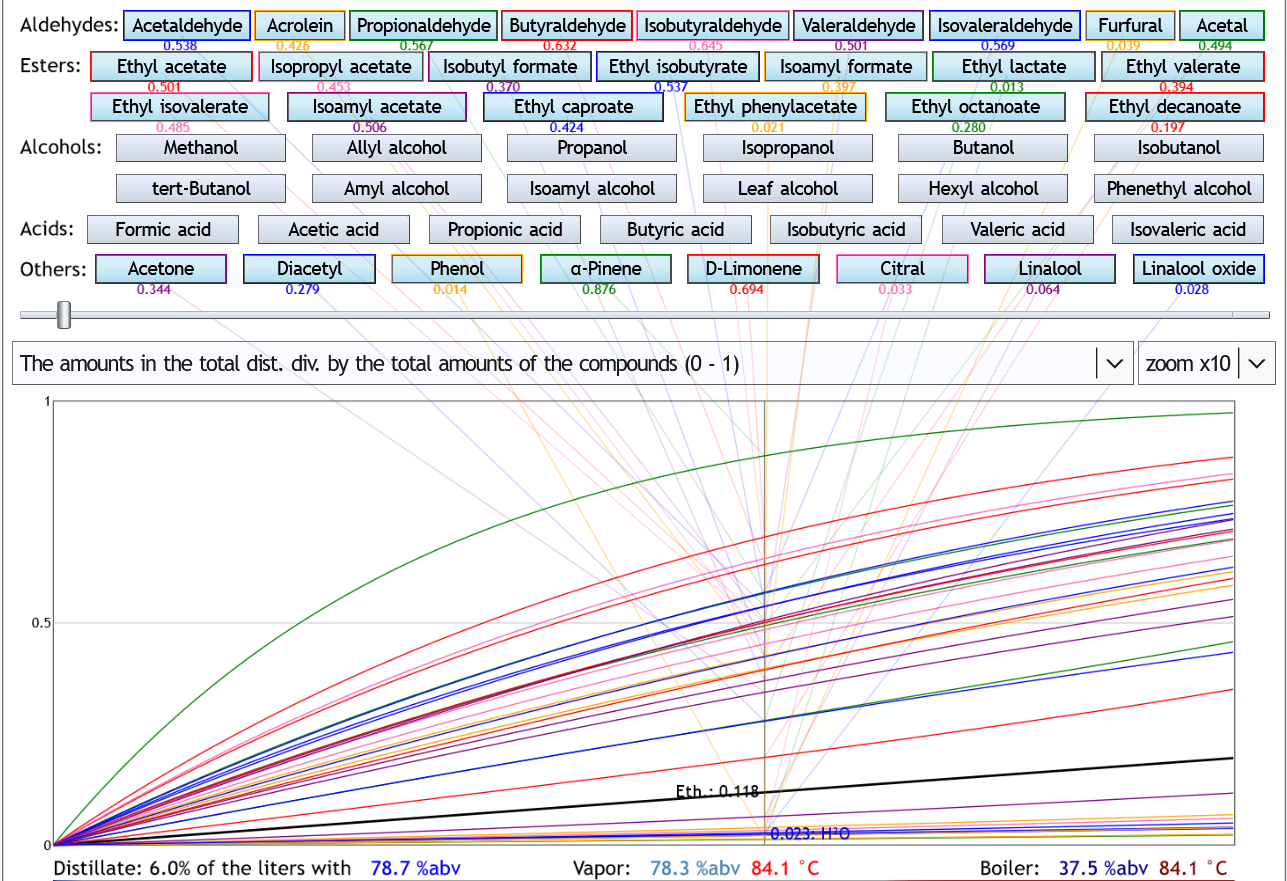 The values below the congeners are at the point where at least 50% (0.5) of both acetaldehyde and ethyl acetate are cut.
You can see how even from valuable substances much has already entered the foreshots.
The values below the congeners are at the point where at least 50% (0.5) of both acetaldehyde and ethyl acetate are cut.
You can see how even from valuable substances much has already entered the foreshots.
Now with 6 theor. plates: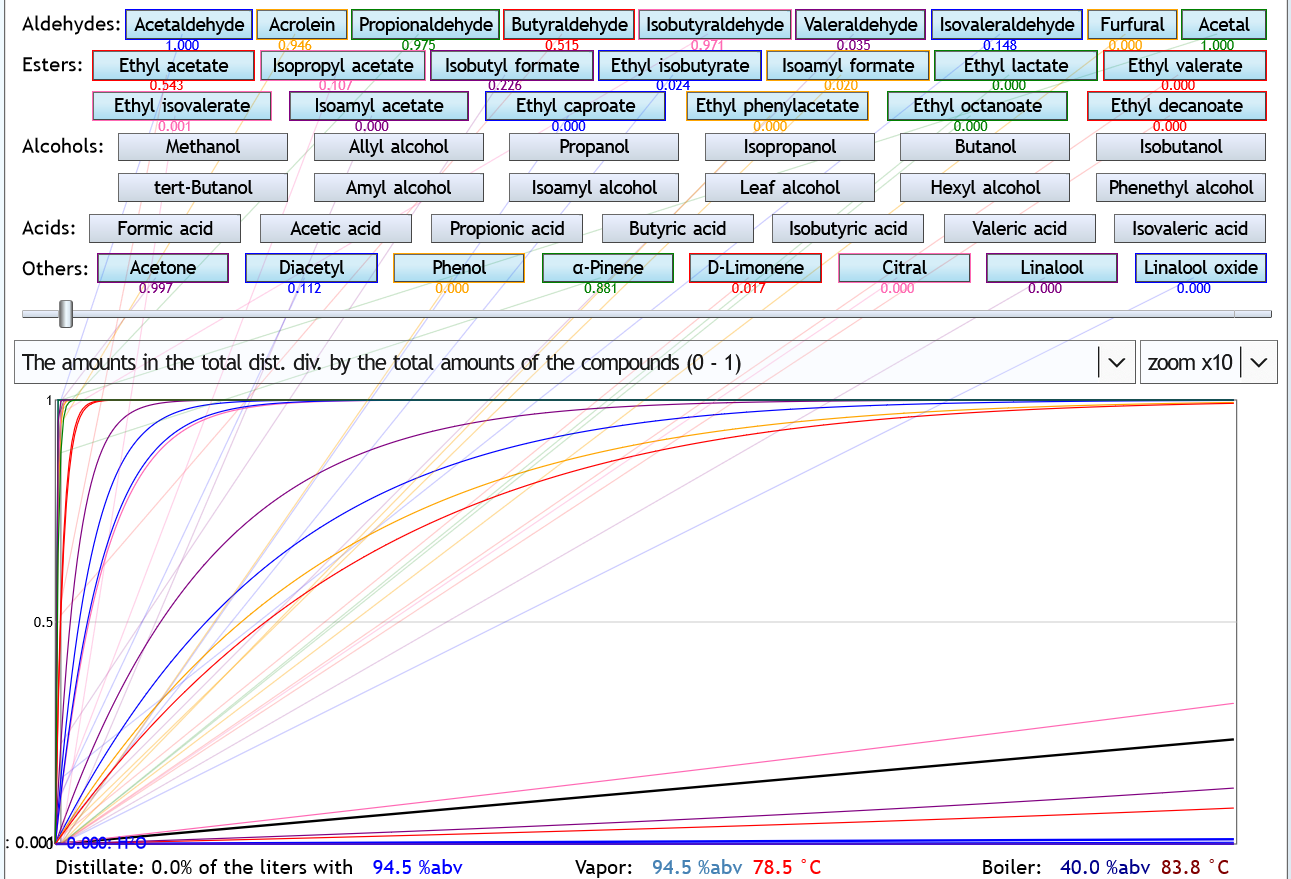 The values are there, where also at least 50% of ethyl acetate was removed as without rectification.
Acetaldehyde is already 100% cut.
Bad congeners like acrolein or acetone are now also cut much more effectively with the foreshots.
Valuable congeners such as the large aldehydes, the large esters and the citrus ketones and terpenes (and thus probably also other valuable ketones and terpenes, of which we unfortunately have no data) in the bottom row on the right are spared.
The values are there, where also at least 50% of ethyl acetate was removed as without rectification.
Acetaldehyde is already 100% cut.
Bad congeners like acrolein or acetone are now also cut much more effectively with the foreshots.
Valuable congeners such as the large aldehydes, the large esters and the citrus ketones and terpenes (and thus probably also other valuable ketones and terpenes, of which we unfortunately have no data) in the bottom row on the right are spared.
For clarity, the acids are not shown. This is because they have nothing to do with the foreshots in any case. Also not shown are the higher alcohols. In this case, they would be cut by 15% on average without rectification and almost not at all with rectification. Here is a small advantage of cutting foreshots without reflux.
With the calculator Congeners - Fractions Simulator this can also be illustrated very well:
This calculates a distillation completely and then shows values of the congeners. The length of the displayed fraction can be adjusted with a slider and thus comparisons regarding the fraction length can be made very quickly. Here is a table of foreshots cuts with different levels of rectification and different levels of alcohol strength in the boiler:
Four different initial alcohol strengths and three different rectification levels. Cut when the sum of the acetaldehyde and ethyl acetate (i.e., the two major foreshots compounds) equals 180%. Indicated are how much % of the alcohol one loses in the foreshots ("%Eth") and how much % of the three valuable esters ethyl caproate, ethyl caprylate and ethyl caprinate ("%C") on average (i.e. the sum of the three values divided by three), which should not end up in the foreshots if possible.
You can see that you get the best results with the highest possible rectification (least %Eth and least %C is in the fores). This is not a surprise. But what is surprising is that high %abv in the boiler results in losing more alcohol to cut the required amount of acetaldehyde and ethyl acetate. If you take a closer look at the values in the fraction simulator, you will notice that the problem is ethyl acetate. This is generally very difficult to cut at high percentages alcohol in the Boiler. So the acetaldehyde can be cut very well at high %abv, but the ethyl acetate cannot. In general, esters are difficult to cut at high %abv in the boiler. Therefore, more of the good esters are lost when the %abv in the boiler is low. At high rectification, however, this no longer makes much difference.
With the Congeners Simulator 2 you can have a very good look at the final result, depending on whether you rectify the foreshots during the spirit run or not:
Spirit run with 10lt 30%abv.
Since the foreshots are of course much more concentrated when rectified, less of it has to be cut when distilling with rectification so that the results are comparable at the end:
A)
Foreshots 0.2lt with 1.5 theor. plates. Then hearts down to current 63%abv with 1.2 theor. plates. The hearts then looks like this: B)
B)
Foreshots 0.02lt with 6 theor. plates. Then hearts down to current 63%abv with 1.2 theor. plates. The hearts then looks like this: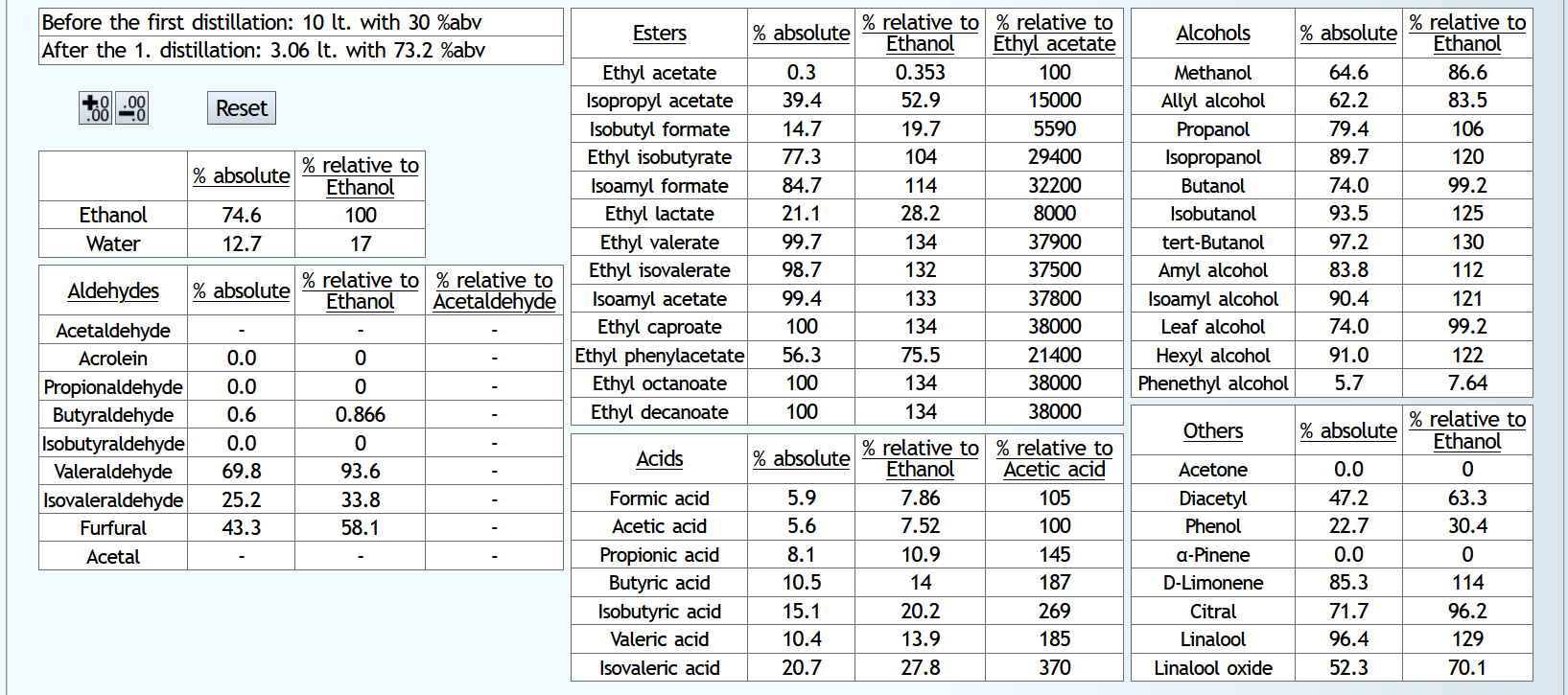 With rectification the smaller, bad aldehydes are almost completely gone.
However, similar amounts of the valuable ones are still present compared to distillation without rectification of the foreshots.
With rectification, ethyl acetate is almost completely gone, without only half.
Further down, the large, good esters are partly completely in the hearts with rectification, without rectification only about 60% on average.
There are hardly any differences in the acids and alcohols.
With rectification, acetone is removed.
Diacetyl is halved.
Unfortunately, a-pinene is cut even better.
But some of the other terpenes are brought into the hearts much more.
And of course you have a higher ethanol yield if you cut the foreshots in a more concentrated way.
With rectification the smaller, bad aldehydes are almost completely gone.
However, similar amounts of the valuable ones are still present compared to distillation without rectification of the foreshots.
With rectification, ethyl acetate is almost completely gone, without only half.
Further down, the large, good esters are partly completely in the hearts with rectification, without rectification only about 60% on average.
There are hardly any differences in the acids and alcohols.
With rectification, acetone is removed.
Diacetyl is halved.
Unfortunately, a-pinene is cut even better.
But some of the other terpenes are brought into the hearts much more.
And of course you have a higher ethanol yield if you cut the foreshots in a more concentrated way.
So the rectification of the foreshots is beneficial in most cases. Especially with the esters.
This also means that rectification of the foreshots can solve problems with distillation methods that offer advantages in other aspects, such as the amount of acids, but in the case of the esters and aldehydes are not optimal. So potstill multiple distillation. So if you have the possibility to rectify the foreshots, you can focus on other things when choosing the distillation method.
Conclusion: All in all, it is quite obvious that a foreshots cut with rectification is not only more effective but also of better quality.
40%abv, 1 theor. plate, zoom x10:

Now with 6 theor. plates:

For clarity, the acids are not shown. This is because they have nothing to do with the foreshots in any case. Also not shown are the higher alcohols. In this case, they would be cut by 15% on average without rectification and almost not at all with rectification. Here is a small advantage of cutting foreshots without reflux.
With the calculator Congeners - Fractions Simulator this can also be illustrated very well:
This calculates a distillation completely and then shows values of the congeners. The length of the displayed fraction can be adjusted with a slider and thus comparisons regarding the fraction length can be made very quickly. Here is a table of foreshots cuts with different levels of rectification and different levels of alcohol strength in the boiler:
| Boiler | 1 theor. plate | 2 theor. plates | 4 theor. plates |
| 5%abv | 36.1%Eth 98.5%C | 7.1%Eth 97.0%C | 0.5%Eth 1.6%C |
| 15%abv | 32.7%Eth 98.0%C | 7.8%Eth 61.5%C | 0.7%Eth 0.4%C |
| 35%abv% | 31.3%Eth 93.9%C | 12.2%Eth 18.7%C | 1.3%Eth 0.1%C |
| 60%abv% | 37.5%Eth 34.2%C | 13.8%Eth 4.5%C | 2.2%Eth 0.0%C |
Four different initial alcohol strengths and three different rectification levels. Cut when the sum of the acetaldehyde and ethyl acetate (i.e., the two major foreshots compounds) equals 180%. Indicated are how much % of the alcohol one loses in the foreshots ("%Eth") and how much % of the three valuable esters ethyl caproate, ethyl caprylate and ethyl caprinate ("%C") on average (i.e. the sum of the three values divided by three), which should not end up in the foreshots if possible.
You can see that you get the best results with the highest possible rectification (least %Eth and least %C is in the fores). This is not a surprise. But what is surprising is that high %abv in the boiler results in losing more alcohol to cut the required amount of acetaldehyde and ethyl acetate. If you take a closer look at the values in the fraction simulator, you will notice that the problem is ethyl acetate. This is generally very difficult to cut at high percentages alcohol in the Boiler. So the acetaldehyde can be cut very well at high %abv, but the ethyl acetate cannot. In general, esters are difficult to cut at high %abv in the boiler. Therefore, more of the good esters are lost when the %abv in the boiler is low. At high rectification, however, this no longer makes much difference.
With the Congeners Simulator 2 you can have a very good look at the final result, depending on whether you rectify the foreshots during the spirit run or not:
Spirit run with 10lt 30%abv.
Since the foreshots are of course much more concentrated when rectified, less of it has to be cut when distilling with rectification so that the results are comparable at the end:
A)
Foreshots 0.2lt with 1.5 theor. plates. Then hearts down to current 63%abv with 1.2 theor. plates. The hearts then looks like this:

Foreshots 0.02lt with 6 theor. plates. Then hearts down to current 63%abv with 1.2 theor. plates. The hearts then looks like this:

So the rectification of the foreshots is beneficial in most cases. Especially with the esters.
This also means that rectification of the foreshots can solve problems with distillation methods that offer advantages in other aspects, such as the amount of acids, but in the case of the esters and aldehydes are not optimal. So potstill multiple distillation. So if you have the possibility to rectify the foreshots, you can focus on other things when choosing the distillation method.
Conclusion: All in all, it is quite obvious that a foreshots cut with rectification is not only more effective but also of better quality.
How far down should one distill stripping runs?
The question is whether it makes sense in terms of taste to extend stripping runs beyond the point where no more alcohol comes.
Or, on the contrary, to stop already because of the quality, although it would still be worthwhile to continue distilling in terms of alcohol yield.
The following examples are calculated with the Congeners Simulator 2, which can calculate several distillations in a row and output the results as tables.
Carboxylic acids are mainly to blame for the bad smell and taste of tails. They are something you actually want to have as little as possible in the final distillate. On the other hand, they are precursors of esters. And the larger the acid molecules, the better the esters. Also the acids are arranged in the calculators according to the molecular size. So it is true that the acids which are further down in the simulator are the more valuable ones. But this counts only regarding their aroma when esterified. At the top, formic acid occurs quite rarely, while the second highest, acetic acid, is by far the most common. These top two are now considered the bad ones here. Those further down as the good ones, although unesterified they are clearly detrimental to taste. When acids esterify at some point between the stripping run and the spirit run, or during the spirit run, these esters end up mostly in the foreshots/heads and the hearts. And the acids that do not esterify are then cut off as completely as possible as tails during the spirit run. At least, that is the plan. Only if you can cut the acids well during the spirit run, it makes sense to collect more of them during the stripping run.
10lt wash with 8%abv:
A)
Stripping run up to 2.5lt, so a rather short stripping run, with 1.1 theor. plates, so quite fast with an isolated still. Then at the spirit run 0.03lt with 1.5 theor. plates foreshots, hearts with 1.3 theor. plates down to current 65%abv: B)
B)
Stripping run up to 3.5lt, so a long stripping run, also with 1.1 theor. plates. Then for the spirit run the same foreshots, hearts down to current 60%abv. 60 instead of 65%abv hearts end, because the alcohol content of the stripping run is lower: The short stripping run results in less bad and more good aldehydes at the end.
And more of the good esters.
Slightly less higher alcohols and significantly less acids.
So it's cleaner despite the higher alcohol yield.
So it looks like you get more flavor with the double distillation with a long spirit run, but tends to get a little more bad flavors than good ones.
The short stripping run results in less bad and more good aldehydes at the end.
And more of the good esters.
Slightly less higher alcohols and significantly less acids.
So it's cleaner despite the higher alcohol yield.
So it looks like you get more flavor with the double distillation with a long spirit run, but tends to get a little more bad flavors than good ones.
However, the long stripping run causes you to end up with proportionately a bit more of the big, interesting acids. So here's a better potential for esterification, though also a risk that the distillation ends up too harsh, even if you end the hearts relatively early.
Phenol may also be interesting: this is significantly more present after the long stripping run, 28.1 instead of 20.5% compared to ethanol. So for a wash with peated malt, a long stripping run results in a higher peat content in the Whisky.
The following examples are calculated with the Congeners Simulator 2, which can calculate several distillations in a row and output the results as tables.
Carboxylic acids are mainly to blame for the bad smell and taste of tails. They are something you actually want to have as little as possible in the final distillate. On the other hand, they are precursors of esters. And the larger the acid molecules, the better the esters. Also the acids are arranged in the calculators according to the molecular size. So it is true that the acids which are further down in the simulator are the more valuable ones. But this counts only regarding their aroma when esterified. At the top, formic acid occurs quite rarely, while the second highest, acetic acid, is by far the most common. These top two are now considered the bad ones here. Those further down as the good ones, although unesterified they are clearly detrimental to taste. When acids esterify at some point between the stripping run and the spirit run, or during the spirit run, these esters end up mostly in the foreshots/heads and the hearts. And the acids that do not esterify are then cut off as completely as possible as tails during the spirit run. At least, that is the plan. Only if you can cut the acids well during the spirit run, it makes sense to collect more of them during the stripping run.
10lt wash with 8%abv:
A)
Stripping run up to 2.5lt, so a rather short stripping run, with 1.1 theor. plates, so quite fast with an isolated still. Then at the spirit run 0.03lt with 1.5 theor. plates foreshots, hearts with 1.3 theor. plates down to current 65%abv:

Stripping run up to 3.5lt, so a long stripping run, also with 1.1 theor. plates. Then for the spirit run the same foreshots, hearts down to current 60%abv. 60 instead of 65%abv hearts end, because the alcohol content of the stripping run is lower:

However, the long stripping run causes you to end up with proportionately a bit more of the big, interesting acids. So here's a better potential for esterification, though also a risk that the distillation ends up too harsh, even if you end the hearts relatively early.
Phenol may also be interesting: this is significantly more present after the long stripping run, 28.1 instead of 20.5% compared to ethanol. So for a wash with peated malt, a long stripping run results in a higher peat content in the Whisky.
How far down should one collect tails in spirit runs?
The following examples are calculated with Congeners Simulator 2.
30%abv in the boiler, spirit run with 1.3 theor. plates, hearts end at 65%abv in the vapor. Then tails collection with 1 theor. plate only, down to 20abv% in the vapor. The acids in the tails then look like this: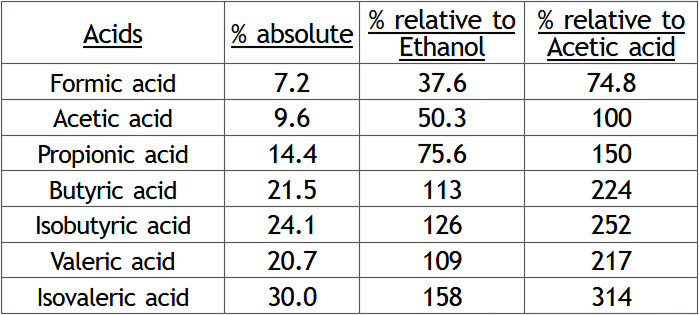 Now the same, but tails collected down to 5%abv in vapor:
Now the same, but tails collected down to 5%abv in vapor:
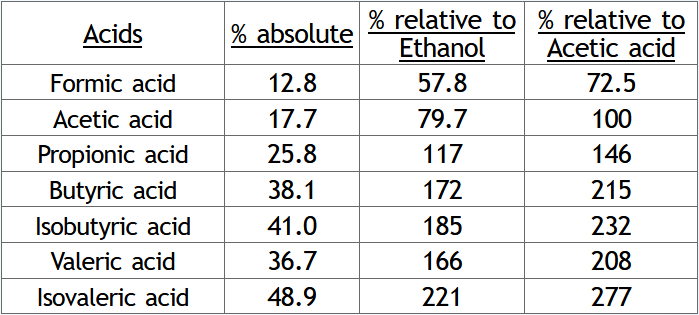 And now the same, but tails collected down to 0.1%abv in vapor:
And now the same, but tails collected down to 0.1%abv in vapor:
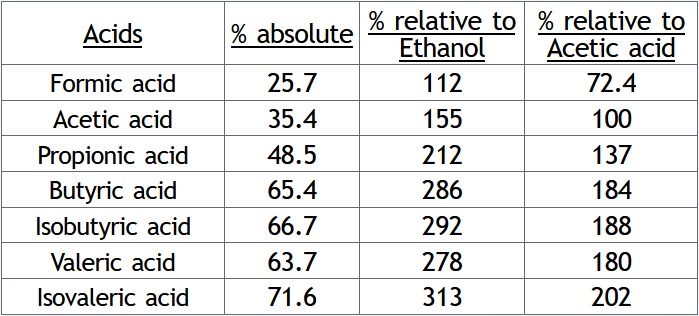 As expected, of course, the absolute amounts of acids increase when you collect tails longer.
And also as expected, the acids increase relative to the ethanol yield.
More exciting is the third table column "% relative to acetic acid":
Here you can see how the ratio of the acids to each other changes.
The longer you collect tails, the more you get acids with small molecular masses.
For example, less and less valeric and isovaleric acid and more and more acetic acid.
The larger acids have the potential to form very interesting esters.
The small acetic acid, on the other hand, mainly just ethyl acetate, which is a glue-like odor.
As expected, of course, the absolute amounts of acids increase when you collect tails longer.
And also as expected, the acids increase relative to the ethanol yield.
More exciting is the third table column "% relative to acetic acid":
Here you can see how the ratio of the acids to each other changes.
The longer you collect tails, the more you get acids with small molecular masses.
For example, less and less valeric and isovaleric acid and more and more acetic acid.
The larger acids have the potential to form very interesting esters.
The small acetic acid, on the other hand, mainly just ethyl acetate, which is a glue-like odor.
Conclusion: If you collect the tails in order to use them as aroma booster at some point, a long tails collection causes that you collect a lot of acids, so finally the aroma is then also very strongly promoted, but rather then with less interesting aromas. But of course this is also a question of taste.
In the following spirit run with the tails in the boiler, however, the bad esters can be cut very well with a rectification of the foreshots. And with a fairly high initial alcohol strength in the boiler and a relatively early tails cut, the excess acids can also be removed. So you can take the advantages of the large number of acids through the long tails collection and reduce the disadvantages that arise..
If the only goal of tails collection is to distill the alcohol to neutral at some point, then the greater expense of collecting and purging it of the excess acids will determine how long to distill.
30%abv in the boiler, spirit run with 1.3 theor. plates, hearts end at 65%abv in the vapor. Then tails collection with 1 theor. plate only, down to 20abv% in the vapor. The acids in the tails then look like this:



Conclusion: If you collect the tails in order to use them as aroma booster at some point, a long tails collection causes that you collect a lot of acids, so finally the aroma is then also very strongly promoted, but rather then with less interesting aromas. But of course this is also a question of taste.
In the following spirit run with the tails in the boiler, however, the bad esters can be cut very well with a rectification of the foreshots. And with a fairly high initial alcohol strength in the boiler and a relatively early tails cut, the excess acids can also be removed. So you can take the advantages of the large number of acids through the long tails collection and reduce the disadvantages that arise..
If the only goal of tails collection is to distill the alcohol to neutral at some point, then the greater expense of collecting and purging it of the excess acids will determine how long to distill.
Is there a valuable fraction after the tails?
Every now and then one reads that a fraction is still collected after the tails.
This can then be used as dilution water.
For this, of course, it must be better than the tails distilled off before.
This fraction is often called "sweet water" or e.g. in Arroyo's writings about rum production "fifth fraction" (foreshots, heads, hearts and tails are fractions 1-4).
This fraction is said to be better than the one before it, especially sweeter, or perhaps less sour is meant.
What tastes so bad in the tails are mainly acids like acetic acid or butyric acid. The question now is whether these acids are distilled off at some point, so that an acid-free distillate comes afterwards. If not, then a late fraction, which can really be mixed directly into the final product, is unthinkable.
The following examples are calculated with the Congeners Simulator 1. 30%abv, 1 theor. plate: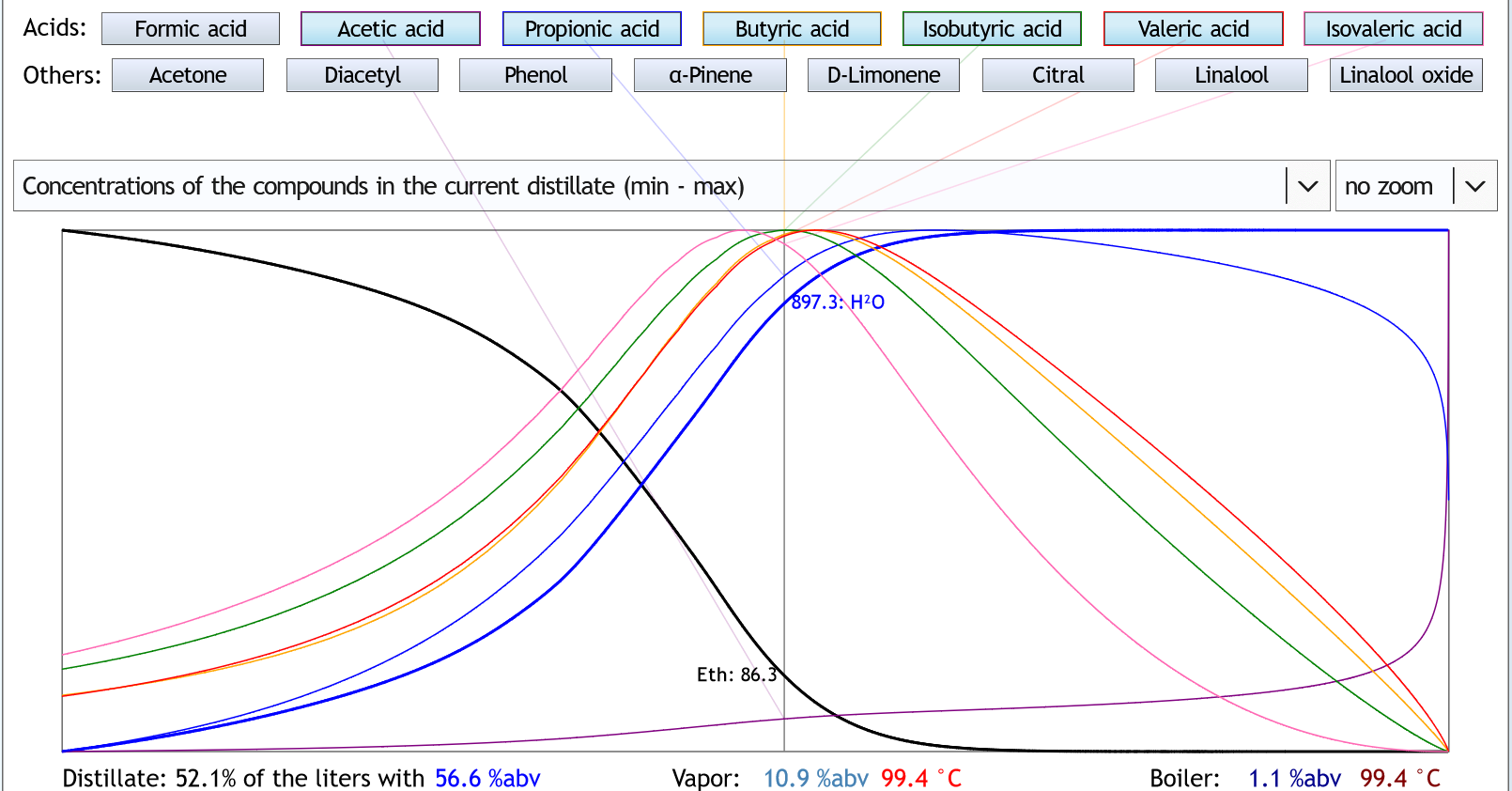 The peak of the acids with high molecular mass is in a range where there is still alcohol in the vapor.
Something like 11%abv in the vapor.
Usually that's during the tails.
And the acetic acid (small molecular mass) is rising slowly but steadily.
The y-axis of this graph goes from the calculated minimum value to the calculated maximum value of that congener.
So each congener has a different y-axis.
Acetic acid is normally by far the main part of the acids.
Therefore, the slow increase of the acetic acid means a greater acidification of the distillate than the omission of the major acids means a reduction of the acidification.
It cannot be said that the distillate becomes less acidic after the peak.
It can be said that the large acids are less represented in the fraction after the tails than before.
So their penetrating smell (much worse than that of acetic acid) is found mainly towards the end of the tails, not in the distillate after.
The peak of the acids with high molecular mass is in a range where there is still alcohol in the vapor.
Something like 11%abv in the vapor.
Usually that's during the tails.
And the acetic acid (small molecular mass) is rising slowly but steadily.
The y-axis of this graph goes from the calculated minimum value to the calculated maximum value of that congener.
So each congener has a different y-axis.
Acetic acid is normally by far the main part of the acids.
Therefore, the slow increase of the acetic acid means a greater acidification of the distillate than the omission of the major acids means a reduction of the acidification.
It cannot be said that the distillate becomes less acidic after the peak.
It can be said that the large acids are less represented in the fraction after the tails than before.
So their penetrating smell (much worse than that of acetic acid) is found mainly towards the end of the tails, not in the distillate after.
Other representation: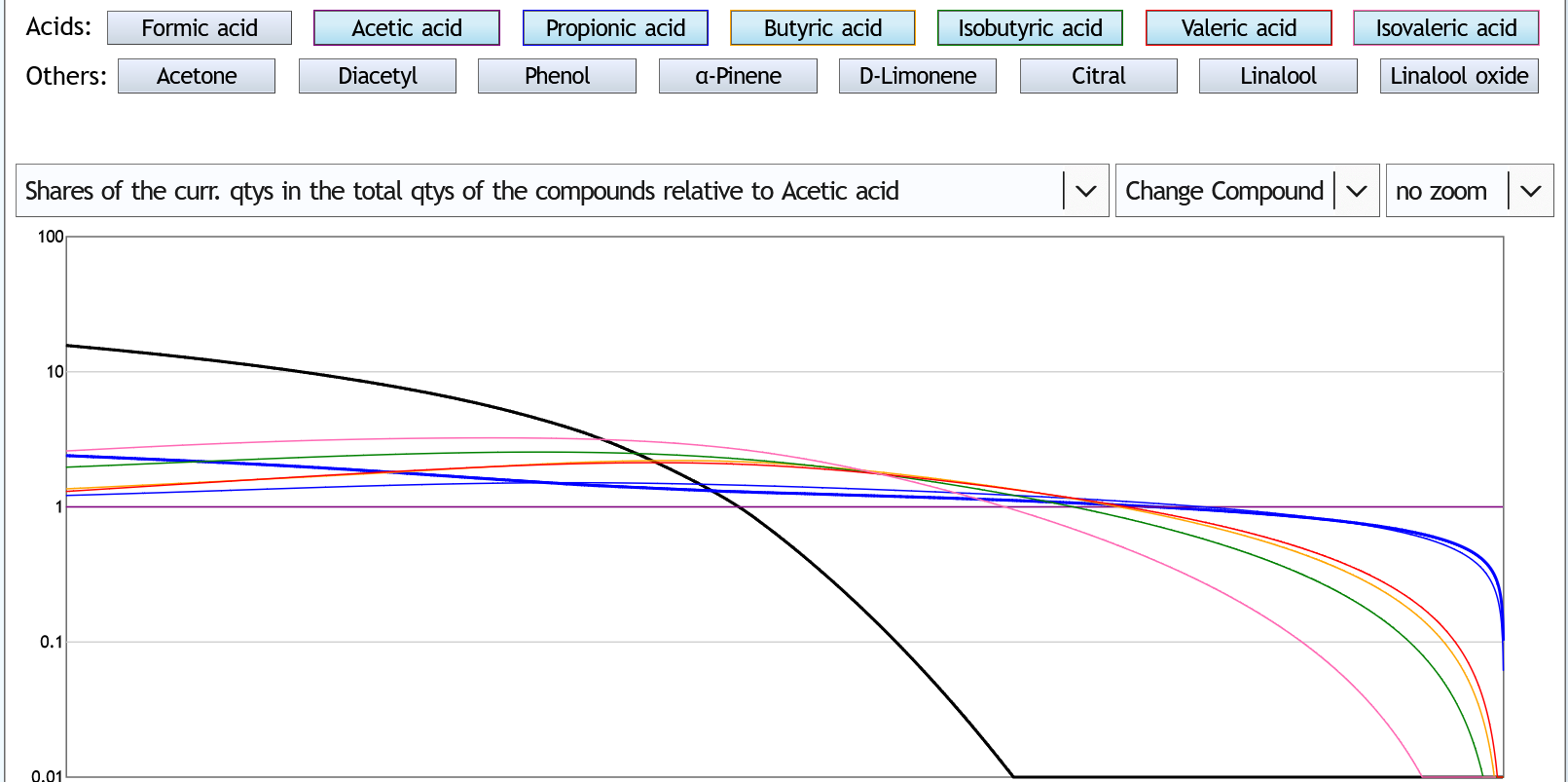 Here you can see the ratio between actual acetic acid and the other acids.
The gap slowly increases at first.
At about 50%abv in the vapor, so probably right at the beginning of the tails, it is largest.
Then the values converge.
And about when you have distilled 70% of the still contents, so in the fraction after the tails, the curves cross the line from the acetic acid.
So from there on, you collect proportionally less major acids than acetic acid compared to the ratios before distillation.
Here you can see the ratio between actual acetic acid and the other acids.
The gap slowly increases at first.
At about 50%abv in the vapor, so probably right at the beginning of the tails, it is largest.
Then the values converge.
And about when you have distilled 70% of the still contents, so in the fraction after the tails, the curves cross the line from the acetic acid.
So from there on, you collect proportionally less major acids than acetic acid compared to the ratios before distillation.
Now let's see if some rectification changes anything. 1.3 theor.plates: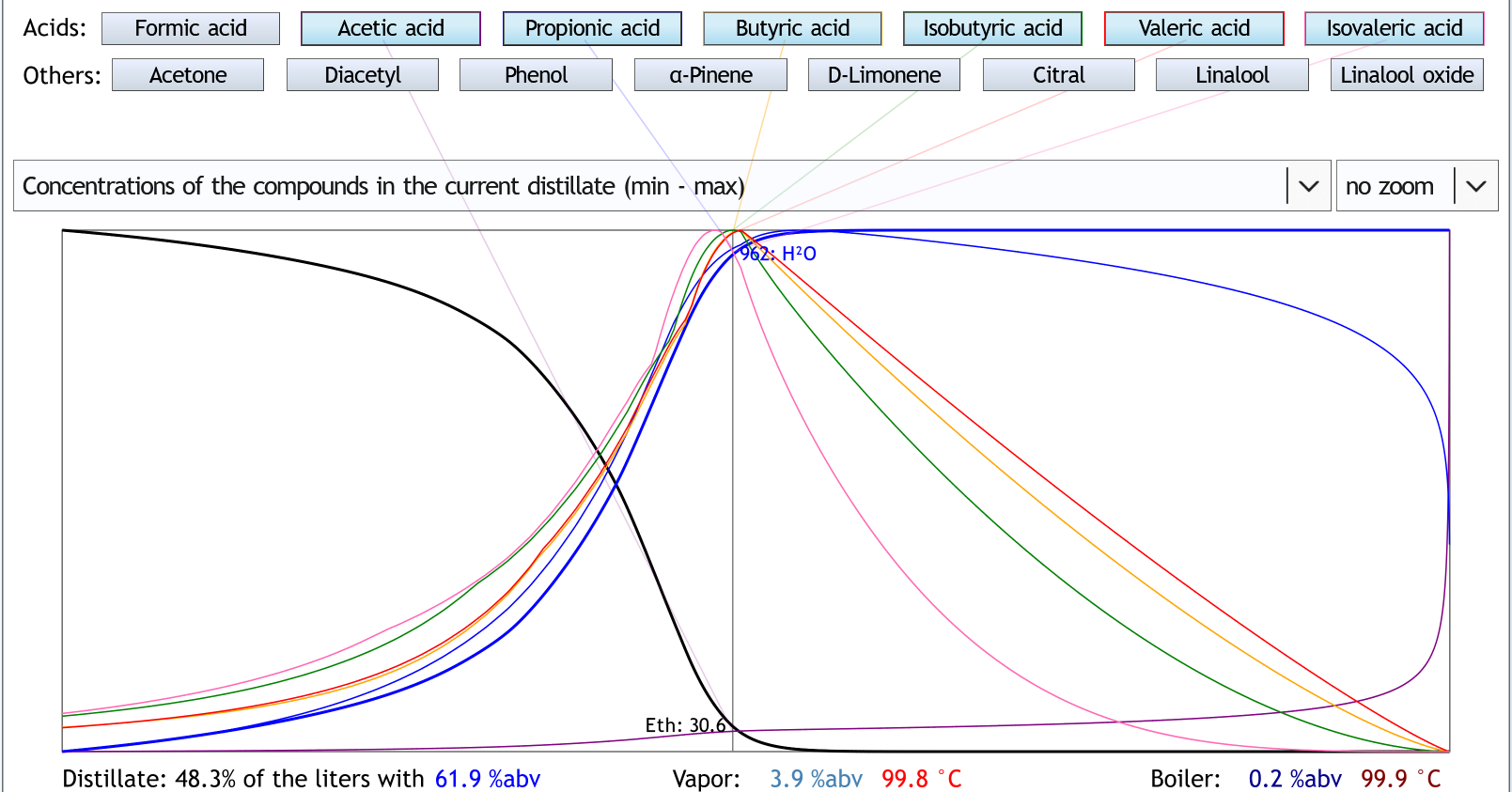
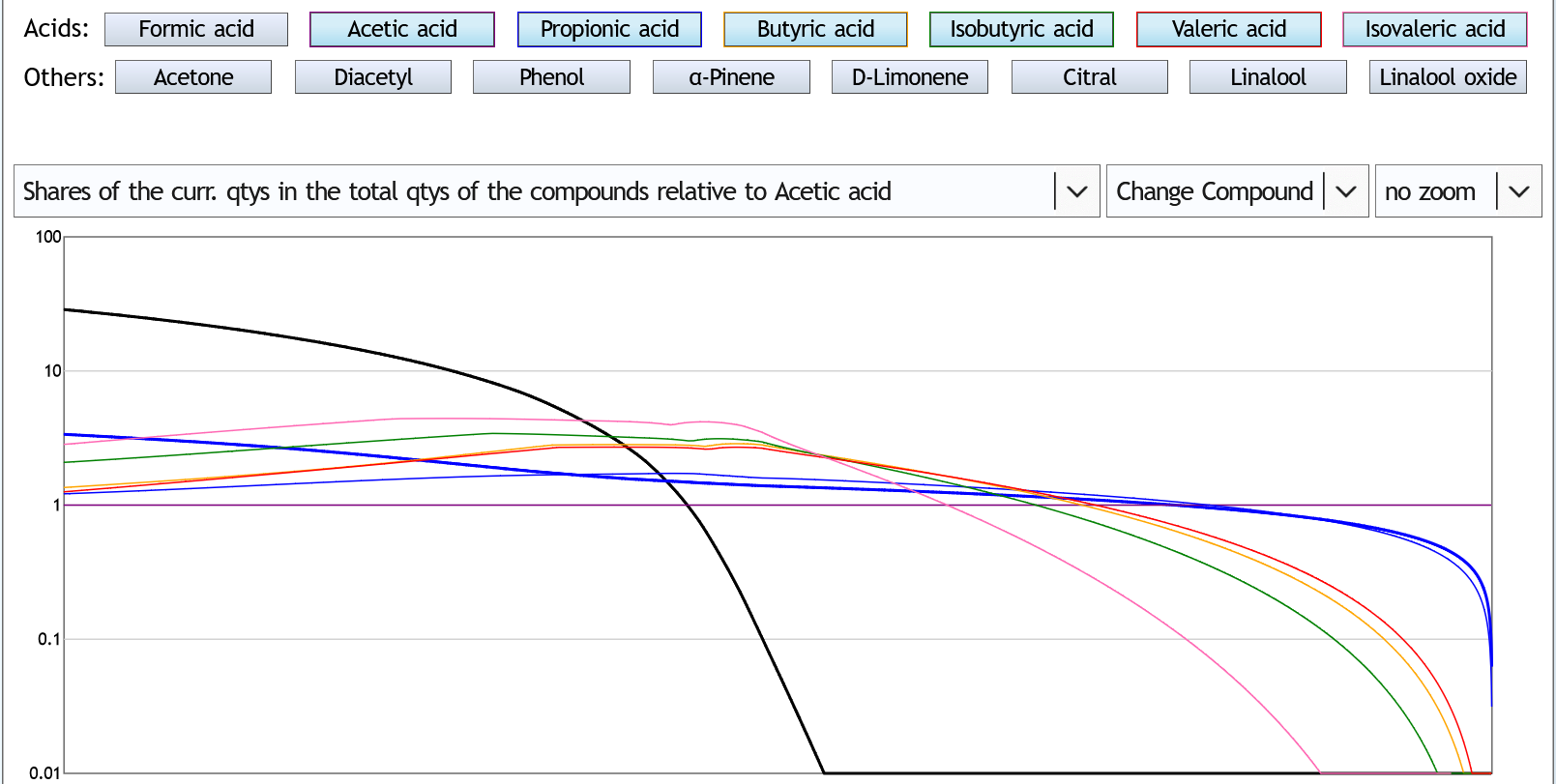 The peak of the large acids is more acute and later, at about 4%abv in the vapor.
But this does not change much in principle.
Only the point from which the large acids appear is later, and the point from which they disappear is earlier.
In relation to the question, this means that rectification compresses the fraction loaded with large acids.
So it is more unpalatable, but shorter.
The peak of the large acids is more acute and later, at about 4%abv in the vapor.
But this does not change much in principle.
Only the point from which the large acids appear is later, and the point from which they disappear is earlier.
In relation to the question, this means that rectification compresses the fraction loaded with large acids.
So it is more unpalatable, but shorter.
In summary, we can say that there is a fraction after the tails, which is fundamentally different from the one before, because it shows a development that was not there before: the disappearance of the large acids. This means a disappearance of very ugly smells. This fraction is very late. But the term "sweet water" is misleading, because the steady increase of the acetic acid content means a steady rise in acidity until the boiler is distilled empty. Perhaps the better smell of the fraction after the tails lets us think this fraction also tastes better.
However: because of the general rule that the volatility of the congeners is higher in water than in alcohol, it is impossible that a substance that enters the distillate very late in the spirit run, then has a clearly perceptible odor in the glass (that is, at drinking alcohol strength). The alcohol ensures that the acids remain in the liquor, so they do not come to the nose. So the fraction after the tails can only add to the liquor a taste not perceived by the nose, or perhaps just a mouthfeel.
And long-term effects, namely that acids esterify during storage, is rather an argument against using the fraction after the tails. This is because the acetic acid predominant in this fraction does not form as interesting esters as the larger acids discarded with the tails.
What tastes so bad in the tails are mainly acids like acetic acid or butyric acid. The question now is whether these acids are distilled off at some point, so that an acid-free distillate comes afterwards. If not, then a late fraction, which can really be mixed directly into the final product, is unthinkable.
The following examples are calculated with the Congeners Simulator 1. 30%abv, 1 theor. plate:

Other representation:

Now let's see if some rectification changes anything. 1.3 theor.plates:


In summary, we can say that there is a fraction after the tails, which is fundamentally different from the one before, because it shows a development that was not there before: the disappearance of the large acids. This means a disappearance of very ugly smells. This fraction is very late. But the term "sweet water" is misleading, because the steady increase of the acetic acid content means a steady rise in acidity until the boiler is distilled empty. Perhaps the better smell of the fraction after the tails lets us think this fraction also tastes better.
However: because of the general rule that the volatility of the congeners is higher in water than in alcohol, it is impossible that a substance that enters the distillate very late in the spirit run, then has a clearly perceptible odor in the glass (that is, at drinking alcohol strength). The alcohol ensures that the acids remain in the liquor, so they do not come to the nose. So the fraction after the tails can only add to the liquor a taste not perceived by the nose, or perhaps just a mouthfeel.
And long-term effects, namely that acids esterify during storage, is rather an argument against using the fraction after the tails. This is because the acetic acid predominant in this fraction does not form as interesting esters as the larger acids discarded with the tails.
Neutral alcohol double distillation with or without dilution between the distillations?
The following example is calculated with the Congeners Simulator 2.
10lt with 8%abv.
To get a clear result, only a small amount of foreshots is cut, not too much rectification is used and the hearts end is quite late.
A)
Stripping run: up to 2.5lt with 1.1 theor. plates.
Spirit run: 0.03lt foreshots with 6 theor. plates. Then hearts until 90% of the alcohol is distilled; also with 6 theor. plates.
The calculation result for the hearts: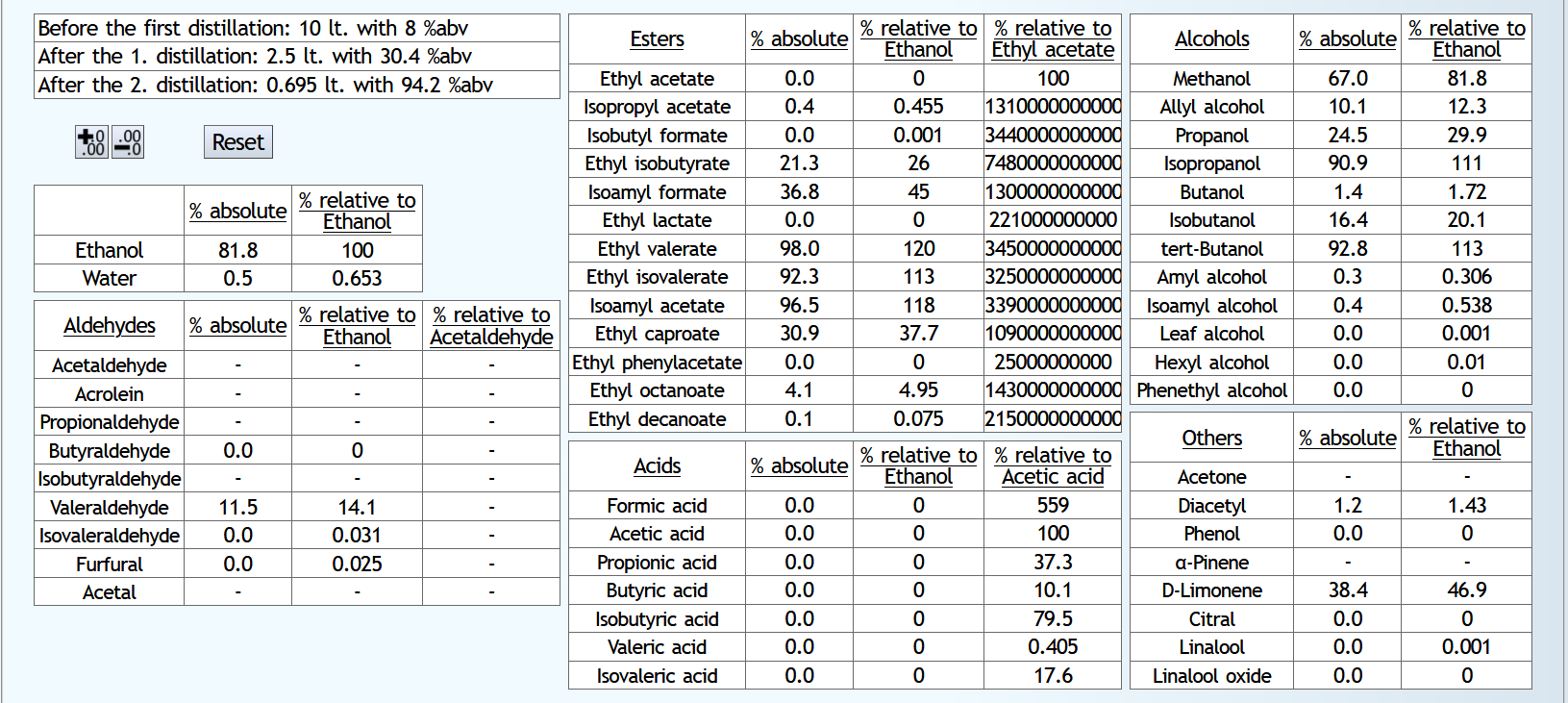 B)
B)
Stripping run: to 2.5lt with 1.1 theor. plates. Then 2.5lt of water added.
Spirit run: 0.03lt foreshots with 6 theor. plates. Then hearts until 90% of the alcohol is distilled; also with 6 theor. plates.
The calculation result for the hearts: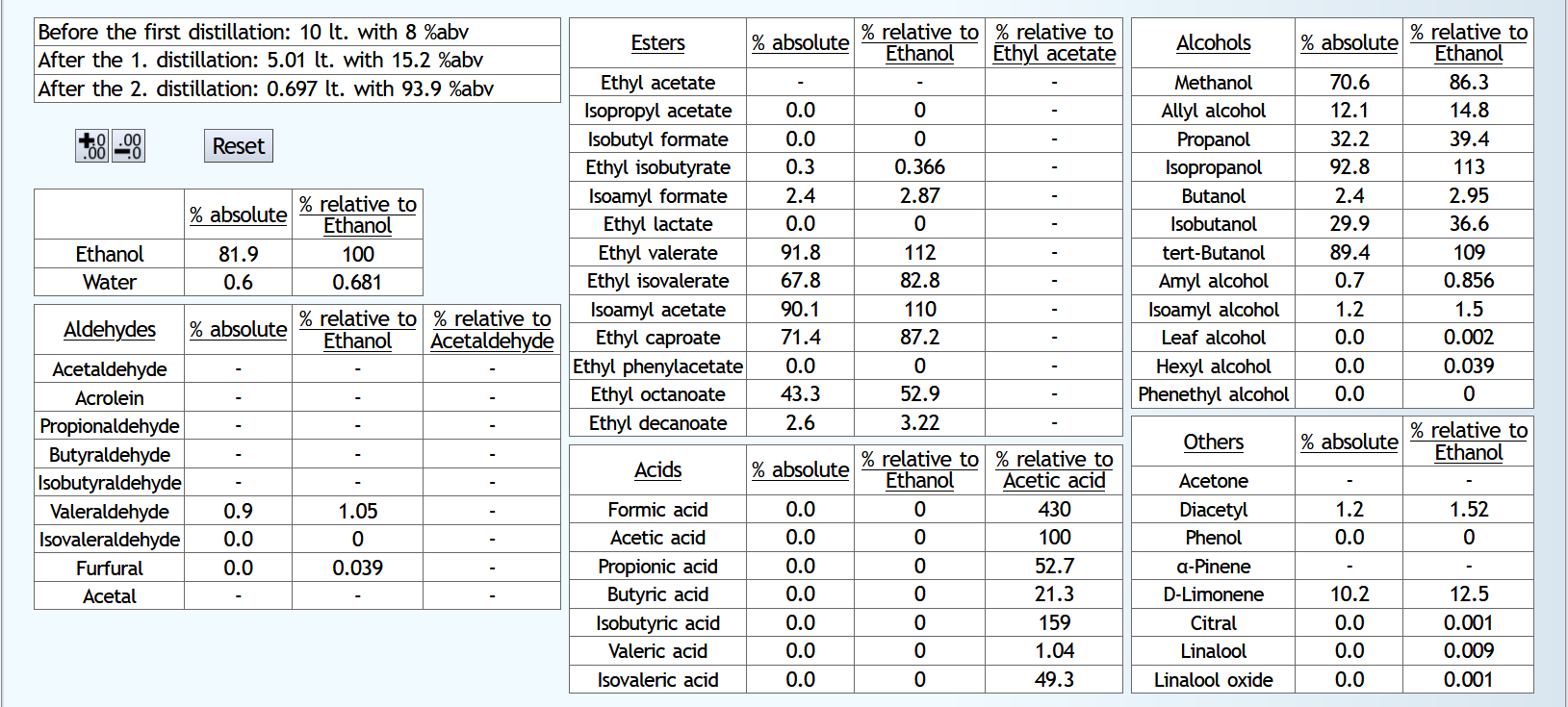 With water, the aldehydes are cut slightly better.
With water, there are much fewer low esters in the hearts, but more of the better ones in some cases.
This shows that the very small foreshots cut is not sufficient.
Without water, the higher alcohols are somewhat better suppressed.
But in general, we see here that 6 theor. plates are not sufficient to cut the higher alcohols.
Among the "other congeners", D-limonene stands out, which was strongly pushed into the foreshots by dilution.
But as with the esters, it simply needs a larger foreshots cut here.
With water, the aldehydes are cut slightly better.
With water, there are much fewer low esters in the hearts, but more of the better ones in some cases.
This shows that the very small foreshots cut is not sufficient.
Without water, the higher alcohols are somewhat better suppressed.
But in general, we see here that 6 theor. plates are not sufficient to cut the higher alcohols.
Among the "other congeners", D-limonene stands out, which was strongly pushed into the foreshots by dilution.
But as with the esters, it simply needs a larger foreshots cut here.
Conclusion: Diluting is more neutral and better in terms of odor. But the distillation costs a bit more energy and, of course, a larger boiler for the same amount of alcohol. So you can consider to fill up unnecessary empty space of the boiler with water always for neutral spirit runs.
10lt with 8%abv.
To get a clear result, only a small amount of foreshots is cut, not too much rectification is used and the hearts end is quite late.
A)
Stripping run: up to 2.5lt with 1.1 theor. plates.
Spirit run: 0.03lt foreshots with 6 theor. plates. Then hearts until 90% of the alcohol is distilled; also with 6 theor. plates.
The calculation result for the hearts:

Stripping run: to 2.5lt with 1.1 theor. plates. Then 2.5lt of water added.
Spirit run: 0.03lt foreshots with 6 theor. plates. Then hearts until 90% of the alcohol is distilled; also with 6 theor. plates.
The calculation result for the hearts:

Conclusion: Diluting is more neutral and better in terms of odor. But the distillation costs a bit more energy and, of course, a larger boiler for the same amount of alcohol. So you can consider to fill up unnecessary empty space of the boiler with water always for neutral spirit runs.
Turbo single distillation vs. Turbo double distillation
High abv washes can theoretically be distilled to a good alcohol strength with just a single potstill distillation.
A double distillation is actually not absolutely necessary for this.
The following examples are calculated with Congeners Simulator 2.
10l at 19%abv:
A) Single distillation:
Foreshots 0.1lt with 1.5 theor. plates, then hearts to 91°C in vapor with 1.2 theor. plates. Up to 91°C because that is the most commonly cited cut point in the literature for Turbo single distillations. The hearts data: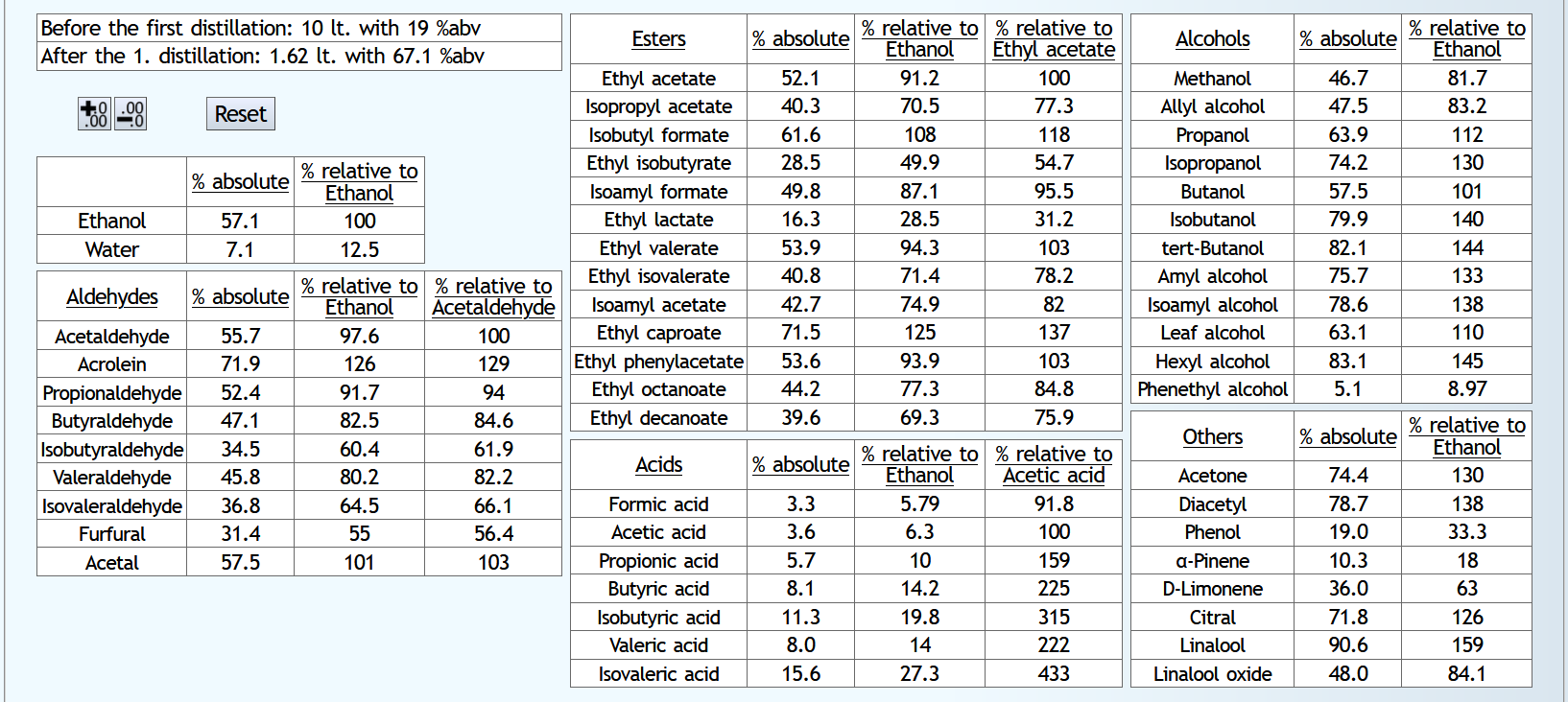 B) Double distillation:
B) Double distillation:
Stripping run to 3.5lt distillate with 1.1 theor. plates.
Spirit run, foreshots 0.08lt with 1.5 theor. plates, then hearts down to current 74%abv with 1.2 theor. plates. Hearts data: The double distillation has 72% ethanol yield instead of 57%.
The double distillation has slightly more aldehydes, and from the good ones.
However, in relation to its high ethanol yield, there are slightly fewer aldehydes overall.
It is similar with the esters.
The double distillation is somewhat more ester-heavy overall, and less aldehyde-heavy.
The single distilled spirit has many more acids, so it is much more harsh on the tongue.
The double distillation has more higher alcohols, but somewhat less in relation to the higher ethanol yield.
The double distillation has 72% ethanol yield instead of 57%.
The double distillation has slightly more aldehydes, and from the good ones.
However, in relation to its high ethanol yield, there are slightly fewer aldehydes overall.
It is similar with the esters.
The double distillation is somewhat more ester-heavy overall, and less aldehyde-heavy.
The single distilled spirit has many more acids, so it is much more harsh on the tongue.
The double distillation has more higher alcohols, but somewhat less in relation to the higher ethanol yield.
Conclusion: Due to the very different ethanol yields, the two distillations are very difficult to compare. By discarding so much ethanol in the single distillation, the volatile flavors are spread over less alcohol. However, its acidity is very high, which makes it harsh. In addition, the ratio of good to bad congeners within a substance group is in most cases better in double distillation.
If, in order to increase the yield in the single distillation, you finish the hearts later, you lose the advantage of the single distillation that the flavors are distributed on less alcohol, and more and more acids come. So its low yield saves the single distillation. Without sacrificing that high amount of alcohol, you lose quality.
Now, with the double distillation, you might think that you shouldn't have such a high %abv in the boiler for the spirit run. For that, you either have to dilute between distillations or extend the stripping run.
C) Double distillation as B, but 1lt of water added between the distillations and in the case of the spirit run, because of the lower alcohol content in the boiler, only finish the hearts at current 68%abv. The data of the hearts: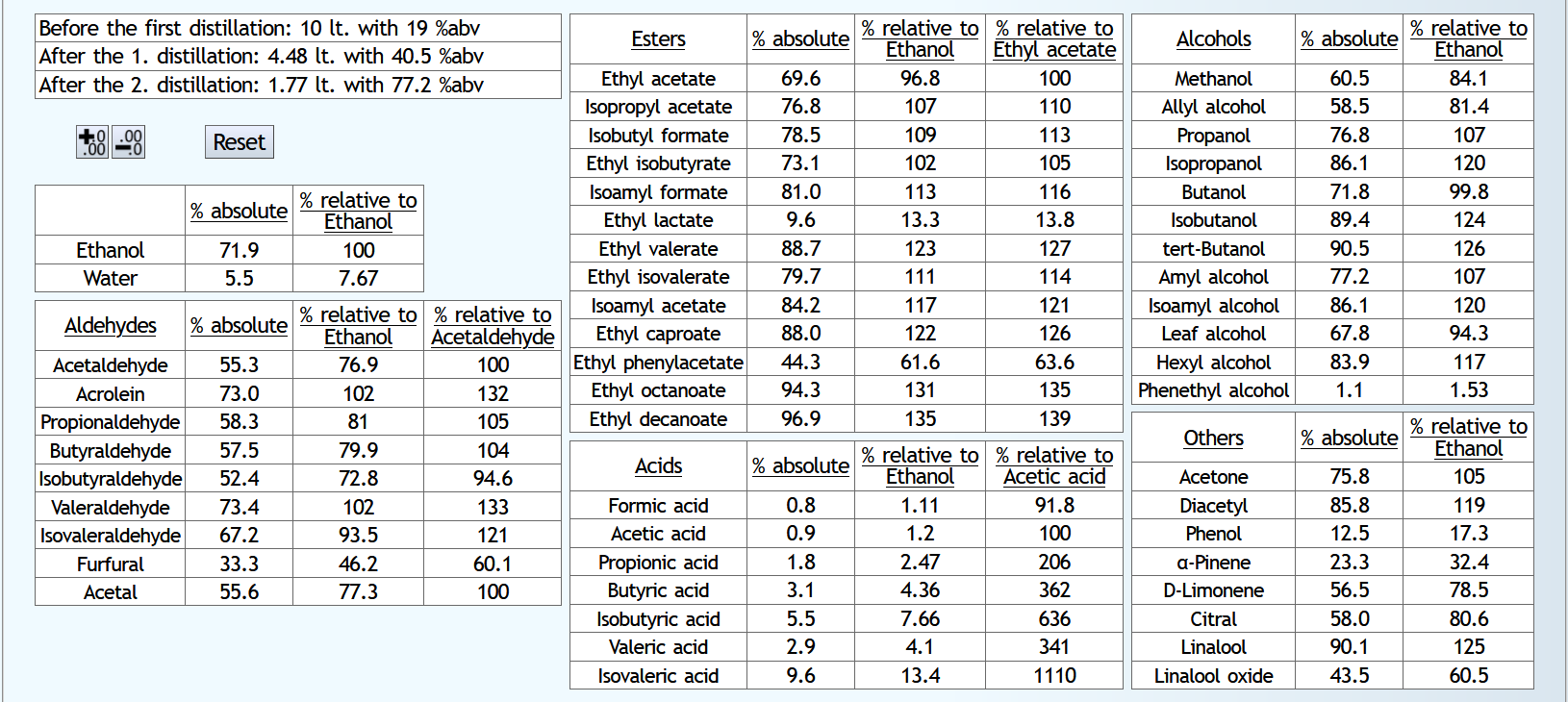 This is slightly worse for the aldehydes and alcohols, and slightly better for the esters.
And has a slightly lower ethanol yield.
It looks worse for the acids, but is actually slightly better for the most important acid, acetic acid.
This is slightly worse for the aldehydes and alcohols, and slightly better for the esters.
And has a slightly lower ethanol yield.
It looks worse for the acids, but is actually slightly better for the most important acid, acetic acid.
D) Double distillation like C, but instead of adding 1lt of water, 1lt more is distilled during the first distillation and the hearts are finished at 70%abv because of the slightly higher alcohol content in the boiler. The data of the hearts: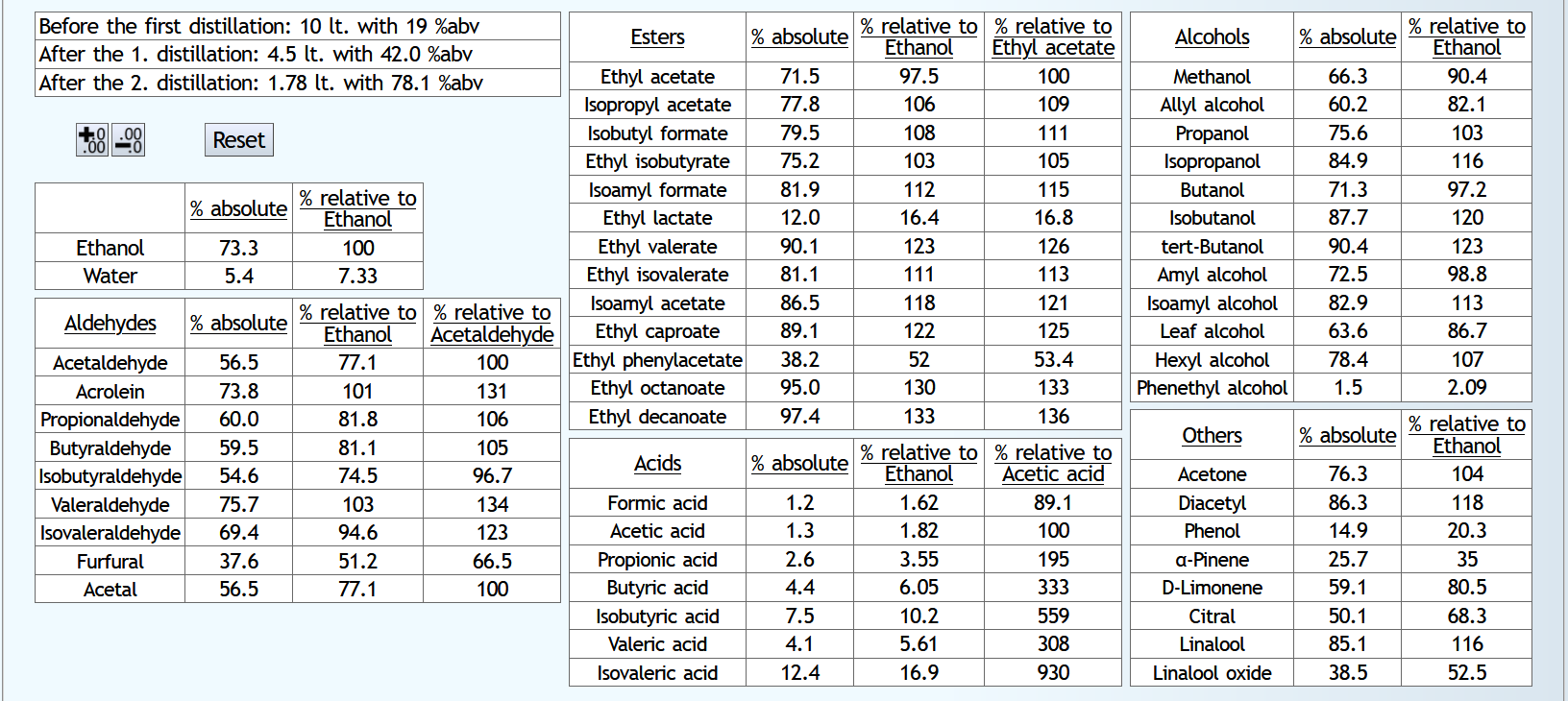 D, of course, has more congeners than C.
With the typical foreshots congeners, this is hardly noticeable.
However, the extended stripping run of D brings much more acids.
That's why it will taste less smooth than C diluted with water.
D, of course, has more congeners than C.
With the typical foreshots congeners, this is hardly noticeable.
However, the extended stripping run of D brings much more acids.
That's why it will taste less smooth than C diluted with water.
The two best versions, B and C, are quite similar.
Overall conclusion: the single distillation looks very bad in acids and hearts yield. But the poor ethanol yield saves it to some extent. If you increase the yield, it becomes acidic. With the double distillation, distilling the stripping run down extremely far to avoid having too high %abv in the boiler during the spirit run is a poor recommendation. Distilling less far down and then distilling again either diluted or undiluted is both better.
The following examples are calculated with Congeners Simulator 2.
10l at 19%abv:
A) Single distillation:
Foreshots 0.1lt with 1.5 theor. plates, then hearts to 91°C in vapor with 1.2 theor. plates. Up to 91°C because that is the most commonly cited cut point in the literature for Turbo single distillations. The hearts data:

Stripping run to 3.5lt distillate with 1.1 theor. plates.
Spirit run, foreshots 0.08lt with 1.5 theor. plates, then hearts down to current 74%abv with 1.2 theor. plates. Hearts data:

Conclusion: Due to the very different ethanol yields, the two distillations are very difficult to compare. By discarding so much ethanol in the single distillation, the volatile flavors are spread over less alcohol. However, its acidity is very high, which makes it harsh. In addition, the ratio of good to bad congeners within a substance group is in most cases better in double distillation.
If, in order to increase the yield in the single distillation, you finish the hearts later, you lose the advantage of the single distillation that the flavors are distributed on less alcohol, and more and more acids come. So its low yield saves the single distillation. Without sacrificing that high amount of alcohol, you lose quality.
Now, with the double distillation, you might think that you shouldn't have such a high %abv in the boiler for the spirit run. For that, you either have to dilute between distillations or extend the stripping run.
C) Double distillation as B, but 1lt of water added between the distillations and in the case of the spirit run, because of the lower alcohol content in the boiler, only finish the hearts at current 68%abv. The data of the hearts:

D) Double distillation like C, but instead of adding 1lt of water, 1lt more is distilled during the first distillation and the hearts are finished at 70%abv because of the slightly higher alcohol content in the boiler. The data of the hearts:

The two best versions, B and C, are quite similar.
Overall conclusion: the single distillation looks very bad in acids and hearts yield. But the poor ethanol yield saves it to some extent. If you increase the yield, it becomes acidic. With the double distillation, distilling the stripping run down extremely far to avoid having too high %abv in the boiler during the spirit run is a poor recommendation. Distilling less far down and then distilling again either diluted or undiluted is both better.
Triple distillation instead of double distillation?
The following examples is calculated with the Congeners Simulator 2.
First a wash with very low alcohol content. 10lt wash with 5%abv:
A) Double distillation:
Stripping run: 2lt with 1.1theor. plates.
Spirit run: 0.03lt foreshots with 1.5 theor. plates. Hearts with 1.2 theor. plates down to current 55%abv.
The data of the hearts: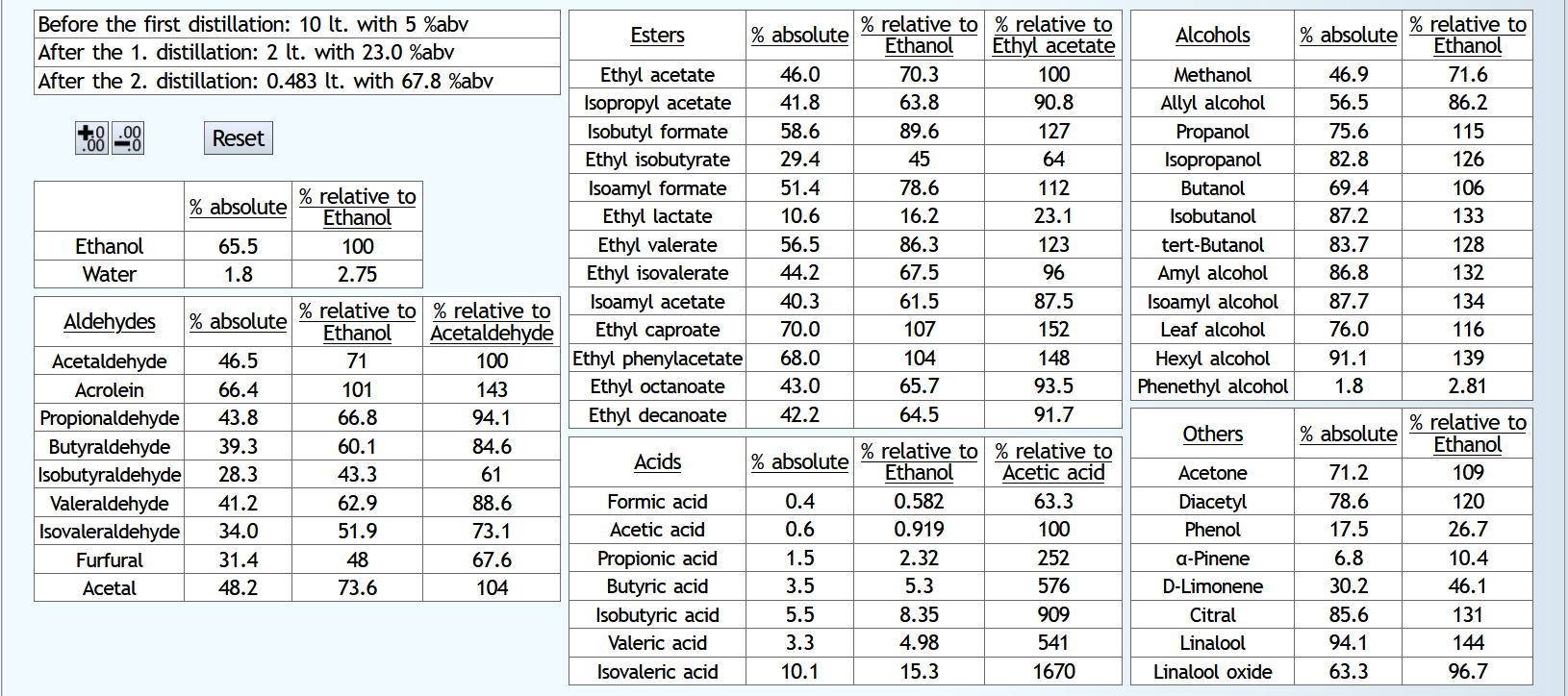 B) Triple distillation:
B) Triple distillation:
Stripping run: 3lt with 1.1 theor. plates.
Mid distillation: 1.5lt with 1.1 theor. plates.
Spirit run: 0.03lt foreshots with 1.5 theor. plates. Hearts with 1.2 theor. plates down to current 65%abv.
The data of the hearts: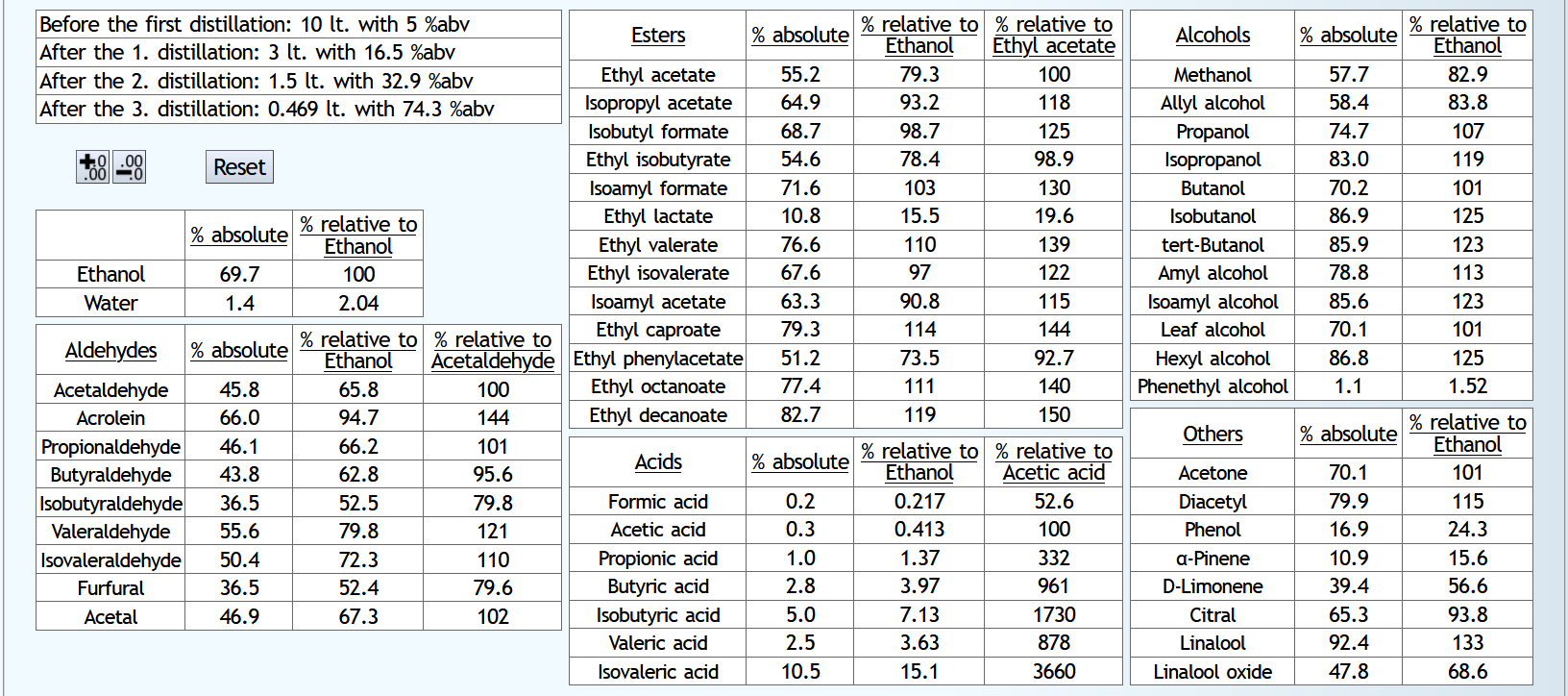 Ethanol yield is slightly higher with triple distillation, 70 instead of 65%.
The foreshots cut is slightly more effective with the double distillation;
more aldehydes and esters were cut.
However, mainly from the good ones.
Higher alcohols are minimally less in the double distillation.
In the triple distillation, significantly more acids were cut.
It is differing for the "other congeners".
Ethanol yield is slightly higher with triple distillation, 70 instead of 65%.
The foreshots cut is slightly more effective with the double distillation;
more aldehydes and esters were cut.
However, mainly from the good ones.
Higher alcohols are minimally less in the double distillation.
In the triple distillation, significantly more acids were cut.
It is differing for the "other congeners".
Because of the reduced acids and the better ratio of good to bad aldehydes respectively good to bad esters, the triple distillation is therefore better.
But is this also the case with higher percentage wash?
10lt wash with 12%abv:
C) Double distillation:
Stripping run: 3.3lt with 1.1 theor. plates.
Spirit run: 0.05lt foreshots with 1.5 theor. plates. Hearts with 1.2 theor. plates down to current 66%abv.
The data of the hearts: D) Triple distillation:
D) Triple distillation:
Stripping run: 4lt with 1.1 theor. plates.
Mid distillation: 2.5lt with 1.1 theor. plates.
Spirit run: foreshots 0.05lt with 1.5 theor. plates. Hearts with 1.2 theor. plates down to current 72%abv.
The data of the hearts: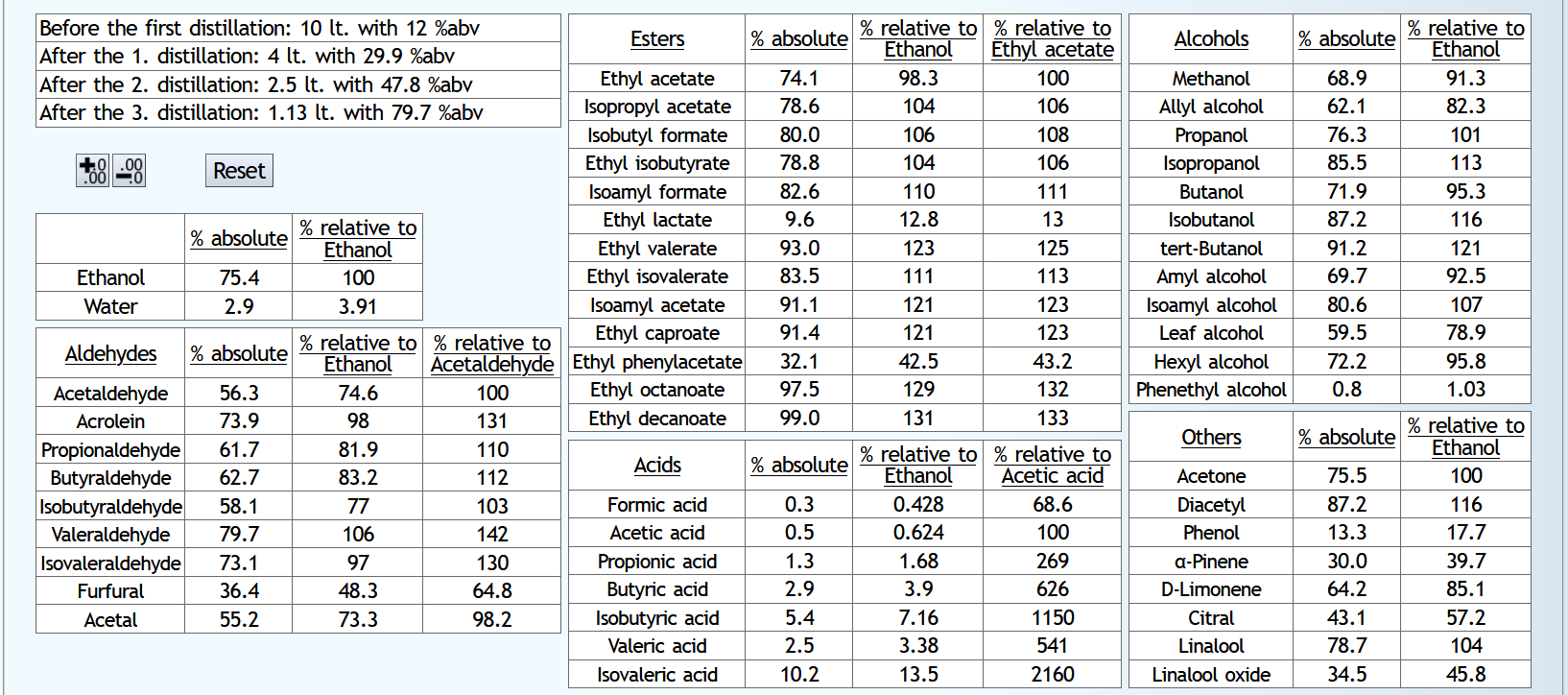 The results are similar to low alcohol content.
For the esters, most of the advantage of triple distillation has disappeared.
For the acids, the difference has perhaps become slightly greater.
So the triple distillation looks better than the double distillation even with higher percentage washes.
But it's no longer as readily apparent.
The results are similar to low alcohol content.
For the esters, most of the advantage of triple distillation has disappeared.
For the acids, the difference has perhaps become slightly greater.
So the triple distillation looks better than the double distillation even with higher percentage washes.
But it's no longer as readily apparent.
I wonder if the double distillation will have an advantage at some point if you keep increasing the %abv in the wash?
10lt wash with 19%abv:
E) Double distillation:
Stripping run: 3.5lt with 1.1 theor. plates.
Spirit run: foreshots 0.08lt with 1.5 theor. plates. Hearts with 1.2 theor. plates down to current 72%abv.
The data of the hearts: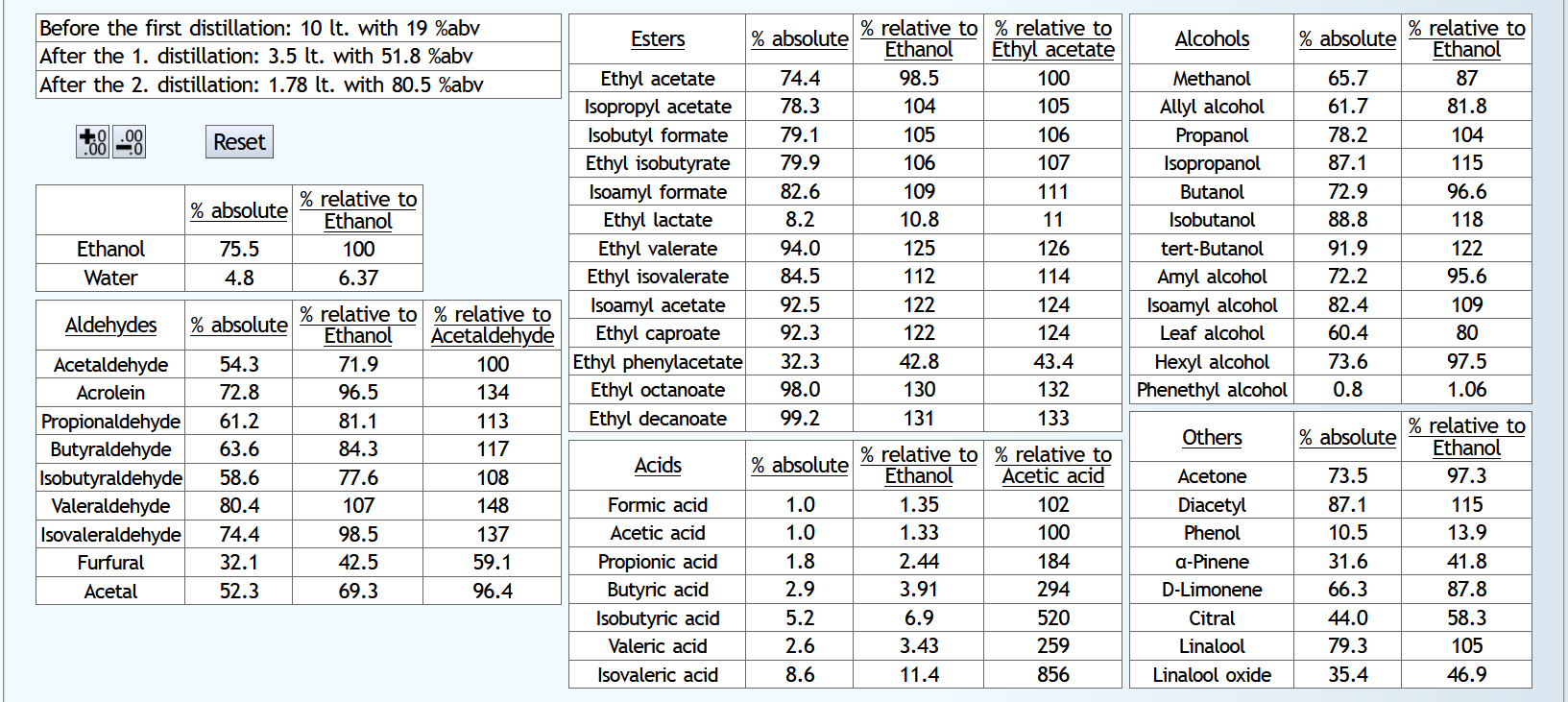 F) Triple distillation:
F) Triple distillation:
Stripping run: 4lt with 1.1 theor. plates.
Mid distillation: 3lt with 1.1 theor. plates.
Spirit run: foreshots 0.08lt with 1.5 theor. plates. Hearts with 1.2 theor. plates down to current 78%abv.
The data of the hearts: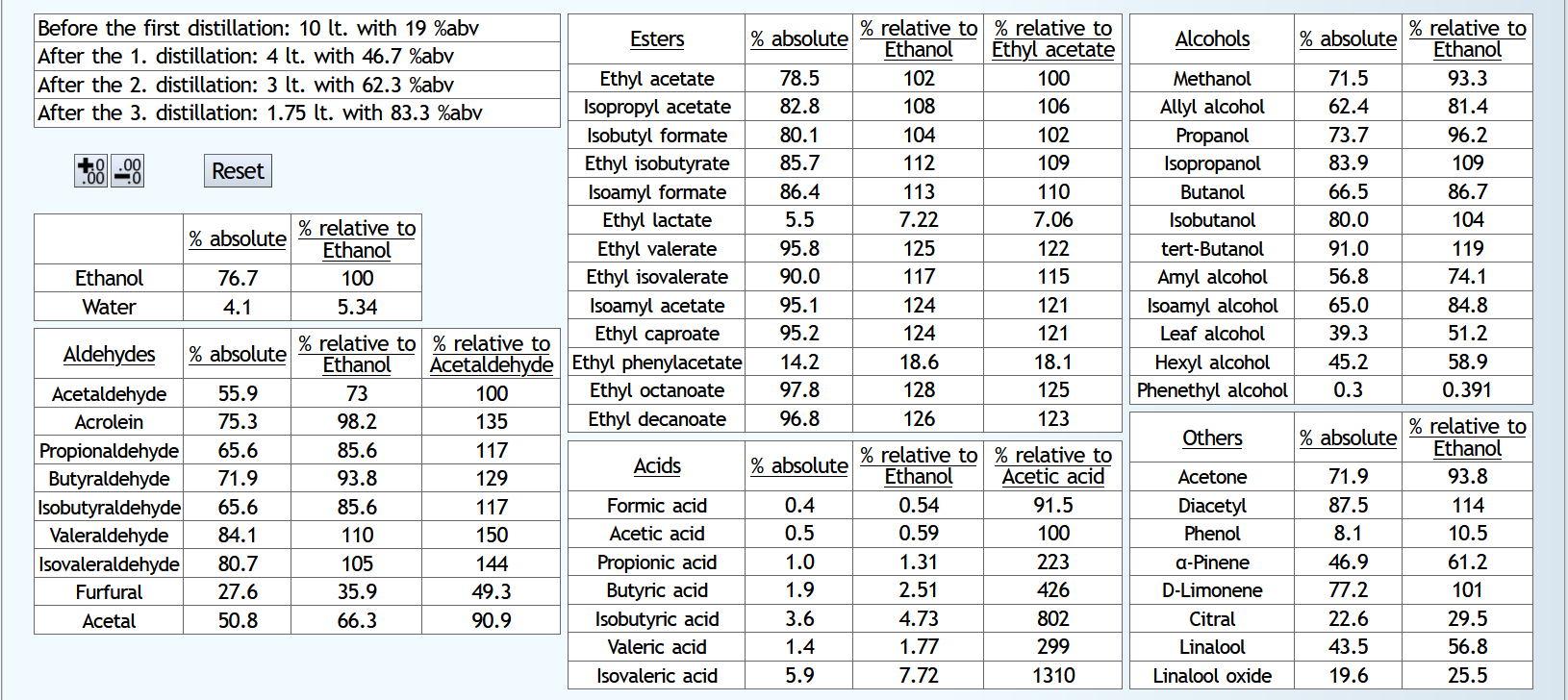 The triple distillation has only a minimal advantage with the aldehydes.
With the esters, it begins to deteriorate in quality.
With the cut of the higher alcohols it becomes better than the double distillation.
With the acids, it is still much better.
The triple distillation has only a minimal advantage with the aldehydes.
With the esters, it begins to deteriorate in quality.
With the cut of the higher alcohols it becomes better than the double distillation.
With the acids, it is still much better.
Conclusion: it looks like the triple distillation is better most of the time. However, its advantage disappears the more alcoholic the wash is. With very low-percentage wash, it has a clear advantage; with turbo wash, it's probably also a matter of taste.
First a wash with very low alcohol content. 10lt wash with 5%abv:
A) Double distillation:
Stripping run: 2lt with 1.1theor. plates.
Spirit run: 0.03lt foreshots with 1.5 theor. plates. Hearts with 1.2 theor. plates down to current 55%abv.
The data of the hearts:

Stripping run: 3lt with 1.1 theor. plates.
Mid distillation: 1.5lt with 1.1 theor. plates.
Spirit run: 0.03lt foreshots with 1.5 theor. plates. Hearts with 1.2 theor. plates down to current 65%abv.
The data of the hearts:

Because of the reduced acids and the better ratio of good to bad aldehydes respectively good to bad esters, the triple distillation is therefore better.
But is this also the case with higher percentage wash?
10lt wash with 12%abv:
C) Double distillation:
Stripping run: 3.3lt with 1.1 theor. plates.
Spirit run: 0.05lt foreshots with 1.5 theor. plates. Hearts with 1.2 theor. plates down to current 66%abv.
The data of the hearts:

Stripping run: 4lt with 1.1 theor. plates.
Mid distillation: 2.5lt with 1.1 theor. plates.
Spirit run: foreshots 0.05lt with 1.5 theor. plates. Hearts with 1.2 theor. plates down to current 72%abv.
The data of the hearts:

I wonder if the double distillation will have an advantage at some point if you keep increasing the %abv in the wash?
10lt wash with 19%abv:
E) Double distillation:
Stripping run: 3.5lt with 1.1 theor. plates.
Spirit run: foreshots 0.08lt with 1.5 theor. plates. Hearts with 1.2 theor. plates down to current 72%abv.
The data of the hearts:

Stripping run: 4lt with 1.1 theor. plates.
Mid distillation: 3lt with 1.1 theor. plates.
Spirit run: foreshots 0.08lt with 1.5 theor. plates. Hearts with 1.2 theor. plates down to current 78%abv.
The data of the hearts:

Conclusion: it looks like the triple distillation is better most of the time. However, its advantage disappears the more alcoholic the wash is. With very low-percentage wash, it has a clear advantage; with turbo wash, it's probably also a matter of taste.
Double distillation with potstill or single distillation with reflux still?
The following examples are calculated with the Congeners Simulator 2.
This comparison is difficult to make fairly. Because if you do a single distillation with a reflux still, you will probably cut the foreshots with a lot of reflux. But you don't have that option with a normal potstill. For a comparison, it is more interesting if the reflux still first does without this option for a test, even if this does not correspond to reality for the time being:
10lt wash with 10%abv:
A) Potstill double distillation:
Stripping run: 3lt with 1.1 theor. plates.
Spirit run: foreshots 0.05lt with 1.5 theor. plates. Hearts down to current 65%abv with 1.2 theor. plates.
The data of the hearts: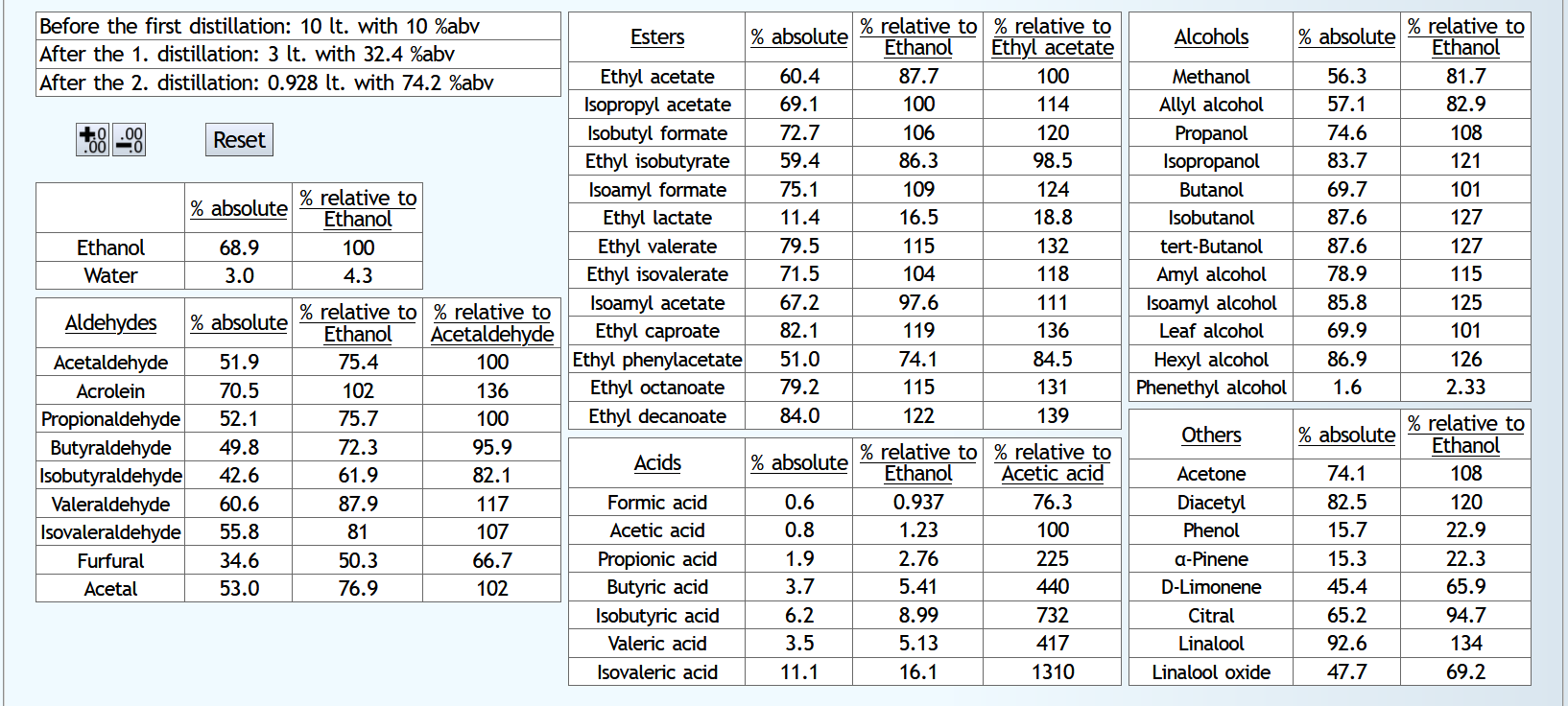 B) Reflux single distillation:
B) Reflux single distillation:
0.05lt foreshots with 1.5 theor. plates and then try not to let the alcohol content drop below 70%abv until the hearts have the same yield as that from the Potstill double distillation. This is the protocol: And here is the data from the hearts:
And here is the data from the hearts:
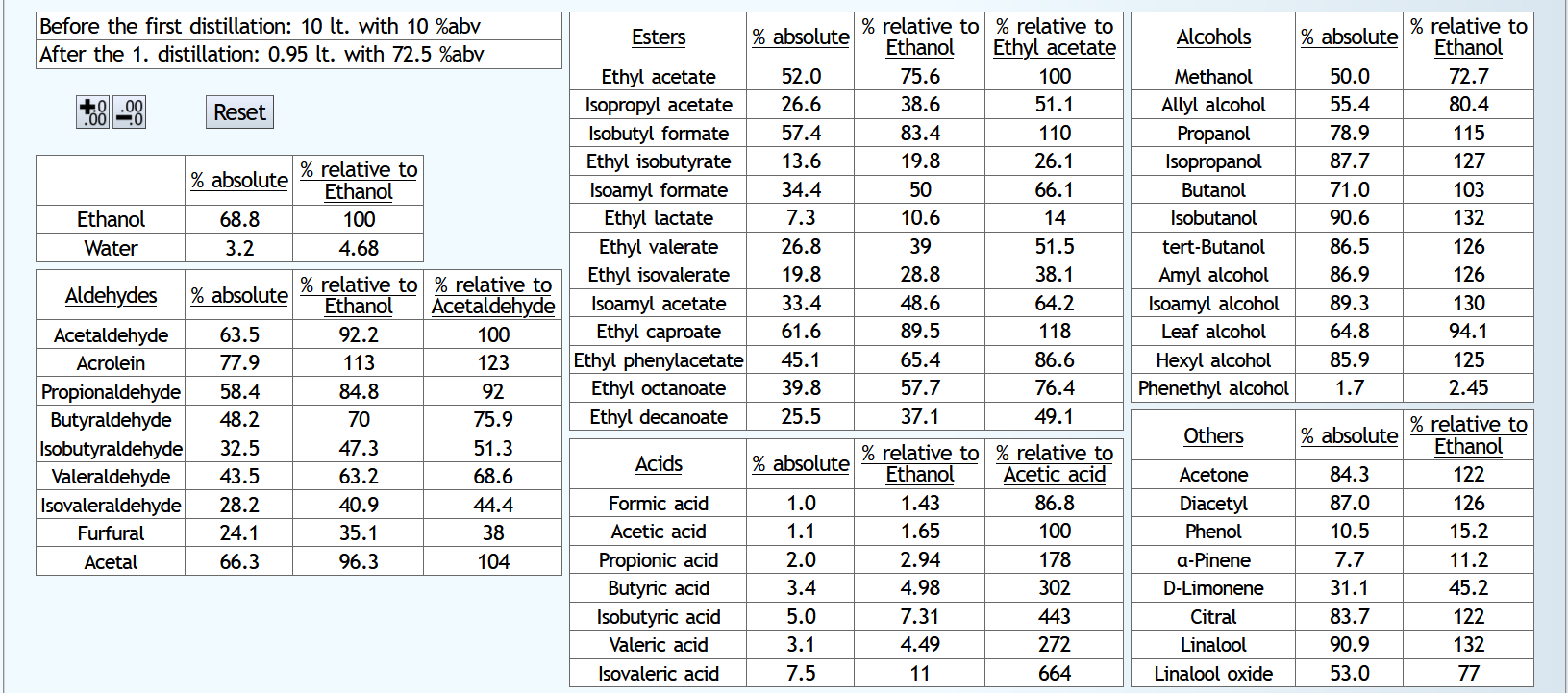 The double distillation has more good and less bad aldehydes.
It has more esters, also of the bad ones, but mostly of the good ones.
It has less acetic acid, but more of the larger acids.
Since acetic acid makes up the biggest share of the acids, it is somewhat softer.
So the double distillation has qualitative merits, but probably needs a slightly more generous foreshots cut to separate more of the bad small aldehydes and esters.
The double distillation has more good and less bad aldehydes.
It has more esters, also of the bad ones, but mostly of the good ones.
It has less acetic acid, but more of the larger acids.
Since acetic acid makes up the biggest share of the acids, it is somewhat softer.
So the double distillation has qualitative merits, but probably needs a slightly more generous foreshots cut to separate more of the bad small aldehydes and esters.
But, after all, this comparison was unfair because the reflux still gave up its ability to rectify the foreshots. If one would rectify the foreshots, they would be cut more efficiently and with better taste. So the bad aldehydes and esters would be cut more and the better ones less. You'd have a bit more higher alcohols in the hearts, though, since none would be cut with the foreshots if you rectified it. And the problem of reflux single distillations with the acids would remain anyway.
Conclusion: The best is therefore the mixture: a potstill double distillation with rectification of the foreshots.
This comparison is difficult to make fairly. Because if you do a single distillation with a reflux still, you will probably cut the foreshots with a lot of reflux. But you don't have that option with a normal potstill. For a comparison, it is more interesting if the reflux still first does without this option for a test, even if this does not correspond to reality for the time being:
10lt wash with 10%abv:
A) Potstill double distillation:
Stripping run: 3lt with 1.1 theor. plates.
Spirit run: foreshots 0.05lt with 1.5 theor. plates. Hearts down to current 65%abv with 1.2 theor. plates.
The data of the hearts:

0.05lt foreshots with 1.5 theor. plates and then try not to let the alcohol content drop below 70%abv until the hearts have the same yield as that from the Potstill double distillation. This is the protocol:


But, after all, this comparison was unfair because the reflux still gave up its ability to rectify the foreshots. If one would rectify the foreshots, they would be cut more efficiently and with better taste. So the bad aldehydes and esters would be cut more and the better ones less. You'd have a bit more higher alcohols in the hearts, though, since none would be cut with the foreshots if you rectified it. And the problem of reflux single distillations with the acids would remain anyway.
Conclusion: The best is therefore the mixture: a potstill double distillation with rectification of the foreshots.
Triple distillation without rectification or double distillation with rectification during the stripping run?
If the double distillation with rectification during the stripping run is as good as the triple distillation without rectification, some time and energy could be saved.
The following examples are calculated with the Congeners Simulator 2.
10lt wash with 8%abv:
A) Triple distillation:
Stripping run: 3lt with 1.1 theor. plates.
Mid distillation: 1.5lt with 1.1 theor. plates.
Mid distillation data: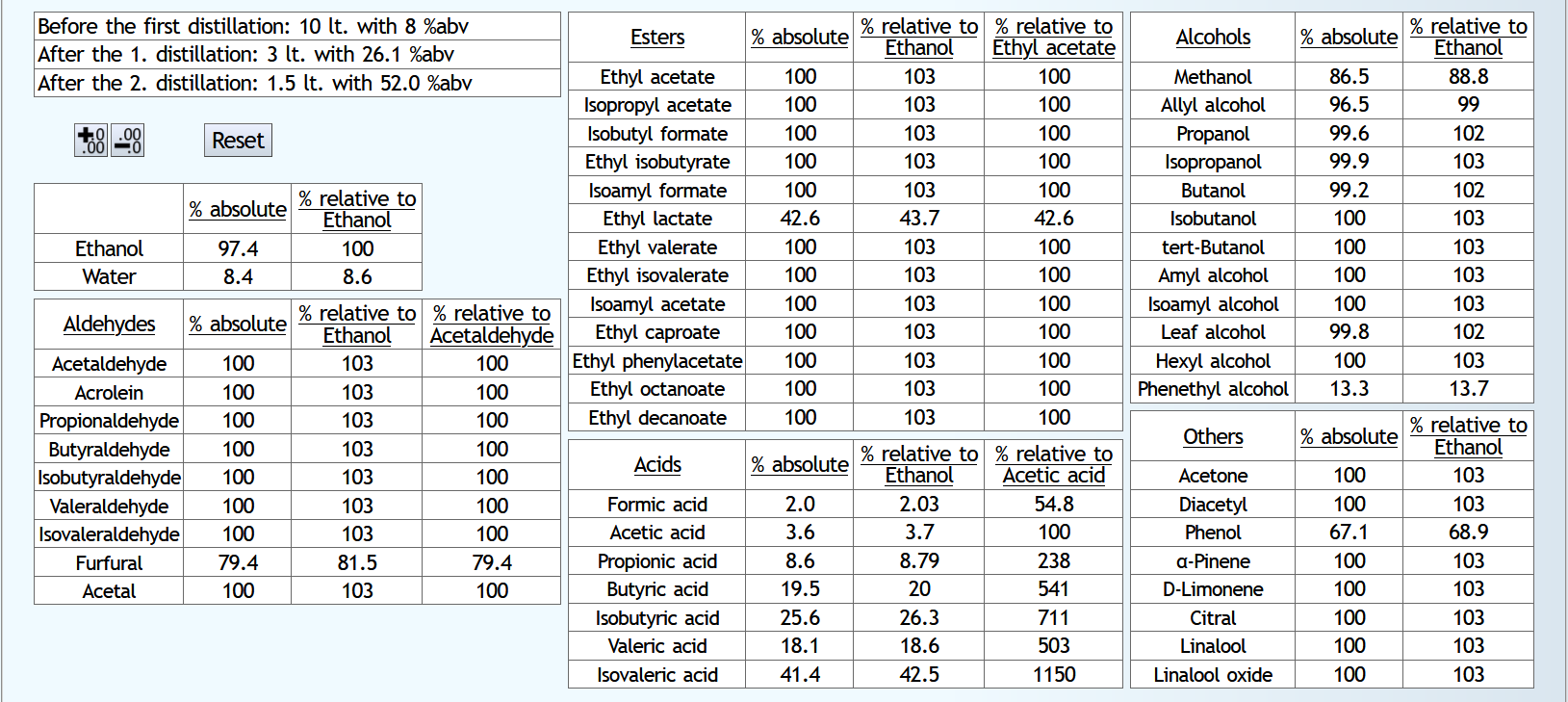 Results in 1.5lt with 52%abv.
Results in 1.5lt with 52%abv.
B) Double distillation:
Reflux stripping run to also 1.5lt 52%abv. This requires 1.565 theor. plates.
The data of the reflux stripping run: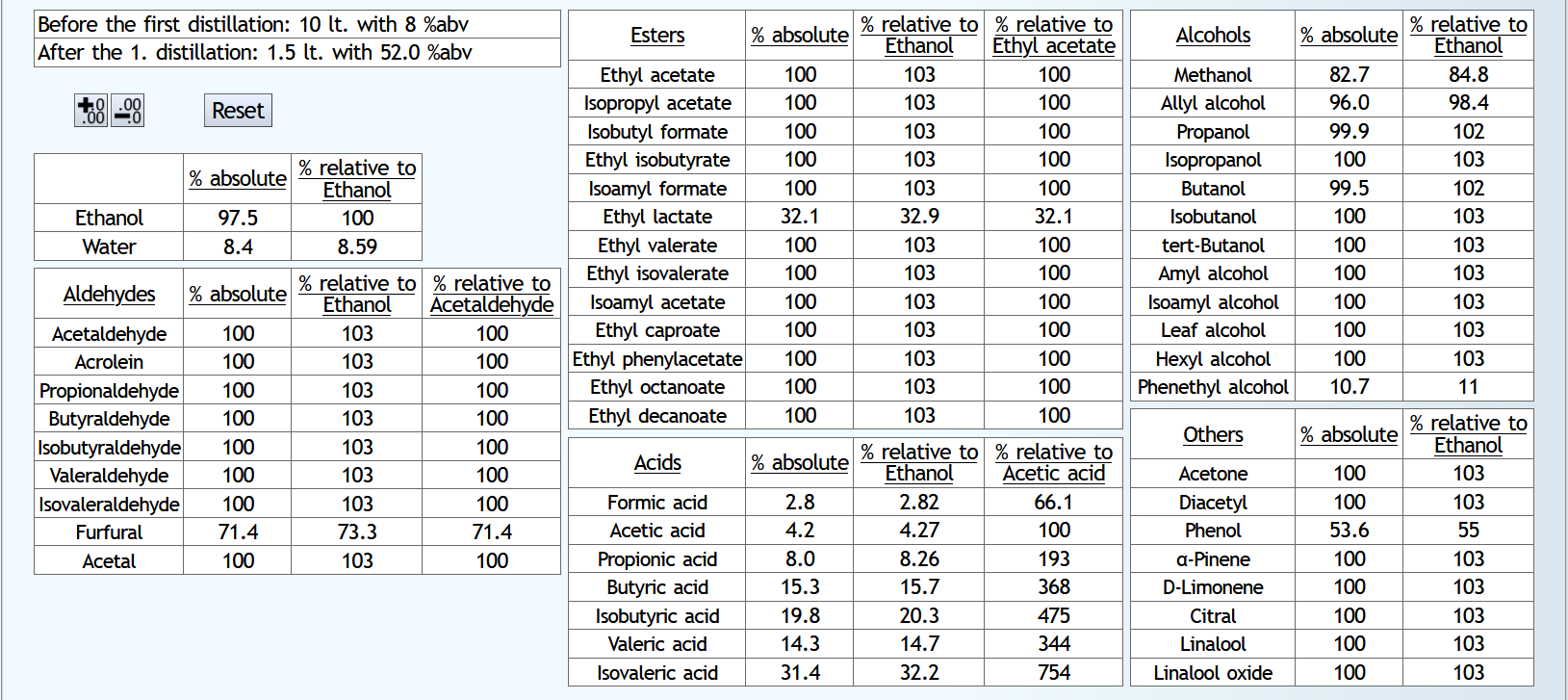 In both versions, just about all the aldehydes, esters, alcohols and others are in the distillate.
A bit more complete in the double distillation, which tends to look a bit better.
But there are big differences in the acids.
The double distillation suppresses the acetic acid and formic acid better, the single distillation rather the larger acids.
Since acetic acid is by far the most common, the double distillation will be a bit smoother.
It also has more of the interesting acids with higher potential, which might then form valuable esters in the spirit run.
In both versions, just about all the aldehydes, esters, alcohols and others are in the distillate.
A bit more complete in the double distillation, which tends to look a bit better.
But there are big differences in the acids.
The double distillation suppresses the acetic acid and formic acid better, the single distillation rather the larger acids.
Since acetic acid is by far the most common, the double distillation will be a bit smoother.
It also has more of the interesting acids with higher potential, which might then form valuable esters in the spirit run.
Now, you could also do the reflux distillation with increasing reflux, so never let the alcohol strength fall below a certain point.
C) Double distillation with rising rectification:
Here is the protocol:
 So, the alcohol strength should not go below 40%abv, and in the end not even below 45%abv.
Because of the comparability, the same alcohol strength and distillate quantity as in A and B should be achieved.
So, the alcohol strength should not go below 40%abv, and in the end not even below 45%abv.
Because of the comparability, the same alcohol strength and distillate quantity as in A and B should be achieved.
The final result: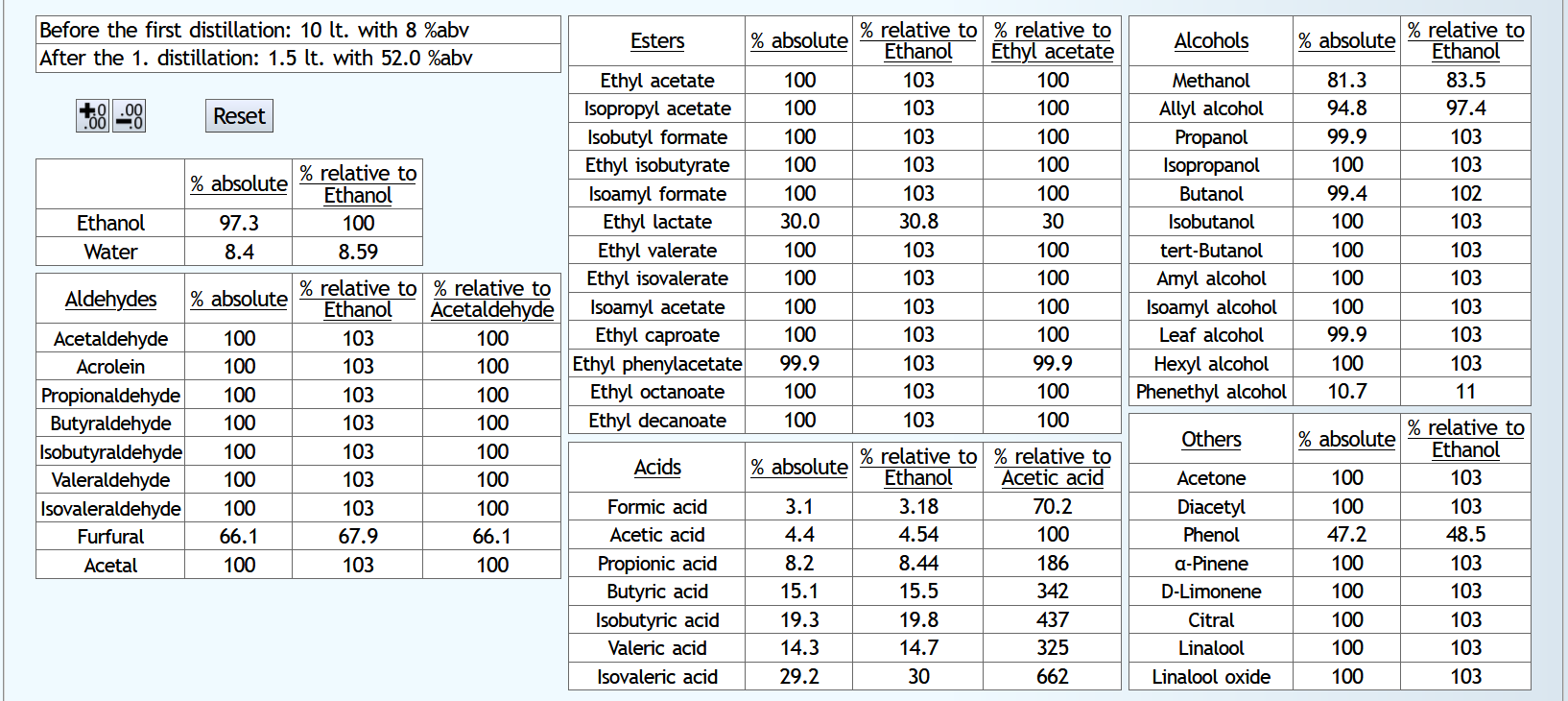 So if you find B worse than A (which is likely), you will find C even worse.
All the points criticized on B are still slightly worse on C.
So if you find B worse than A (which is likely), you will find C even worse.
All the points criticized on B are still slightly worse on C.
Conclusion: Replacing a stripping run and mid distillation both unrectified with a reflux stripping run means a loss of quality.
The following examples are calculated with the Congeners Simulator 2.
10lt wash with 8%abv:
A) Triple distillation:
Stripping run: 3lt with 1.1 theor. plates.
Mid distillation: 1.5lt with 1.1 theor. plates.
Mid distillation data:

B) Double distillation:
Reflux stripping run to also 1.5lt 52%abv. This requires 1.565 theor. plates.
The data of the reflux stripping run:

Now, you could also do the reflux distillation with increasing reflux, so never let the alcohol strength fall below a certain point.
C) Double distillation with rising rectification:
Here is the protocol:

The final result:

Conclusion: Replacing a stripping run and mid distillation both unrectified with a reflux stripping run means a loss of quality.
Here is the complete list of our sources
- "From pot stills to continuous stills: flavor modification by distillation" by Robert Piggot. Published in "The Alcohol Textbook", chapter 17
- "Whisky Technology, Production and Marketing", original by Panek and Boucher, probably "Continuous distillation", published probably as well in "The Science and Technology of Whiskies" by J.R.Piggott, Longman Scientific and Technical
- "Chemical aspects of distilling wines into brandy" by J.F. Guymon, 1973, published in "Chemistry of Winemaking"; Webb, A.; Advances in Chemistry; American Chemical Society: Washington, DC, 1974
- "Computer simulation applied to studying continuous spirit distillation and product quality control" by Fabio R.M. Batista, Antonio J.A. Meirelles, Food Control 22 (2011) 1592-1603
- "Vapor-liquid equilibria of organic homologues in ethanol-water solutions" by C.Williams
- "A quick method for obtaining partition factor of congeners in spirits" by A.Martin
- "Vapor-Liquid Equilibria Measurements of Bitter Orange Aroma Compounds Highly Diluted in Boiling Hydro-Alcoholic Solutions at 101.3 kPa" by S.Deterre
- "Distillation principles and processes" by S.Young, p.308
- "Vapor−Liquid Equilibrium of Ethyl Lactate Highly Diluted in Ethanol−Water Mixtures at 101.3 kPa. Experimental Measurements and Thermodynamic Modeling Using Semiempirical Models" by C.Puentes
- "Review and thermodynamic modeling with NRTL model of vapor–liquid equilibria (VLE) of aroma compounds highly diluted in ethanol–water mixtures at 101.3 kPa" by C.Puentes
- "Modélisation des équilibres entre phases et simulation de la distillation des eaux-de-vie en vue d’une meilleure compréhension du comportement des composés volatils d’arôme" by C.Puentes
- "Vapour–liquid equilibria of aroma compounds in hydroalcoholic solutions: Measurements with a recirculation method and modelling with the NRTL and COSMO-SAC approaches" by V.Athes
- "Vapor-Liquid Equilibria of a Minute Amount of n-Propyl, Isobutyl, and Isoamyl Alcohols in Aqueous Ethanol Solution under Reduced Pressure" by A.Ikari
- "Vapor-Liquid Equilibria of a Minute Amount of Methanol, Isovaleraldehyde and Diacetyl in Aqueous Ethanol Solution under Reduced Pressure" by A.Ikari
- "Behavior of a minute amount of furfural in distillation of aqueous ethanol solution under reduced pressure" by A.Ikari
- "Vapor-Liquid Equilibria of Trace Isobutyraldehyde, Ethyl Acetate and Isoamyl Acetate in Aqueous Ethanol Solution under Reduced Pressure" by A.Ikari
- "Review and thermodynamic modeling with NRTL model of vapor–liquid equilibria (VLE) of aroma compounds highly diluted in ethanol–water mixtures at 101.3 kPa" by C.Puentes
The order is random.